Toshiba Client Solutions UPA3490G3 CDMA Cell-PCS Module User Manual PMAD00077012 TecraM7 06Aug12
Toshiba Corporation CDMA Cell-PCS Module PMAD00077012 TecraM7 06Aug12
Contents
- 1. 3G Manual
- 2. Final RF exposure statement
- 3. CRN 30615 Q1 Notebook User Manual
- 4. WWLAN at secondary portrait display mode
- 5. TECRA M7 User Manual
- 6. PA3490U manual addendum
- 7. Revised TecraM7 Manual 1
- 8. Revised TecraM7 Manual 2
- 9. Revised PA3490U addendum
- 10. Wireless WAN Guide
- 11. User Manual
- 12. WWAN Manual
Revised TecraM7 Manual 1
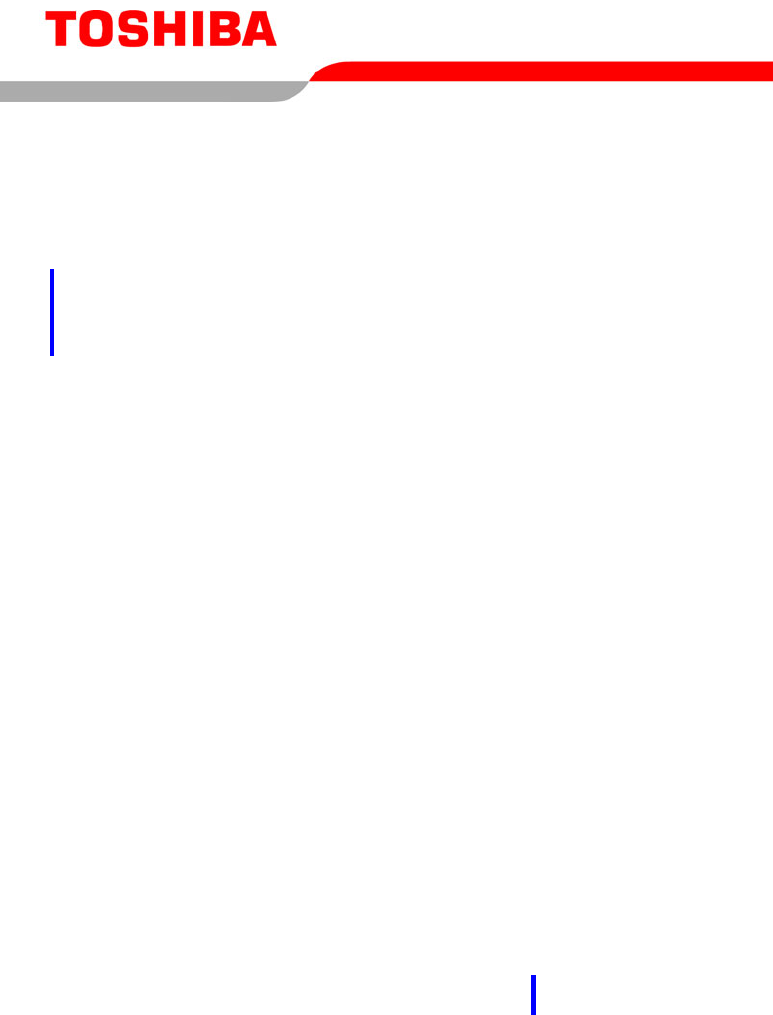
PMAD00077012
08/06
Tecra® M7 Series
User’s Guide
If you need assistance:
❖Toshiba’s Support Web site
pcsupport.toshiba.com
❖Toshiba Global Support Centre
Calling within the United States (800) 457-7777
Calling from outside the United States (949) 859-4273
For more information, see “If Something Goes Wrong” on
page 209 in this guide.

2
5.375 x 8.375 ver 2.3
Handling the cord on this product will expose you to lead, a
chemical known to the State of California to cause birth defects
or other reproductive harm. Wash hands after handling.
Model: Tecra® M7 Series
Recordable and/or ReWritable Drive(s) and
Associated Software Warranty
The computer system you purchased may include Recordable and/or
ReWritable optical media drive(s) and associated software, among the most
advanced data storage technologies available. As with any new technology,
you must read and follow all set-up and usage instructions in the applicable
user guides and/or manuals enclosed or provided electronically. If you fail
to do so, this product may not function properly and you may lose data or
suffer other damage. TOSHIBA AMERICA INFORMATION SYSTEMS,
INC. (“TOSHIBA”), ITS AFFILIATES AND SUPPLIERS DO NOT
WARRANT THAT OPERATION OF THE PRODUCT WILL BE
UNINTERRUPTED OR ERROR FREE. YOU AGREE THAT TOSHIBA,
ITS AFFILIATES AND SUPPLIERS SHALL HAVE NO
RESPONSIBILITY FOR DAMAGE TO OR LOSS OF ANY BUSINESS,
PROFITS, PROGRAMS, DATA, NETWORK SYSTEMS OR
REMOVABLE STORAGE MEDIA ARISING OUT OF OR RESULTING
FROM THE USE OF THE PRODUCT, EVEN IF ADVISED OF THE
POSSIBILITY THEREOF.
Protection of Stored Data
For your important data, please make periodic back-up copies of all the data
stored on the hard disk or other storage devices as a precaution against possible
failures, alteration, or loss of the data. IF YOUR DATA IS ALTERED OR
LOST DUE TO ANY TROUBLE, FAILURE OR MALFUNCTION OF
THE HARD DISK DRIVE OR OTHER STORAGE DEVICES AND THE
DATA CANNOT BE RECOVERED, TOSHIBA SHALL NOT BE
LIABLE FOR ANY DAMAGE OR LOSS OF DATA, OR ANY OTHER
DAMAGE RESULTING THEREFROM. WHEN COPYING OR
TRANSFERRING YOUR DATA, PLEASE BE SURE TO CONFIRM
WHETHER THE DATA HAS BEEN SUCCESSFULLY COPIED OR
TRANSFERRED. TOSHIBA DISCLAIMS ANY LIABILITY FOR THE
FAILURE TO COPY OR TRANSFER THE DATA CORRECTLY.

3
5.375 x 8.375 ver 2.3
Critical Applications
The computer you have purchased is not designed for any “critical applications.”
“Critical applications” means life support systems, medical applications,
connections to implanted medical devices, commercial transportation, nuclear
facilities or systems or any other applications where product failure could lead to
injury to persons or loss of life or catastrophic property damage.
ACCORDINGLY, TOSHIBA, ITS AFFILIATES AND SUPPLIERS
DISCLAIM ANY AND ALL LIABILITY ARISING OUT OF THE USE
OF THE COMPUTER PRODUCTS IN ANY CRITICAL
APPLICATIONS. IF YOU USE THE COMPUTER PRODUCTS IN A
CRITICAL APPLICATION, YOU, AND NOT TOSHIBA, ASSUME
FULL RESPONSIBILITY FOR SUCH USE.
FCC Notice “Declaration of Conformity Information”
This equipment has been tested and found to comply with the limits for a Class B
digital device, pursuant to Part 15 of the FCC rules. These limits are designed to
provide reasonable protection against harmful interference in a residential
installation.
This equipment generates, uses and can radiate radio frequency energy and, if not
installed and used in accordance with the instructions, it may cause harmful
interference to radio communications. However, there is no guarantee that
interference will not occur in a particular installation. If this equipment does
cause harmful interference to radio or television reception, which can be
determined by turning the equipment off and on, the user is encouraged to try to
correct the interference by one or more of the following measures:
❖Reorient or relocate the receiving antenna.
❖Increase the separation between the equipment and receiver.
❖Connect the equipment to an outlet on a circuit different from that to which
the receiver is connected.
❖Consult the dealer or an experienced radio/TV technician for help.
Only Peripherals complying with the FCC Class B limits may be attached to
this equipment. Operation with noncompliant peripherals or peripherals not
recommended by Toshiba is likely to result in interference to radio and TV
reception. Shielded cables must be used between the external devices and
the computer's parallel port, monitor port, USB port, PS/2 port®, i.LINK®
port and microphone jack. Changes or modifications made to this equipment
not expressly approved by Toshiba or parties authorized by Toshiba could
void the user's authority to operate the equipment.
NOTE

4
5.375 x 8.375 ver 2.3
This device complies with Part 15 of the FCC Rules. Operation is subject to the
following two conditions:
❖This device may not cause harmful interference.
❖This device must accept any interference received, including interference
that may cause undesired operation.
Contact either:
❖Toshiba’s Support Web site at pcsupport.toshiba.com.
❖Or call the Toshiba Global Support Centre:
Within the United States at (800) 457-7777
Outside the United States at (949) 859-4273
Industry Canada Requirement
This Class B digital apparatus complies with Canadian ICES-003.
Cet appareil numérique de la classe B est conformé à la norme NMB-003 du
Canada.
FCC requirements
The following information is pursuant to FCC CFR 47, Part 68 and refers to
internal modems.
This equipment complies with Part 68 of the FCC rules. On the bottom of this
equipment is a label that contains, among other information, the FCC registration
number and ringer equivalence number (REN) for this equipment. If requested,
the information must be provided to the telephone company.
The modem connects to the telephone line by means of a standard jack called the
USOC RJ11C.
A plug and jack used to connect this equipment to the premises wiring and
telephone network must comply with the applicable FCC part 68 rules and
requirements adopted by the ACTA. It is designed to be connected to a
compatible modular jack that is also compliant.
The REN is used to determine the number of devices that may be connected to a
telephone line. Excessive RENs on a telephone line may result in the devices not
ringing in response to an incoming call. In most but not all areas, the sum of
RENs should not exceed five (5.0). To be certain of the number of devices that
may be connected to a line, as determined by the total RENs, contact the local
telephone company. For products approved after July 23, 2001, the REN for this
product is part of the product identifier that has the format
US:AAAEQ##TXXXX. The digits represented by the ## are the REN without a

5
5.375 x 8.375 ver 2.3
decimal point (e.g., 03 is a REN of 0.3). For earlier products, the REN is
separately shown on the label.
Connection to party line service is subject to state tariffs. Contact the state public
utility commission, public service commission or corporation commission for
information.
Telephone Company Procedures
The goal of the telephone company is to provide you with the best service it can.
In order to do this, it may occasionally be necessary for them to make changes in
their equipment, operations or procedures. If these changes might affect your
service or the operation of your equipment, the telephone company will give you
notice, in writing, to allow you to make any changes necessary to maintain
uninterrupted service.
If Problems Arise
If this equipment causes harm to the telephone network, the telephone company
will notify you in advance that temporary discontinuance of service may be
required. But if advanced notice is not practical, the telephone company will
notify the customer as soon as possible. Also, you will be advised of your right to
file a complaint with the FCC if you believe it is necessary.
If trouble is experienced with this equipment, for repair or limited warranty
information, please contact Toshiba Corporation, Toshiba America Information
Systems, Inc. or an authorized representative of Toshiba, or the Toshiba Support
Centre within the United States at (800) 457-7777 or Outside the United States at
(949) 859-4273. If the equipment is causing harm to the telephone network, the
telephone company may request that you disconnect the equipment until the
problem is resolved.
Disconnection
If you should ever decide to permanently disconnect your modem from its
present line, please call the telephone company and let them know of this change.
Fax Branding
The Telephone Consumer Protection Act of 1991 makes it unlawful for any
person to use a computer or other electronic device, including Fax machines, to
send any message unless such message clearly contains in a margin at the top or
bottom of each transmitted page or on the first page of the transmission, the date
and time it is sent and an identification of the business or other entity, or other
individual sending the message and the telephone number of the sending
machine or such business, other entity, or individual. (The telephone number

6
5.375 x 8.375 ver 2.3
provided may not be a 900 number or any other number for which charges
exceed local or long-distance transmission charges.)
In order to program this information into your fax transmission, refer to the fax
software instructions installed on this computer.
Alarm Equipment
If your home has specially wired alarm equipment connected to the telephone
line, ensure the installation of this equipment does not disable your alarm
equipment. If you have questions about what will disable alarm equipment,
consult your telephone company or a qualified installer.
Instructions for IC CS-03 Certified Equipment
1NOTICE: The Industry Canada label identifies certified equipment.
This certification means that the equipment meets certain
telecommunications network protective, operational and safety
requirements as prescribed in the appropriate Terminal Equipment
Technical Requirements document(s). The Department does not
guarantee the equipment will operate to the user’s satisfaction.
Before installing this equipment, users should ensure that it is permissible to
be connected to the facilities of the local telecommunications company. The
equipment must also be installed using an acceptable method of connection.
The customer should be aware that compliance with the above conditions
may not prevent degradation of service in some situations.
Repairs to certified equipment should be coordinated by a representative
designated by the supplier. Any repairs or alterations made by the user to
this equipment, or equipment malfunctions, may give the
telecommunications company cause to request the user to disconnect the
equipment.
Users should ensure for their own protection that the electrical ground
connections of the power utility, telephone lines and internal metallic water
pipe system, if present, are connected together. This precaution may be
particularly important in rural areas.
Caution: Users should not attempt to make such connections themselves,
but should contact the appropriate electric inspection authority, or
electrician, as appropriate.
2The user manual of analog equipment must contain the equipment’s
Ringer Equivalence Number (REN) and an explanation notice similar
to the following:
The Ringer Equivalence Number (REN) of this device can be found on the
label affixed to your computer.
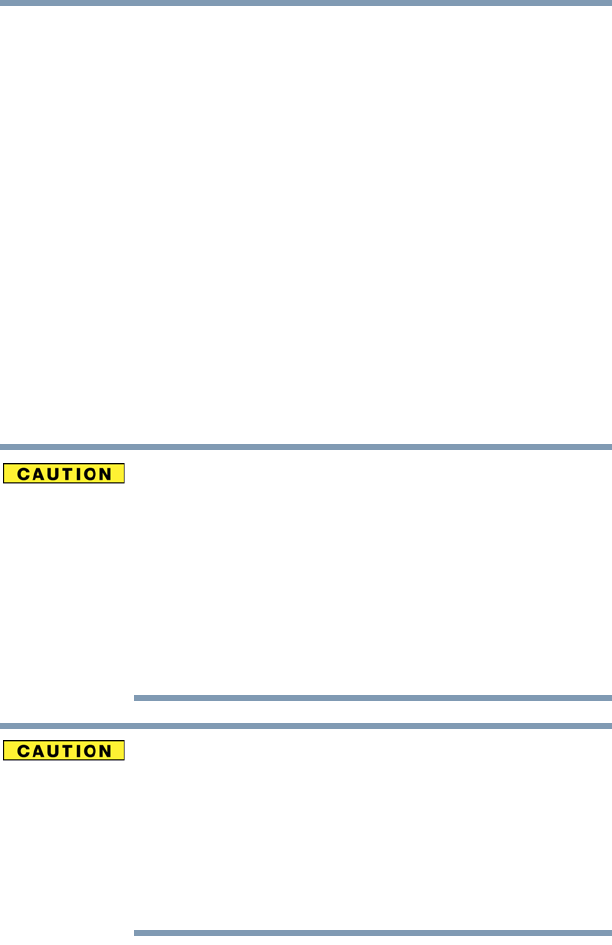
7
5.375 x 8.375 ver 2.3
NOTICE: The Ringer Equivalence Number (REN) assigned to each
terminal device provides an indication of the maximum number of
terminals allowed to be connected to a telephone interface. The termination
on an interface may consist of any combination of devices subject only to
the requirement that the sum of the Ringer Equivalence Numbers of all the
devices does not exceed 5.
3The standard connecting arrangement (telephone jack type) for this
equipment is jack type(s): USOC RJ11C.
Wireless Interoperability
The TOSHIBA Wireless LAN Mini PCI Card products are designed to be
interoperable with any wireless LAN product that is based on Direct Sequence
Spread Spectrum (DSSS) radio technology, and is compliant to:
❖The IEEE 802.11 Standard on Wireless LANs (Revision A/B/G), as defined
and approved by the Institute of Electrical and Electronics Engineers.
❖The Wireless Fidelity (Wi-Fi) certification as defined by the Wi-Fi Alliance.
The “Wi-Fi CERTIFIED” logo is a certification mark of the Wi-Fi Alliance.
Bluetooth® and Wireless LAN devices operate within the same radio
frequency range and may interfere with one another. If you use Bluetooth and
Wireless LAN devices simultaneously, you may occasionally experience a
less than optimal network performance or even lose your network
connection.
If you should experience any such problem, immediately turn off your
Bluetooth or Wireless LAN device.
Please contact Toshiba computer product support on Web site
http://www.toshiba-europe.com/computers/tnt/bluetooth.htm in Europe or
pcsupport.toshiba.com in the United States for more information.
Radio Frequency Interference Requirements
This device is restricted to indoor use due to its operation in the 5.15 GHz to
5.25 GHz frequency range. FCC requires this product to be used indoors for
frequency range 5.15 GHz to 5.25 GHz to reduce the potential for harmful
interference to co-channel Mobile Satellite systems.
High power radars are allocated as primary users of the 5.25 GHz to 5.35
GHz and 5.65 GHz to 5.85 GHz bands. These radar stations can cause
interference with and/or damage this device.
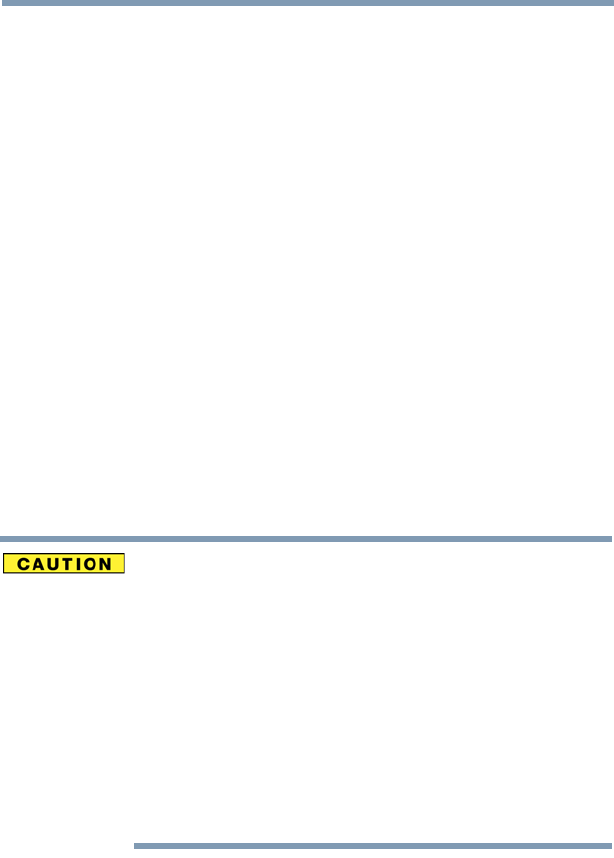
8
5.375 x 8.375 ver 2.3
Wireless LAN and Your Health
Wireless LAN products, like other radio devices, emit radio frequency
electromagnetic energy. The level of energy emitted by Wireless LAN devices
however is far much less than the electromagnetic energy emitted by wireless
devices like for example mobile phones.
Because Wireless LAN products operate within the guidelines found in radio
frequency safety standards and recommendations, TOSHIBA believes Wireless
LAN is safe for use by consumers. These standards and recommendations reflect
the consensus of the scientific community and result from deliberations of panels
and committees of scientists who continually review and interpret the extensive
research literature.
In some situations or environments, the use of Wireless LAN may be restricted
by the proprietor of the building or responsible representatives of the
organization. These situations may for example include:
❖Using the Wireless LAN equipment on board airplanes, or
❖In any other environment where the risk of interference to other devices or
services is perceived or identified as harmful.
If you are uncertain of the policy that applies on the use of wireless devices in a
specific organization or environment (e.g. airports), you are encouraged to ask for
authorization to use the Wireless LAN device prior to turning on the equipment.
Exposure to Radio Frequency Radiation
The radiated output power of the TOSHIBA Wireless LAN Mini PCI Card is
far below the FCC radio frequency exposure limits. Nevertheless, the
TOSHIBA Wireless LAN Mini PCI Card shall be used in such a manner that
the potential for human contact during normal operation is minimized. In
normal operating configuration, the LCD in the upright position, the distance
between the antenna and the user should not be less than 20 cm. The
antenna(s) used for this transmitter must not be co-located or operating in
conjunction with any other antenna or transmitter. Antenna(s) used in 5.15
GHz to 5.25 GHz frequency band must be integral antenna which provide no
access to the end user.
Refer to the Regulatory Statements as identified in the documentation that
comes with those products for additional information.
Regulatory Information
The TOSHIBA Wireless LAN Mini PCI Card must be installed and used in strict
accordance with the manufacturer’s instructions as described in the user
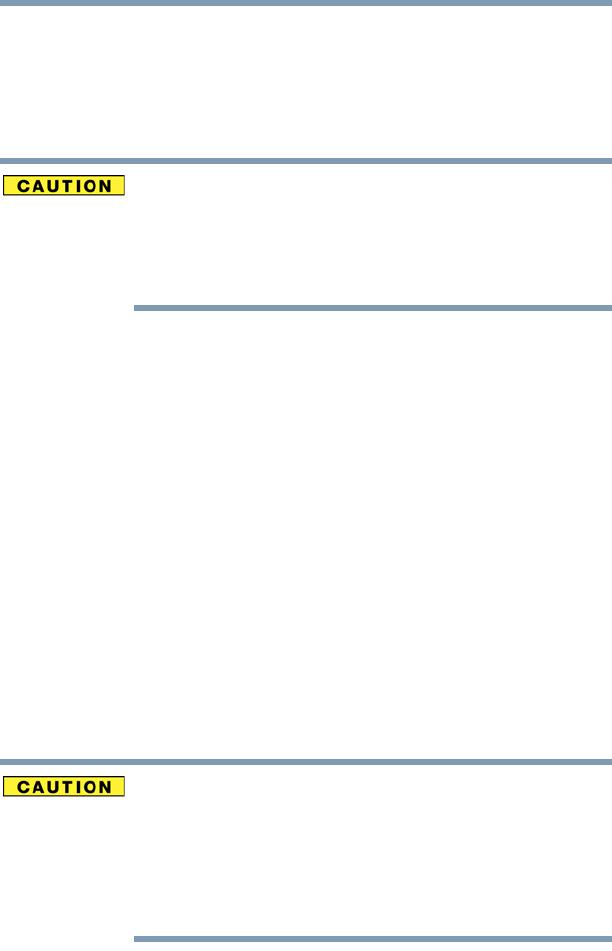
9
5.375 x 8.375 ver 2.3
documentation that comes with the product. This device complies with the
following radio frequency and safety standards.
Canada – Industry Canada (IC)
This device complies with RSS 210 of Industry Canada.
The installer of this radio equipment must ensure that the antenna is located
or pointed such that it does not emit RF field in excess of Health Canada
limits for the general population; consult Safety Code 6, obtainable from
Health Canada’s Web site www.hc-sc.gc.ca/rpb. The RF device shall not be
co-located with any other transmitter that has not been tested with this
device.
Operation is subject to the following two conditions: (1) this device may not
cause interference, and (2) this device must accept any interference, including
interference that may cause undesired operation of this device.
L’utilisation de ce dispositif est autorisée seulement aux conditions suivantes: (1)
il ne doit pas produire de brouillage et (2) l’utilisateur du dispositif doit étre prêt à
accepter tout brouillage radioélectrique reçu, même si ce brouillage est
susceptible de compromettre le fonctionnement du dispositif.
The term “IC” before the equipment certification number only signifies that the
Industry Canada technical specifications were met.
To prevent radio interference to the licensed service, this device is intended to be
operated indoors and away from windows to provide maximum shielding.
Equipment (or its transmit antenna) that is installed outdoors is subject to
licensing.
Pour empecher que cet appareil cause du brouillage au service faisant l'objet
d'une licence, il doit etre utilize a l'interieur et devrait etre place loin des fenetres
afin de Fournier un ecram de blindage maximal. Si le matriel (ou son antenne
d'emission) est installe a l'exterieur, il doit faire l'objet d'une licence.
This device is restricted to indoor use due to its operation in the 5.15 GHz to
5.25 GHz frequency range. Industry Canada requires this product to be used
indoors for frequency range 5.15 GHz to 5.25 GHz to reduce the potential for
harmful interference to co-channel Mobile Satellite systems.
High power radars are allocated as primary users of the 5.25 GHz to 5.35
GHz and 5.65 GHz to 5.85 GHz bands. These radar stations can cause
interference with and/or damage this device.
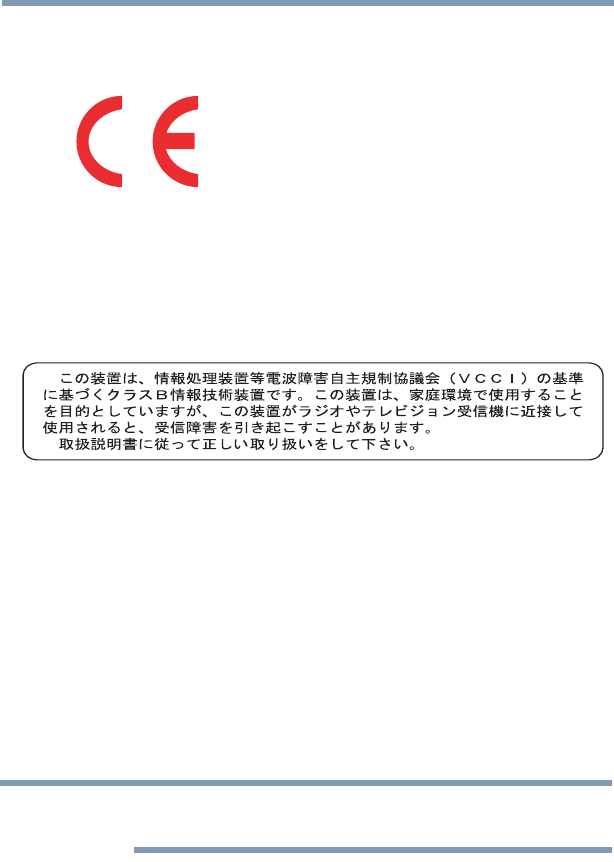
10
5.375 x 8.375 ver 2.3
EU Declaration of Conformity
TOSHIBA declares that this product conforms to the following Standards:
This product is carrying the CE-Mark in accordance with the related European
Directives. Responsible for CE-Marking is TOSHIBA Europe, Hammfelddamm
8, 41460 Neuss, Germany.
VCCI Class B Information
Modem Warning Notice
Conformity Statement
The equipment has been approved to [Commission Decision “CTR-21”] for pan-
European single terminal connection to the Public Switched Telephone Network
(PSTN).
However, due to differences between the individual PSTNs provided in different
countries/regions the approval does not, of itself, give an unconditional assurance
of successful operation on every PSTN network termination point.
In the event of problems, you should contact your equipment supplier in the first
instance.
The above Caution information applies to products that operate with an
802.11a device.
Supplementary
Information:
*The product complies with the
requirements of the Low Voltage Directive
72/23/EEC, the EMC Directive 89/336/
EEC and/or the R&TTE Directive 1999/
05/EEC.
NOTE
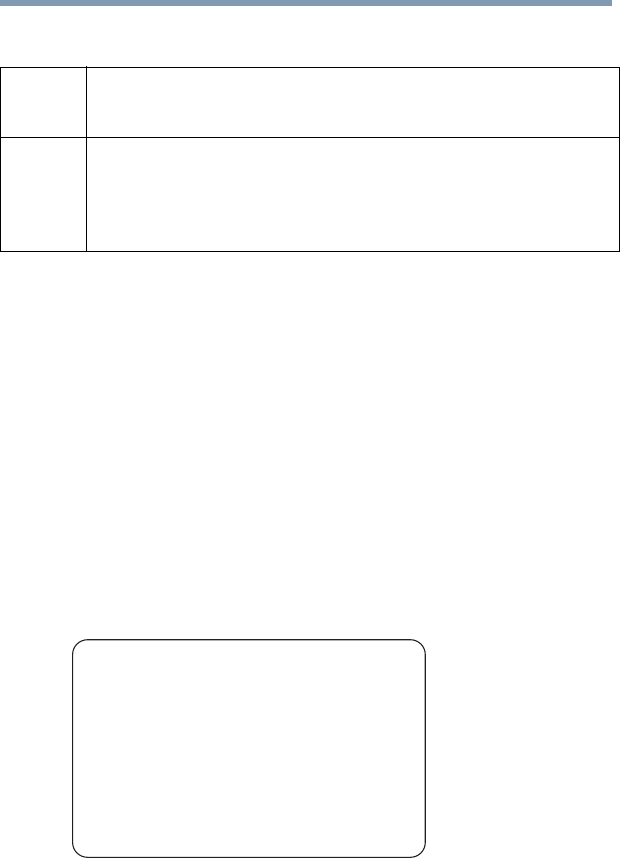
11
5.375 x 8.375 ver 2.3
Taiwan
The legal communications mentioned in the above item refer to radio
communications operated in accordance with telecommunication laws and
regulations.
Low power radio frequency electric machinery shall resist against interference
from legal communications or from industrial, scientific and medical radio
emission electric machinery.
Using this Equipment in Japan
In Japan, the frequency bandwidth of 2,400 MHz to 2,483.5 MHz for second
generation low-power data communication systems such as this equipment
overlaps that of mobile object identification systems (premises radio station and
specified low-power radio station).
1. Sticker
Please put the following sticker on devices incorporating this product.
Article 14 Unless approved, for any model accredited low power radio frequency electric
machinery, any company, trader or user shall not change the frequency,
increase the power or change the features and functions of the original design.
Article 17 Any use of low power radio frequency electric machinery shall not affect
aviation safety and interfere with legal communications. In the event
interference is caused, the use of such electric machinery shall be immediately
discontinued. Operation of such products can be resumed only when they are
modified and can no longer cause interference.
The frequency bandwidth of this equipment may operate within the
same range as industrial devices, scientific devices, medical
devices, microwave ovens, licensed radio stations and non-licensed
specified low-power radio stations for mobile object identification
systems (RFID) used in factory product lines (Other Radio Stations).
1. Before using this equipment, ensure that it does not interfere with
any of the equipment listed above.
2. If this equipment causes RF interference to other radio stations,
promptly change the frequency being used, change the location
of use, or turn off the source of emissions.
3. Contact TOSHIBA Direct PC if you have problems with interference
caused by this product to Other Radio Stations.
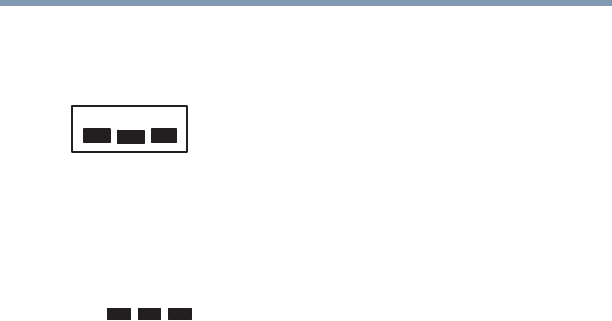
12
5.375 x 8.375 ver 2.3
2. Indication
The indication shown below appears on this equipment.
12.4: This equipment uses a frequency of 2.4 GHz.
2DS: This equipment uses DS-SS modulation.
OF: This equipment uses OFDM modulation.
3The interference range of this equipment is less than 40m.
4This equipment uses a frequency bandwidth from
2,400 MHz to 2,483.5 MHz.
It is possible to avoid the band of mobile object identification systems.
3. TOSHIBA Direct PC
Monday – Friday: 10:00 – 17:00
Toll Free Tel: 0120-15-1048
Direct Dial: 03-3457-4850
Fax: 03-3457-4868
Device Authorization
This device obtains the Technical Regulation Conformity Certification and the
Technical Conditions Compliance Approval, and it belongs to the device class of
radio equipment of low-power data communication system radio station
stipulated in the Radio Law and the Telecommunications Business Law of Japan.
The Name of the radio equipment: refer to the equipment label provided on the
computer
JAPAN APPROVALS INSTITUTE FOR TELECOMMUNICATIONS
EQUIPMENT
Approval Number: D01-1128JP
TELECOM ENGINEERING CENTER Approval Number: 03NY.A0018,
03GZDA0017
2.4DSOF4
(1)
(2) (3)
(4)
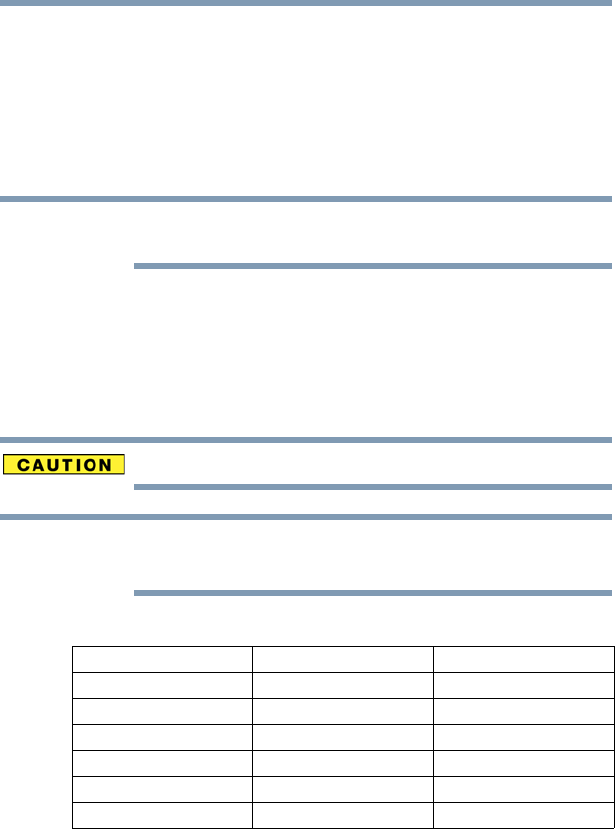
13
5.375 x 8.375 ver 2.3
The following restrictions apply:
❖Do not disassemble or modify the device.
❖Do not install the embedded wireless module into other device.
❖5.17 GHz to 5.23 GHz for indoor use only.
Radio Approvals for Wireless Devices
The following information is dependent on what type of wireless device is in
your computer.
Approved Countries/Regions for use for the Atheros
AR5BMB-43/44 and AR5BMB5 Mini PCI Wireless Network
Adapters
This equipment is approved to the radio standard by the countries/regions in the
following table.
Do not use this equipment except in the countries/regions in the following table.
This device works on passive scan only.
A peer-to-peer mode is not available in 802.11a and Turbo Mode.
802.11b (2.4 GHz)
Australia Austria Belgium
Canada Denmark Finland
France Germany Greece
Ireland Italy Liechtenstein
Luxembourg Netherlands New Zealand
Norway Portugal Sweden
Switzerland UK USA
NOTE
NOTE
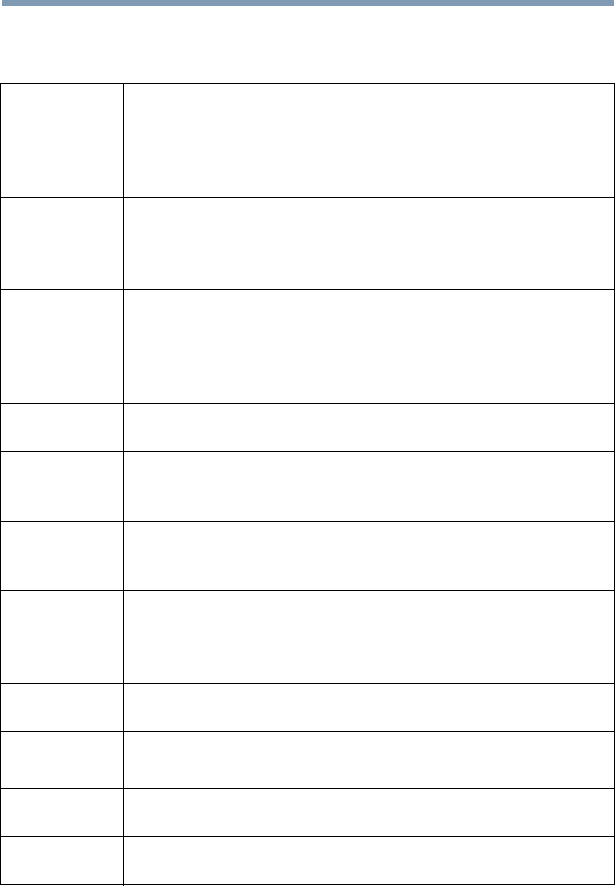
14
5.375 x 8.375 ver 2.3
Europe - Restrictions for use of 2.4 GHz Frequencies in
European Community Countries
België/
Belgique:
For private usage outside buildings across public grounds over less than
300m no special registration with IBPT/BIPT is required. Registration to
IBPT/BIPT is required for private usage outside buildings across public
grounds over more than 300m. For registration and license please
contact IBPT/BIPT.
Voor privé-gebruik buiten gebouw over publieke groud over afstand
kleiner dan 300m geen registratie bij BIPT/IBPT nodig; voor gebruik
over afstand groter dan 300m is wel registratie bij BIPT/IBPT nodig.
Voor registratie of licentie kunt u contact opnemen met BIPT.
Dans le cas d’une utilisation privée, à l’extérieur d’un bâtiment, au-
dessus d’un espace public, aucun enregistrement n’est nécessaire pour
une distance de moins de 300m. Pour une distance supérieure à 300m un
enregistrement auprès de I’IBPT est requise. Pour les enregistrements et
licences, veuillez contacter I’IBPT.
Deutschland: License required for outdoor installations. Check with reseller for
procedure to follow.
Anmeldung im Outdoor-Bereich notwendig, aber nicht
genehmigungspflichtig.Bitte mit Händler die Vorgehensweise
abstimmen.
France: Restricted frequency band: only channels 1 to 7 (2400 MHz and 2454
MHz respectively) may be used outdoors in France. Please contact
A.R.T. (http://www.art-telecom.fr) for applicable procedures to follow.
Bande de fréquence restreinte: seuls les canaux 1- 7 (2400 et 2454 MHz
respectivement) doivent être utilisés endroits extérieur en France. Vous
pouvez contacter I’Autorité de Régulation des Télécommuniations
(http://www.art-telecom.fr) pour la procédure à suivre.
Italia: License required for indoor use. Use with outdoor installations not
allowed.
E’necessaria la concessione ministeriale anche per l’uso interno.
Verificare con i rivenditori la procedura da seguire.
Nederland: License required for outdoor installations. Check with reseller for
procedure to follow.
Licentie verplicht voor gebruik met buitenantennes. Neem contact op
met verkoper voor juiste procedure.
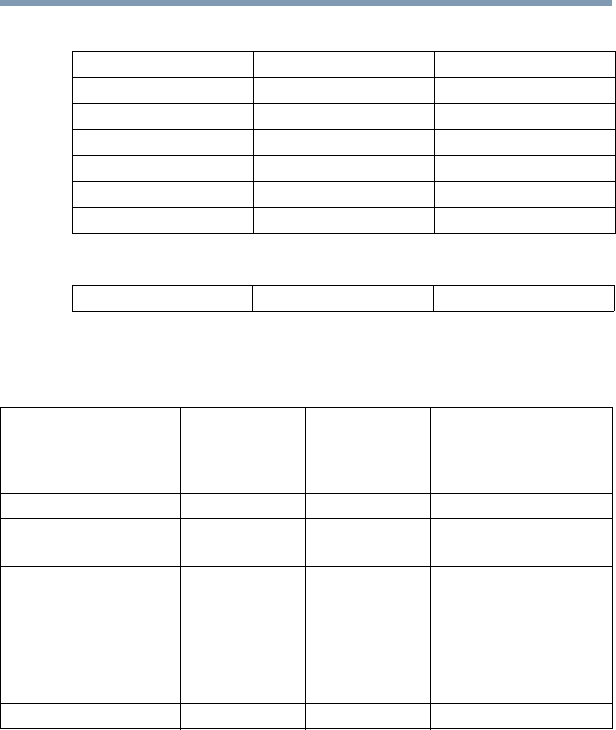
15
5.375 x 8.375 ver 2.3
802.11a (5 GHz)
Turbo Mode (5 GHz)
Europe - Restrictions for Use of 5 GHz Frequencies in
European Community Countries
O: allowed ×: forbidden
❖To remain in conformance with European spectrum usage laws for Wireless
LAN operation, the above 2.4 GHz and 5 GHz channel limitations apply.
The user should use the wireless LAN utility to check the current channel of
operation. If operation is occurring outside of the allowable frequencies as
listed above, the user must cease operating the Wireless LAN at that
location and consult the local technical support staff responsible for the
wireless network.
❖The 5 GHz Turbo mode feature is not allowed for operation in any
European Community country.
Australia Austria Belgium
Canada Denmark Finland
France Germany Greece
Ireland Italy Liechtenstein
Luxembourg Netherlands New Zealand
Norway Portugal Sweden
Switzerland UK USA
Canada USA
European Community
Countries
5150-5250 MHz
Channels: 36, 40, 44,
48
Indoor Only
5250-5350 MHz
Channels: 52, 56, 60,
64
Indoor Only
5470-5725 MHz
Channels: 100, 104, 108, 112,
116, 120, 124, 128, 132, 136, 140
Indoor/Outdoor
Austria O x x
Belgium, France,
Switzerland/Lichtenstein
OO x
Denmark, Finland,
Germany, Greece,
Ireland, Italy,
Luxembourg,
Netherlands, Norway,
Portugal, Sweden, UK
OO O
Iceland, Spain O O O
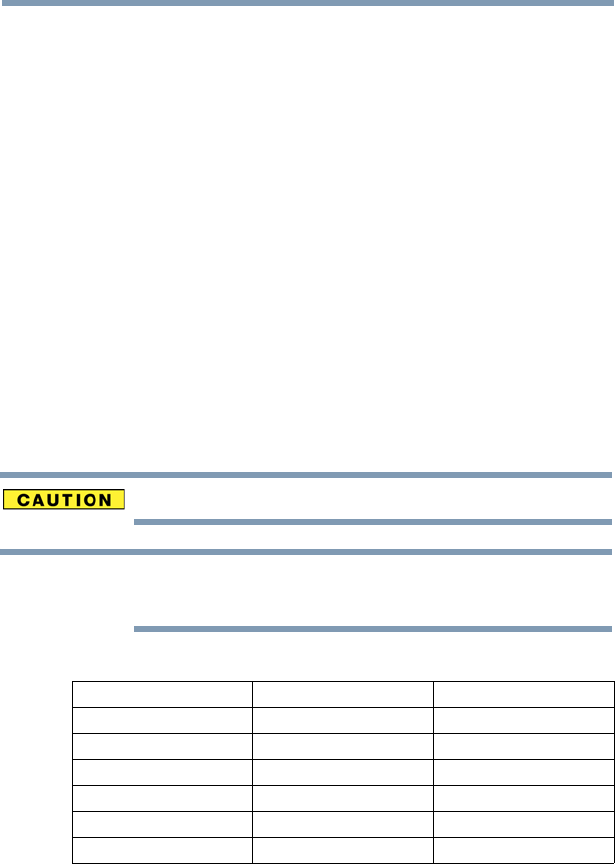
16
5.375 x 8.375 ver 2.3
❖This device must not be operated in ad-hoc mode using channels in the
5 GHz bands in the European Community. Ad-hoc mode provides a direct
communication between two client devices without a Wireless LAN Access
Point.
❖This device must be used with Access Points that have employed and
activated a radar detection feature required for European Community
operation in the 5 GHz bands. This device will operate under the control of
the Access Point in order to avoid operating on a channel occupied by any
radar system in the area. The presence of nearby radar operation may result
in temporary interruption of operation of this device. The Access Point’s
radar detection feature will automatically restart operation on a channel free
of radar. You may consult with the local technical support staff responsible
for the wireless network to ensure the Access Point device(s) are properly
configured for European Community operation.
Approved Countries/Regions for use for the Atheros AR5001X
Mini PCI Wireless Network Adapter
This equipment is approved to the radio standard by the countries/regions in the
following table.
Do not use this equipment except in the countries/regions in the following table.
This device works on passive scan only.
A peer-to-peer mode is not available in 802.11a and Turbo Mode.
802.11b (2.4 GHz)
Australia Austria Belgium
Canada Denmark Finland
France Germany Greece
Ireland Italy Liechtenstein
Luxembourg Netherlands New Zealand
Norway Portugal Sweden
Switzerland UK USA
NOTE
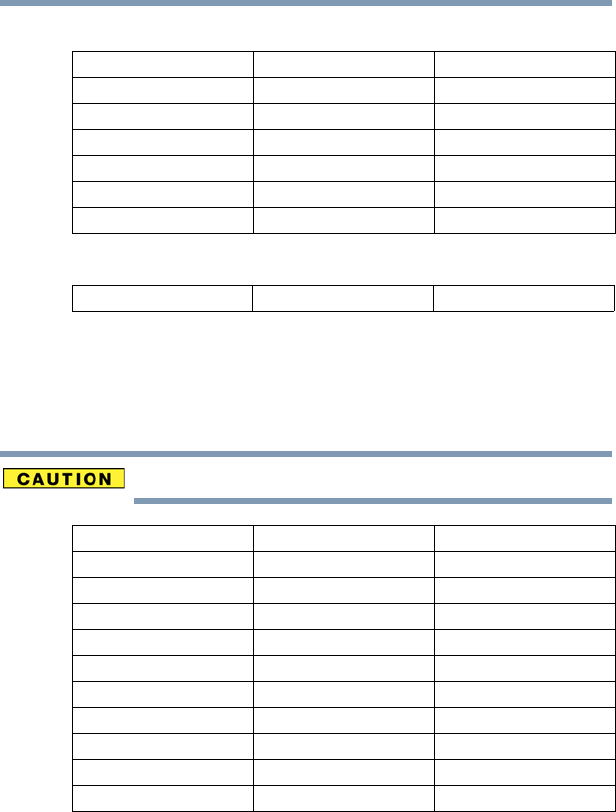
17
5.375 x 8.375 ver 2.3
802.11a (5 GHz)
Turbo Mode (5 GHz)
Approved Countries/Regions for use for the Intel® PRO/
Wireless LAN 2100 3B Mini PCI Adapter
This equipment is approved to the radio standard by the countries/regions in the
following table.
Do not use this equipment except in the countries/regions in the following table.
Australia Austria Belgium
Canada Denmark Finland
France Germany Greece
Ireland Italy Liechtenstein
Luxembourg Netherlands New Zealand
Norway Portugal Sweden
Switzerland UK USA
Canada USA
Argentina Australia Austria
Belgium Brazil Canada
Chile Denmark Finland
France Germany Greece
Iceland Ireland Italy
Japan Liechtenstein Luxembourg
Mexico Netherlands New Zealand
Norway Peru Portugal
Singapore Spain Sweden
Switzerland UK Uruguay
USA Venezuela
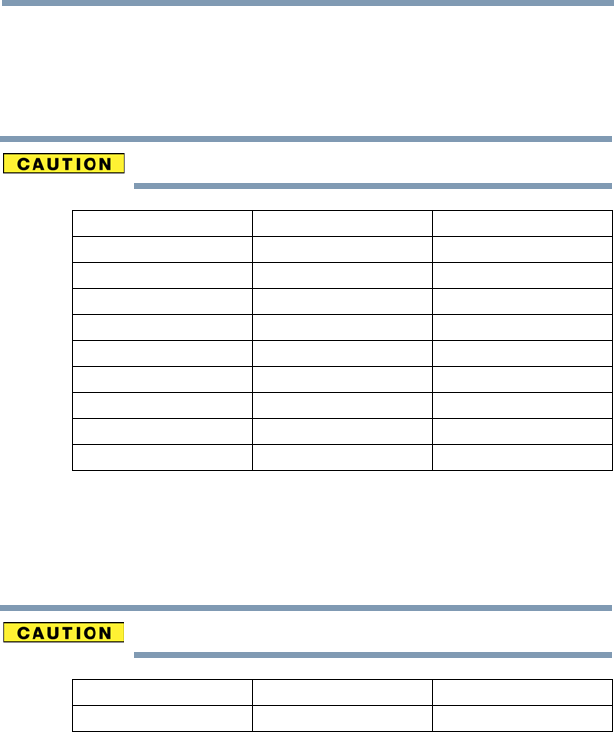
18
5.375 x 8.375 ver 2.3
Approved Countries/Regions for use for the Toshiba Mini PCI
Wireless LAN Card
This equipment is approved to the radio standard by the countries/regions in the
following table.
Do not use this equipment except in the countries/regions in the following table.
Approved Countries/Regions for use for the INPROCOMM
IPN2220 Wireless Network Adapter
This equipment is approved to the radio standard by the countries/regions in the
following table.
Do not use this equipment except in the countries/regions in the following table.
Bluetooth® Wireless Technology Interoperability
Bluetooth® Cards from TOSHIBA are designed to be interoperable with any
product with Bluetooth wireless technology that is based on Frequency Hopping
Spread Spectrum (FHSS) radio technology, and is compliant to:
❖Bluetooth Specification as defined and approved by The Bluetooth Special
Interest Group.
❖Logo certification with Bluetooth wireless technology as defined by The
Bluetooth Special Interest Group.
Australia Austria Belgium
Canada Denmark Finland
France Germany Greece
Hong Kong Iceland Ireland
Italy Japan Liechtenstein
Luxembourg Malaysia Netherlands
New Zealand Norway Philippines
Portugal Singapore Spain
Sweden Switzerland Thailand
UK USA
EU Canada Japan
USA Australia New Zealand

19
5.375 x 8.375 ver 2.3
Bluetooth wireless technology is a new innovative technology, and TOSHIBA
has not confirmed compatibility of its Bluetooth products with all computers
and/or equipment using Bluetooth wireless technology other than TOSHIBA
portable computers.
Always use Bluetooth cards from TOSHIBA in order to enable wireless
networks over two or more (up to a total of seven) TOSHIBA portable
computers using these cards. Please contact TOSHIBA computer product
support on Web site http://www.toshiba-europe.com/computers/tnt/
bluetooth.htm in Europe or pcsupport.toshiba.com in the United States for
more information.
When you use Bluetooth cards from TOSHIBA close to 2.4 GHz Wireless
LAN devices, Bluetooth transmissions might slow down or cause errors. If
you detect certain interference while you use Bluetooth cards from TOSHIBA,
always change the frequency, move your computer to the area outside of the
interference range of 2.4 GHz Wireless LAN devices (40 meters/43.74 yards
or more) or stop transmitting from your computer. Please contact TOSHIBA
computer product support on Web site http://www.toshiba-europe.com/
computers/tnt/bluetooth.htm in Europe or pcsupport.toshiba.com in the
United States for more information.
Bluetooth and Wireless LAN devices operate within the same radio frequency
range and may interfere with one another. If you use Bluetooth and Wireless
LAN devices simultaneously, you may occasionally experience a less than
optimal network performance or even lose your network connection. If you
should experience any such problem, immediately turn off either one of your
Bluetooth or Wireless LAN. Please contact Toshiba computer product
support on Web site http://www.toshiba-europe.com/computers/tnt/
bluetooth.htm in Europe or pcsupport.toshiba.com in the United States for
more information.
Bluetooth® Wireless Technology and Your Health
The products with Bluetooth® wireless technology, like other radio devices, emit
radio frequency electromagnetic energy. The level of energy emitted by devices
with Bluetooth wireless technology however is far much less than the
electromagnetic energy emitted by wireless devices like for example mobile
phones.
Because products with Bluetooth wireless technology operate within the
guidelines found in radio frequency safety standards and recommendations,
TOSHIBA believes Bluetooth wireless technology is safe for use by consumers.
These standards and recommendations reflect the consensus of the scientific
community and result from deliberations of panels and committees of scientists
who continually review and interpret the extensive research literature.
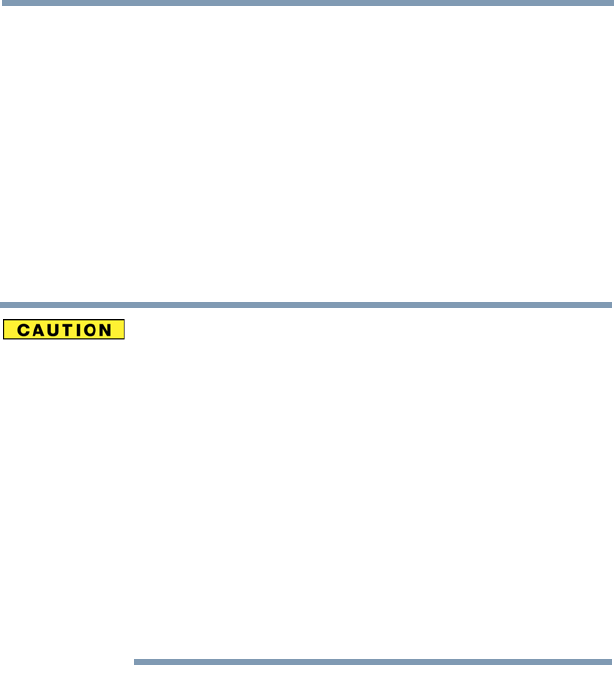
20
5.375 x 8.375 ver 2.3
In some situations or environments, the use of Bluetooth wireless technology
may be restricted by the proprietor of the building or responsible representatives
of the organization. These situations may for example include:
❖Using the equipment with Bluetooth wireless technology on board
airplanes, or
❖In any other environment where the risk of interference to other devices or
services is perceived or identified as harmful.
If you are uncertain of the policy that applies on the use of wireless devices in a
specific organization or environment (e.g. airports), you are encouraged to ask for
authorization to use the device with Bluetooth wireless technology prior to
turning on the equipment.
Exposure to Radio Frequency Radiation
The radiated output power of the Bluetooth Card from TOSHIBA is far below
the FCC radio frequency exposure limits. Nevertheless, the Bluetooth Card
from TOSHIBA shall be used in such a manner that the potential for human
contact during normal operation is minimized.
In order to comply with FCC radio-frequency radiation exposure guidelines
for an uncontrolled environment, the Bluetooth Card from TOSHIBA has to be
operated while maintaining a minimum body to antenna distance of 20 cm.
Refer to the Regulatory Statements as identified in the documentation that
comes with those products for additional information.
The Bluetooth Card from TOSHIBA is far below the FCC radio frequency
exposure limits.
Nevertheless, it is advised to use the Bluetooth Card from TOSHIBA in such
a manner that human contact during normal operation is minimized.
Regulatory statements
This product complies with any mandatory product specification in any country/
region where the product is sold. In addition, the product complies with the
following:
European Union (EU) and EFTA
This equipment complies with the R&TTE directive 1999/5/EC and has been
provided with the CE mark accordingly.
Canada — Industry Canada (IC)
This device complies with RSS 210 of Industry Canada.
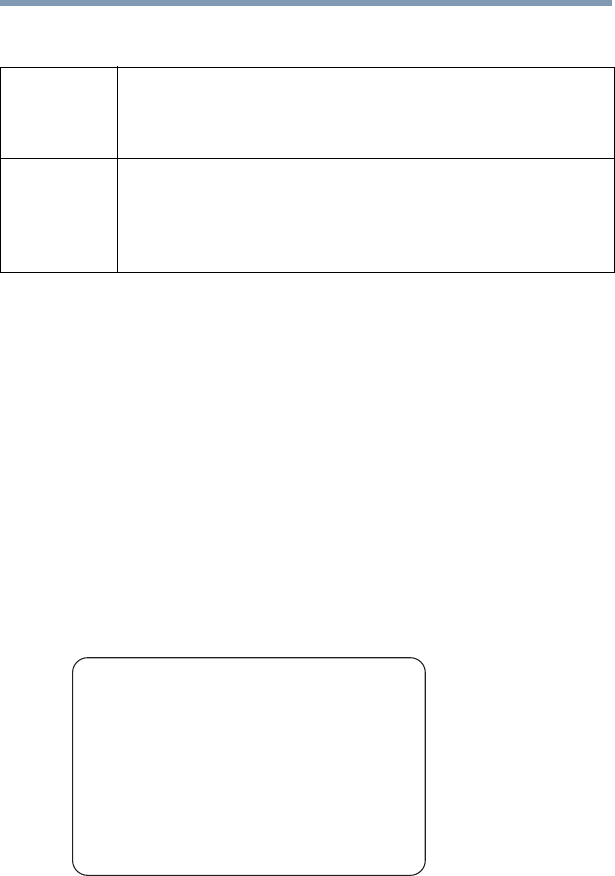
21
5.375 x 8.375 ver 2.3
Taiwan
The legal communications mentioned in the above item refer to radio
communications operated in accordance with telecommunication laws and
regulations.
Low power radio frequency electric machinery shall resist against interference
from legal communications or from industrial, scientific and medical radio
emission electric machinery.
Using this Equipment in Japan
In Japan, the frequency bandwidth of 2,400 MHz to 2,483.5 MHz for second
generation low-power data communication systems such as this equipment
overlaps that of mobile object identification systems (premises radio station and
specified low-power radio station).
1. Sticker
Please put the following sticker on devices incorporating this product.
Article 14 Unless approved, for any model accredited low power radio frequency
electric machinery, any company, trader or user shall not change the
frequency, increase the power or change the features and functions of the
original design.
Article 17 Any use of low power radio frequency electric machinery shall not affect
aviation safety and interfere with legal communications. In the event
interference is caused, the use of such electric machinery shall be
immediately discontinued. Operation of such products can be resumed
only when they are modified and can no longer cause interference.
The frequency bandwidth of this equipment may operate within the
same range as industrial devices, scientific devices, medical
devices, microwave ovens, licensed radio stations and non-licensed
specified low-power radio stations for mobile object identification
systems (RFID) used in factory product lines (Other Radio Stations).
1. Before using this equipment, ensure that it does not interfere with
any of the equipment listed above.
2. If this equipment causes RF interference to other radio stations,
promptly change the frequency being used, change the location
of use, or turn off the source of emissions.
3. Contact TOSHIBA Direct PC if you have problems with interference
caused by this product to Other Radio Stations.

22
5.375 x 8.375 ver 2.3
2. Indication
The indication shown below appears on this equipment.
12.4: This equipment uses a frequency of 2.4 GHz.
2FH: This equipment uses FH-SS modulation.
3The interference range of this equipment is less than 10m.
4This equipment uses a frequency bandwidth from 2,400 MHz to
2,483.5 MHz. It is impossible to avoid the band of mobile object
identification systems.
3. TOSHIBA Direct PC
Monday – Friday: 10:00 – 17:00
Toll Free Tel: 0120-15-1048
Direct Dial: 03-3457-4850
Fax: 03-3457-4868
Device Authorization
This device obtains the Technical Regulation Conformity Certification, and it
belongs to the device class of radio equipment of low-power data communication
system radio station stipulated in the Radio Law of Japan.
The Name of the radio equipment: EYXF2CS
TELECOM ENGINEERING CENTER
Approval Number: 01NYDA1305
The following restrictions apply:
❖Do not disassemble or modify the device.
❖Do not install the embedded wireless module into other device.
2.4FH1
(1) (2) (3)
(4)
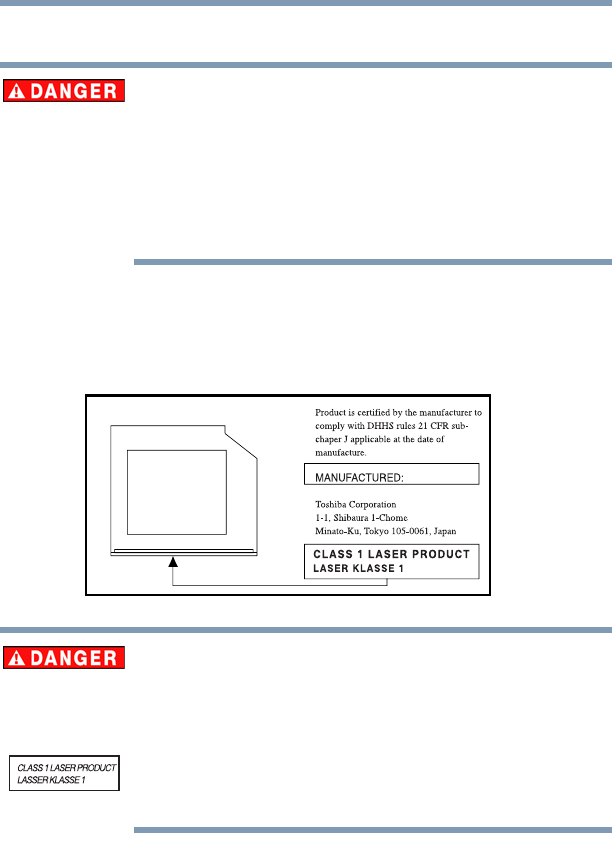
23
5.375 x 8.375 ver 2.3
Optical Drive Safety Instructions
The HD DVD-ROM and multi-function drives employ a laser system. To
ensure proper use of this product, please read this instruction manual
carefully and retain for future reference.
Never attempt to disassemble, adjust or repair a HD DVD, CD/DVD drive,
CD-RW drive, Multi-drive or any other optical drive. You could damage the drive.
You would also be exposed to laser light or other safety hazards, resulting in serious
injury. Always contact an authorized Toshiba service provider, if any repair or
adjustment is required.
Location of the Required Label
(Sample shown below. Location of the label and manufacturing information may
vary.)
This appliance contains a laser system and is classified as a CLASS 1 LASER
PRODUCT. To use this model properly, read the user’s guide carefully and keep it for
your future reference.
Never attempt to disassemble, adjust or repair a HD DVD, CD/DVD drive,
CD-RW drive, Multi-drive or any other optical drive. You could damage the
drive. You would also be exposed to laser light or other safety hazards,
resulting in serious injury. Always contact an authorized Toshiba service
provider, if any repair or adjustment is required.

24
5.375 x 8.375 ver 2.3
Copyright
This guide is copyrighted by Toshiba America Information Systems, Inc. with all
rights reserved. Under the copyright laws, this guide cannot be reproduced in any
form without the prior written permission of Toshiba. No patent liability is
assumed, however, with respect to the use of the information contained herein.
©2006 by Toshiba America Information Systems, Inc. All rights reserved.
Export Administration Regulation
This document contains technical data that may be controlled under the U.S.
Export Administration Regulations, and may be subject to the approval of the
U.S. Department of Commerce prior to export. Any export, directly or indirectly,
in contravention of the U.S. Export Administration Regulations is prohibited.
Notice
The information contained in this manual, including but not limited to any
product specifications, is subject to change without notice.
TOSHIBA CORPORATION AND TOSHIBA AMERICA
INFORMATION SYSTEMS, INC. (TOSHIBA) PROVIDES NO
WARRANTY WITH REGARD TO THIS MANUAL OR ANY OTHER
INFORMATION CONTAINED HEREIN AND HEREBY EXPRESSLY
DISCLAIMS ANY IMPLIED WARRANTIES OF MERCHANTABILITY
OR FITNESS FOR ANY PARTICULAR PURPOSE WITH REGARD TO
ANY OF THE FOREGOING. TOSHIBA ASSUMES NO LIABILITY
FOR ANY DAMAGES INCURRED DIRECTLY OR INDIRECTLY
FROM ANY TECHNICAL OR TYPOGRAPHICAL ERRORS OR
OMISSIONS CONTAINED HEREIN OR FOR DISCREPANCIES
BETWEEN THE PRODUCT AND THE MANUAL. IN NO EVENT
SHALL TOSHIBA BE LIABLE FOR ANY INCIDENTAL,
CONSEQUENTIAL, SPECIAL, OR EXEMPLARY DAMAGES,
WHETHER BASED ON TORT, CONTRACT OR OTHERWISE,
ARISING OUT OF OR IN CONNECTION WITH THIS MANUAL OR
ANY OTHER INFORMATION CONTAINED HEREIN OR THE USE
THEREOF.

25
5.375 x 8.375 ver 2.3
Trademarks
Tecra is a registered trademark of Toshiba America Information Systems, Inc.
and/or Toshiba Corporation.
Microsoft and Windows are registered trademarks of Microsoft Corporation in
the United States and/or other countries.
DirectX, Active Desktop, DirectShow, and Windows Media are registered
trademarks of Microsoft Corporation.
Secure Digital and SD are trademarks of the Secure Digital Association.
xD-Picture Card is a trademark of Fuji Photo Film Co. Ltd.
MultiMediaCard is a trademark of Infineon Technologies AG.
ConfigFree is a trademark of Toshiba Corporation.
Wi-Fi is a registered trademark of the Wi-Fi Alliance.
Intel, Intel Core, Celeron, Centrino and Pentium are trademarks or registered
trademarks of Intel Corporation or its subsidiaries in the United States and other
countries.
TouchPad is a trademark of Synaptics, Inc.
i.LINK is a registered trademark of Sony Corporation.
Adobe and Photoshop are either registered trademarks or trademarks of Adobe
Systems Incorporated in the United States and/or other countries.
Bluetooth word mark and logos are owned by the Bluetooth SIG, Inc. and any
use of such marks by Toshiba is under license. Other trademarks and trade names
are those of their respective owners.
All other brand and product names are trademarks or registered trademarks of
their respective companies.
Computer Disposal Information
This product contains mercury. Disposal of this material may be regulated due to
environmental considerations. For disposal, reuse or recycling information,
please contact your local government or the Electronic Industries Alliance at
www.eiae.org.

26
5.375 x 8.375 ver 2.3
Contents
Introduction................................................................................ 35
This guide ...............................................................37
Safety icons ............................................................37
Other icons used...............................................38
Other documentation ..............................................38
Service options .......................................................39
Chapter 1: Getting Started......................................................... 40
Selecting a place to work ........................................40
Creating a computer-friendly environment........40
Keeping yourself comfortable ...........................41
Precautions.......................................................41
Important information on your computer’s
cooling fan ..................................................43
Setting up your computer .......................................44
Setting up your software...................................45
Registering your computer with Toshiba ................46
Adding optional external devices.............................46
Connecting to a power source ................................47
Charging the main battery.......................................50

27
Contents
5.375 x 8.375 ver 2.3
Using the computer for the first time......................51
Opening the display panel.................................51
Your computer’s features and specifications ....52
Turning on the power........................................53
Adding memory (optional)......................................54
Installing a memory module .............................54
Hard Drive Recovery Utilities ..................................55
Creating Recovery CDs/DVDs ...........................55
Hard Disk Drive Recovery using the recovery
partition ......................................................57
Hard Disk Drive Recovery using the Recovery
media..........................................................62
Installing drivers and applications.....................65
Using the TouchPad™.............................................66
Scrolling with the TouchPad™ ..........................67
Control buttons.................................................67
Disabling or enabling the TouchPad™ ..............67
Using external display devices ................................69
Directing the display output when you turn
on the computer .........................................69
Adjusting the quality of the external display......71
Using an external keyboard.....................................71
Using a mouse........................................................71
Connecting a printer ...............................................72
Setting up a printer ...........................................73
Connecting an optional external diskette drive........74
Turning off the computer ........................................75
Options for turning off the computer ................75
Using the Turn Off Computer or Shut Down
commands..................................................78
Using and configuring Hibernation mode .........80
Using and configuring Standby mode...............82
Closing the display panel ..................................83
Using your computer in tablet mode.......................84

28 Contents
5.375 x 8.375 ver 2.3
Customizing your computer’s settings..............85
Caring for your computer........................................86
Cleaning the computer......................................86
Moving the computer........................................86
Using a computer lock ......................................87
Chapter 2: Learning the Basics................................................. 88
Computing tips .......................................................88
Using the keyboard .................................................90
Character keys ..................................................90
Making your keyboard emulate a full-size
keyboard .....................................................90
Ctrl, Fn, and Alt keys .........................................91
Function keys....................................................91
Windows special keys.......................................92
Overlay keys......................................................92
Using the overlay to type numeric data.............93
Starting a program..................................................93
Starting a program from the Start menu...........94
Starting a program from Windows® Explorer....94
Starting a program from the Run dialog box ....95
Saving your work....................................................96
Printing your work ..................................................98
Backing up your work .............................................99
Restoring your work .......................................100
Using the optical drive ..........................................100
Optical drive components ...............................101
Inserting a disc ...............................................102
Playing an audio CD........................................104
Playing optical media......................................105
Creating a CD/DVD..........................................106
Removing a disc with the computer on...........107
Removing a disc with the computer off ..........107
Caring for CD or DVD discs ............................108

29
Contents
5.375 x 8.375 ver 2.3
Toshiba’s online resources ...................................108
Chapter 3: Mobile Computing................................................. 109
Toshiba’s energy-saver design..............................109
Running the computer on battery power ..............109
Battery Notice .................................................110
Power management ........................................111
Using additional batteries ...............................111
Charging batteries.................................................112
Charging the main battery...............................112
Charging the RTC battery................................113
Monitoring main battery power.............................114
Determining remaining battery power.............116
What to do when the main battery runs low ...117
Setting battery alarms.....................................117
Conserving battery power ...............................118
Power Profiles ................................................119
Using a hot key to set the Power Profile .........120
Changing the main battery ....................................121
Removing the battery from the computer .......121
Inserting a charged battery .............................123
Taking care of your battery ...................................124
Safety precautions ..........................................124
Maximizing battery life....................................125
Disposing of used batteries ..................................127
Traveling tips ........................................................128
Chapter 4: Exploring Your Computer’s Features................... 129
Exploring the desktop ...........................................129
Finding your way around the desktop .............130
Setting up for communications.............................132
Connecting the modem to a telephone line .....134
Connecting your computer to a network.........136
An overview of using the Internet .........................138

30 Contents
5.375 x 8.375 ver 2.3
The Internet ....................................................139
The World Wide Web ......................................139
Internet Service Providers...............................139
Connecting to the Internet ..............................139
Surfing the Internet.........................................140
Internet features..............................................141
Uploading to, and downloading files from,
the Internet ...............................................141
Exploring audio features .......................................142
Recording sounds...........................................142
Using external speakers or headphones..........143
Using tablet mode.................................................144
Preparing to use the tablet..............................144
Using tablet mode...........................................147
Using the Toshiba tablet pen...........................148
Returning the computer to its original
configuration.............................................149
Using PC Cards.....................................................149
Inserting a PC Card.........................................150
Removing a PC Card.......................................150
Setting up a PC Card for your computer .........151
Using the Bridge Media Adapter Slot ....................152
Inserting memory media.................................152
Removing memory media...............................153
Using the i.LINK® port...........................................154
Using an expansion device....................................154
Chapter 5: Toshiba Utilities......................................................155
TOSHIBA Assist ....................................................156
Connect...........................................................158
Secure.............................................................159
Protect & Fix ...................................................160
Optimize..........................................................161
TOSHIBA Application Installer...............................162

31
Contents
5.375 x 8.375 ver 2.3
Setting passwords ................................................163
Using an instant password..............................163
Setting a user password .................................164
Disabling a user password..............................164
Using a supervisor or user password ...................165
Setting a supervisor password........................165
Deleting a supervisor password......................166
TOSHIBA Password Utility ....................................166
TOSHIBA PC Diagnostic Tool Utility......................168
TOSHIBA HDD Protection Utility ...........................169
Fn-esse®...............................................................170
Starting Fn-esse®............................................170
Using drag-and-drop to assign a key ..............171
Using the keyboard or pointing device to
assign a key ..............................................172
Viewing existing key assignments ..................173
Changing or removing existing key
assignments .............................................173
TOSHIBA Hotkey Utility.........................................174
TOSHIBA SD™ Memory Card Format Utility .........175
TOSHIBA SD™ Memory Boot Utility......................176
Booting from a bootable SD card....................177
TOSHIBA Power Saver..........................................178
Preset Power Profiles .....................................179
Quickly creating a new power profile ..............179
Customizing a power profile ...........................179
Mouse Utility.........................................................180
Toshiba Hardware Setup.......................................181
TOSHIBA Rotation Utility ......................................184
Tablet and Pen Settings ........................................185
Cross Menu Utility ................................................187
Creating a New Menu......................................188
TOSHIBA Tablet Access Code Utility .....................189
TOSHIBA Zooming Utility......................................190

32 Contents
5.375 x 8.375 ver 2.3
TOSHIBA Button Controls .....................................191
CD/DVD Drive Acoustic Silencer ...........................192
TOSHIBA Accessibility ..........................................193
TOSHIBA Mobile Extension...................................194
Fingerprint Authentication Utility...........................195
Fingerprint utility limitations ...........................195
Fingerprint Enrollment ....................................196
Fingerprint Logon ...........................................197
Power-on Security ..........................................198
Control Center.................................................199
Password Bank ...............................................201
Care and maintenance of your fingerprint
reader .......................................................206
Fingerprint reader limitations..........................208
Chapter 6: If Something Goes Wrong....................................209
Problems that are easy to fix ................................209
Problems when you turn on the computer............211
The Windows® operating system is not working...215
Using Startup options to fix problems ............215
Internet problems ...........................................216
The Windows® XP operating system can
help you ....................................................217
Resolving a hardware conflict...............................217
A plan of action...............................................218
Resolving hardware conflicts on your own .....218
Fixing a problem with Device Manager ...........220
Memory problems ..........................................222
Power and the batteries ..................................223
Keyboard problems.........................................224
Display problems ............................................225
Disk drive problems........................................228
Optical drive problems....................................230
Sound system problems .................................232

33
Contents
5.375 x 8.375 ver 2.3
PC Card problems...........................................232
Printer problems.............................................236
Modem problems............................................237
Wireless networking problems .......................238
DVD operating problems.......................................241
Develop good computing habits ...........................244
Data and system configuration backup in
Windows XP .............................................245
If you need further assistance...............................251
Before you contact Toshiba ............................251
Contacting Toshiba .........................................252
Other Toshiba Internet Web sites..........................253
Toshiba’s worldwide offices..................................253
Appendix A: Hot Keys.............................................................. 255
Volume Mute ........................................................255
Password security ................................................256
Without a password........................................256
With a password .............................................256
Maintaining security when the battery is
not fully charged .......................................257
Power profile ........................................................258
Standby mode.......................................................258
Hibernation mode .................................................259
Display modes ......................................................260
Display brightness ................................................260
Disabling or enabling wireless devices..................261
Disabling or enabling the TouchPad .....................261
Zooming applications in/out .................................262
Keyboard hot keys ................................................262

34 Contents
5.375 x 8.375 ver 2.3
Appendix B: Power Cord/Cable Connectors.......................... 263
Appendix C: Using ConfigFree™ with your Toshiba
Computer.............................................................264
Getting Started......................................................265
Starting ConfigFree .........................................265
ConfigFree Utilities................................................267
Connectivity Doctor ........................................267
Search for Wireless Devices ...........................270
Profile Settings ...............................................276
ConfigFree SUMMIT........................................280
Quick Connect.................................................284
Using the Automatic Switch..................................287
Semi-Automatic Switch Feature............................288
Glossary....................................................................................289
Index..........................................................................................304

35
5.375 x 8.375 ver 2.3
Introduction
Welcome to the world of powerful, portable, multimedia
computing. With your Toshiba notebook computer, your
work and entertainment can accompany you wherever you
go.
This notebook is compatible with European Union Directive
2002/95/EC, Restriction of the use of certain Hazardous
Substances in electrical and electronic equipment (RoHS),
which restricts use of lead, cadmium, mercury, hexavalent
chromium, PBB, and PBDE. Toshiba requires its notebook
component suppliers to meet RoHS requirements and verifies
its suppliers’ commitment to meeting RoHS requirements by
conducting component sampling inspections during the
product design approval process.
NOTE
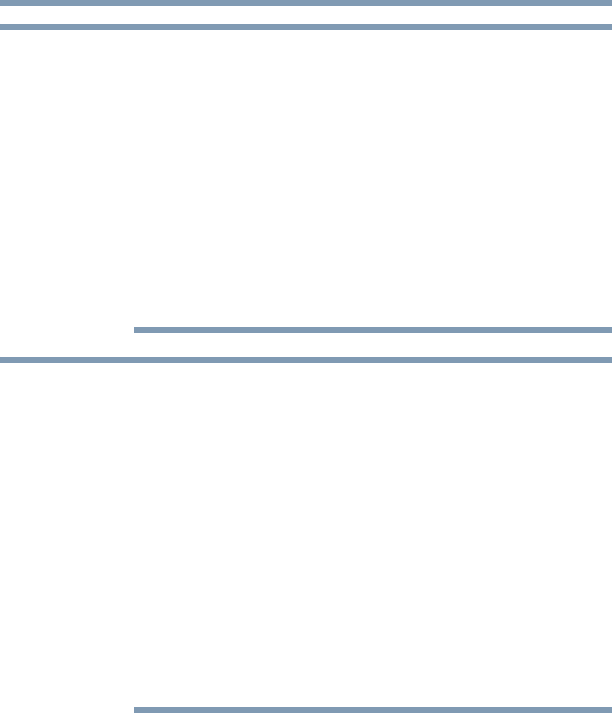
36 Introduction
5.375 x 8.375 ver 2.3
Certain Microsoft® software product(s) included with this
computer may use technological measures for copy protection.
IN SUCH EVENT, YOU WILL NOT BE ABLE TO USE THE
PRODUCT IF YOU DO NOT FULLY COMPLY WITH THE
PRODUCT ACTIVATION PROCEDURES. Product activation
procedures and Microsoft’s privacy policy will be detailed during
initial launch of the product, or upon certain reinstallations of the
software product(s) or reconfigurations of the computer, and may
be completed by Internet or telephone (toll charges may apply).
Some software may differ from its retail version (if available), and
may not include user manuals or all program functionality.
The product specifications and configuration information are
designed for a product Series. Your particular model may not
have all the features and specifications listed or illustrated. For
more detailed information about the features and specifications
on your particular model, please visit Toshiba’s Web site at
pcsupport.toshiba.com.
While Toshiba has made every effort at the time of publication to
ensure the accuracy of the information provided herein, product
specifications, configurations, prices, system/component/
options availability are all subject to change without notice. For
the most up-to-date product information about your computer, or
to stay current with the various computer software or hardware
options, visit Toshiba’s Web site at pcsupport.toshiba.com.
NOTE
NOTE
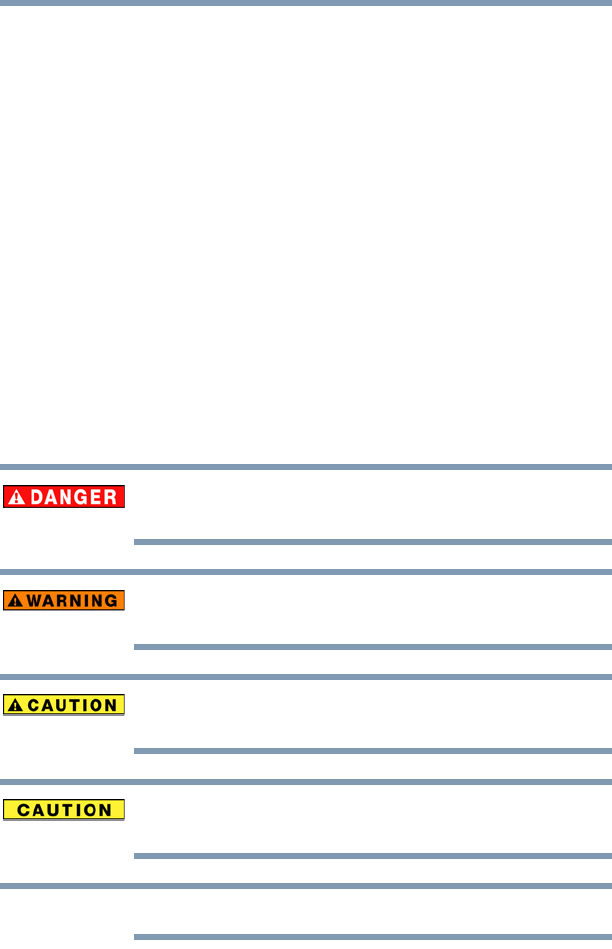
37
Introduction
This guide
5.375 x 8.375 ver 2.3
This guide
This guide introduces the computer’s features. You can:
❖Read the entire guide from beginning to end.
❖Skim through and stop when a topic interests you.
❖Use the table of contents and the index to find specific
information.
Safety icons
This manual contains safety instructions that must be
observed to avoid potential hazards that could result in
personal injuries, damage to your equipment, or loss of data.
These safety cautions have been classified according to the
seriousness of the risk, and icons highlight these instructions
as follows:
Indicates an imminently hazardous situation which, if not
avoided, will result in death or serious injury.
Indicates a potentially hazardous situation which, if not
avoided, could result in death or serious injury.
Indicates a potentially hazardous situation which, if not
avoided, may result in minor or moderate injury.
Indicates a potentially hazardous situation which, if not
avoided, may result in property damage.
Provides important information.
NOTE
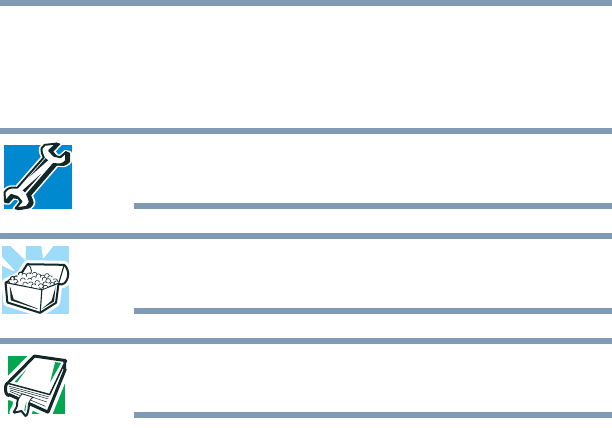
38 Introduction
Other documentation
5.375 x 8.375 ver 2.3
Other icons used
Additional icons highlight other helpful or educational
information:
TECHNICAL NOTE: This icon indicates technical information
about the computer.
HINT: This icon indicates helpful hints and tips.
DEFINITION: This icon indicates the definition of a term used
in the text.
Other documentation
Your computer comes with the following documentation:
❖An electronic version of the user’s guide (this document)
❖It may also contain guides for other programs that may
come with your system.
For accessory information, visit Toshiba’s Web site at
accessories.toshiba.com.

39
Introduction
Service options
5.375 x 8.375 ver 2.3
Service options
Toshiba offers a full line of optional service programs to
complement its limited warranty. Toshiba’s standard limited
warranty, extended warranty, and service upgrade terms and
conditions are available at warranty.toshiba.com.
To stay current on the most recent software and hardware
options for your computer, and for other product information,
be sure to regularly check the Toshiba Web site at
pcsupport.toshiba.com.
If you have a problem or need to contact Toshiba, see “If
Something Goes Wrong” on page 209.

40
5.375 x 8.375 ver 2.3
Chapter 1
Getting Started
This chapter provides tips for working comfortably,
summarizes how to connect components, and explains what
to do the first time you use your notebook computer.
Selecting a place to work
Your computer is portable and designed to be used in a
variety of circumstances and locations.
Creating a computer-friendly environment
Place the computer on a flat surface that is large enough for
the computer and any other items you are using, such as a
printer. Leave enough space around the computer and other
equipment to provide adequate ventilation. Otherwise, they
may overheat.

41
Getting Started
Selecting a place to work
5.375 x 8.375 ver 2.3
To keep your computer in prime operating condition, protect
your work area from:
❖Dust, moisture, and direct sunlight.
❖Equipment that generates a strong electromagnetic field,
such as stereo speakers (other than speakers that are
connected to the computer) or speakerphones.
❖Rapid changes in temperature or humidity and sources of
temperature change such as air conditioner vents or
heaters.
❖Extreme heat, cold, or humidity.
❖Liquids and corrosive chemicals.
Keeping yourself comfortable
The Toshiba Instruction Manual for Safety and Comfort, that
shipped with your computer, contains helpful information for
setting up your work environment and tips for working
comfortably throughout the day.
Precautions
Your computer is designed to provide optimum safety and
ease of use, and to withstand the rigors of travel. You should
observe certain precautions to further reduce the risk of
personal injury or damage to the computer.
❖Avoid prolonged physical contact with the underside or
surface of the computer.
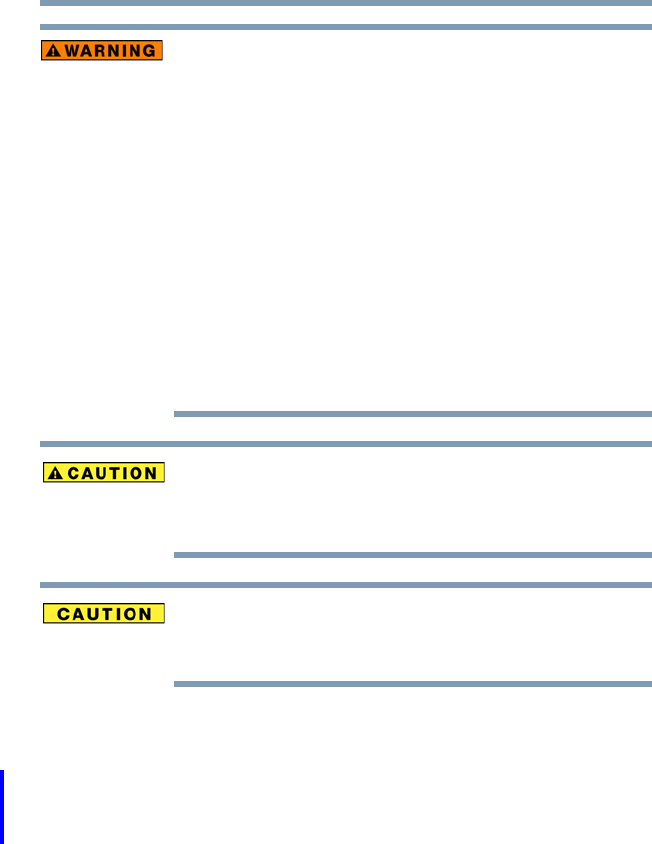
42 Getting Started
Selecting a place to work
5.375 x 8.375 ver 2.3
Never allow any liquids to spill into any part of your computer,
and never expose the computer to rain, water, seawater or
moisture. Exposure to liquid or moisture can cause electric
shock or fire, resulting in damage or serious injury. If any of
these eventualities should accidentally occur, immediately:
1. Turn off the computer.
2. Disconnect the AC adaptor from the power plug socket
and computer.
3. Remove the battery pack.
Failure to follow these instructions could result in seri-
ous injury or permanent damage to the computer.
Do not turn on the power again until you have taken the
computer to an authorized service center.
Computer base and palm rest can become hot! Avoid
prolonged contact to prevent heat injury to skin.
Read the enclosed Instruction Manual for Safety and Comfort.
Never place a heavy object on the computer and be careful not
to drop a heavy object onto the computer. It could damage the
computer or cause system failure.
❖Never turn off the computer if a drive light indicates a
drive is active.
Turning off the computer while it is reading from or
writing to a disk/disc or flash media may damage the
disk/disc or flash media, the drive, or both.
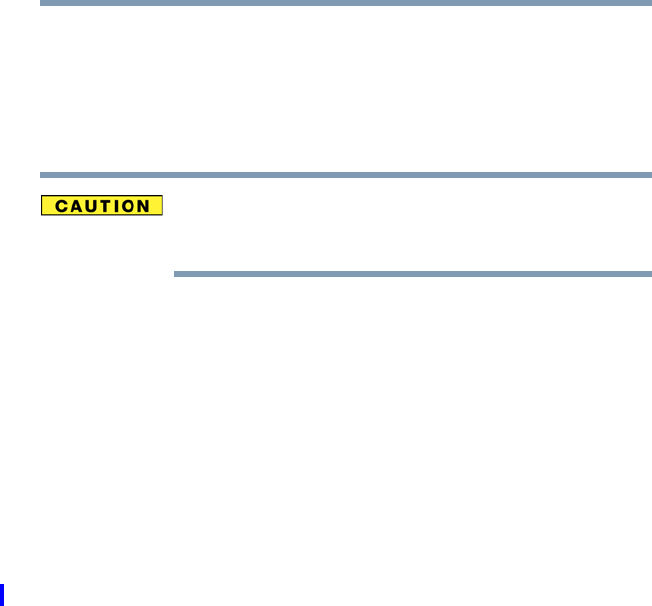
43
Getting Started
Selecting a place to work
5.375 x 8.375 ver 2.3
❖Keep the computer and disks away from objects that
generate strong magnetic fields, such as large stereo
speakers.
Information on disks is stored magnetically. Placing a
magnet too close to a disk can erase important files.
Handle discs carefully. Avoid touching the surface of the disc.
Grasp it by its center hole and edge. If you handle the disc
incorrectly, you could damage the disc and possibly lose data.
❖Scan all new files for viruses.
This precaution is especially important for files you
receive via email or download from the Internet.
Occasionally, even new programs you buy from a
supplier may contain a computer virus. You need a
special program to check for viruses. Ask your dealer to
help you.
Important information on your computer’s cooling fan
Your computer may have a CPU cooling fan that cools the
CPU by drawing outside air into the computer.
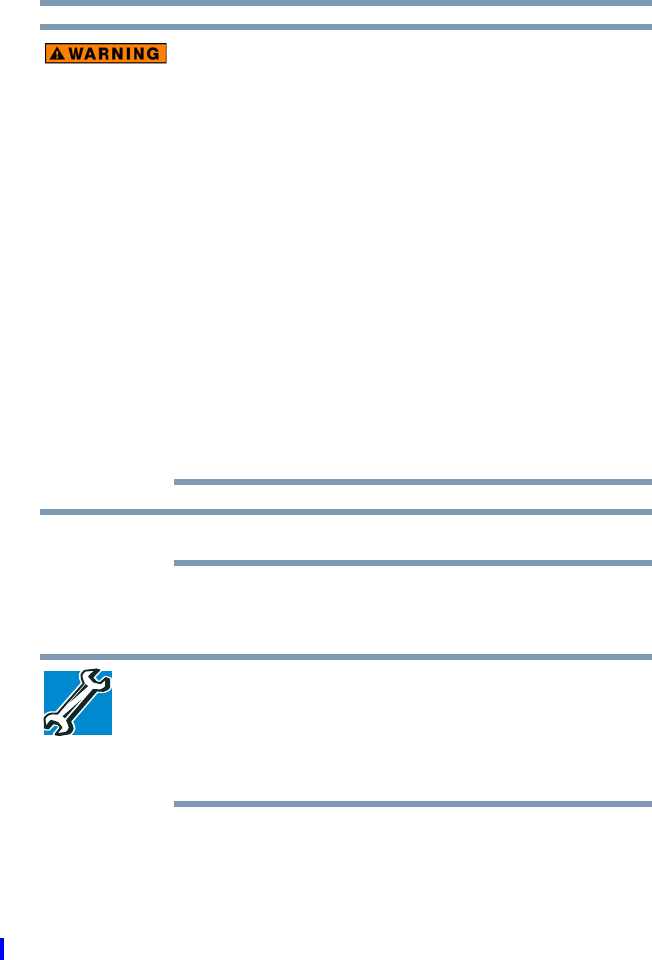
44 Getting Started
Setting up your computer
5.375 x 8.375 ver 2.3
Always make sure your computer and AC adaptor have
adequate ventilation and are protected from overheating when
the power is turned on or when an AC adaptor is connected to
a power outlet (even if your computer is in Standby mode). In
this condition, observe the following:
❖Never cover your computer or AC adaptor with any
object.
❖Never place your computer or AC adaptor near a
heat source, such as an electric blanket or heater.
❖Never block the air vents.
❖Always operate your computer on a hard surface.
Using your computer on a carpet or other soft
material can block the vents.
Overheating your computer or AC adaptor could cause system
failure, computer or AC adaptor damage or a fire, possibly
resulting in serious injury.
The cooling fan location will vary depending on the computer.
Setting up your computer
TECHNICAL NOTE: You must complete all setup steps up to
and including “Setting up your software” on page 45 before
adding external or internal components to your computer.
These components include, but are not limited to, a mouse,
keyboard, printer, memory, and PC Cards.
Your computer contains a rechargeable main battery that
needs to be charged before you can use it.
To use external power or to charge the battery you must
attach the AC adaptor. See “Connecting to a power source”
on page 47.
NOTE
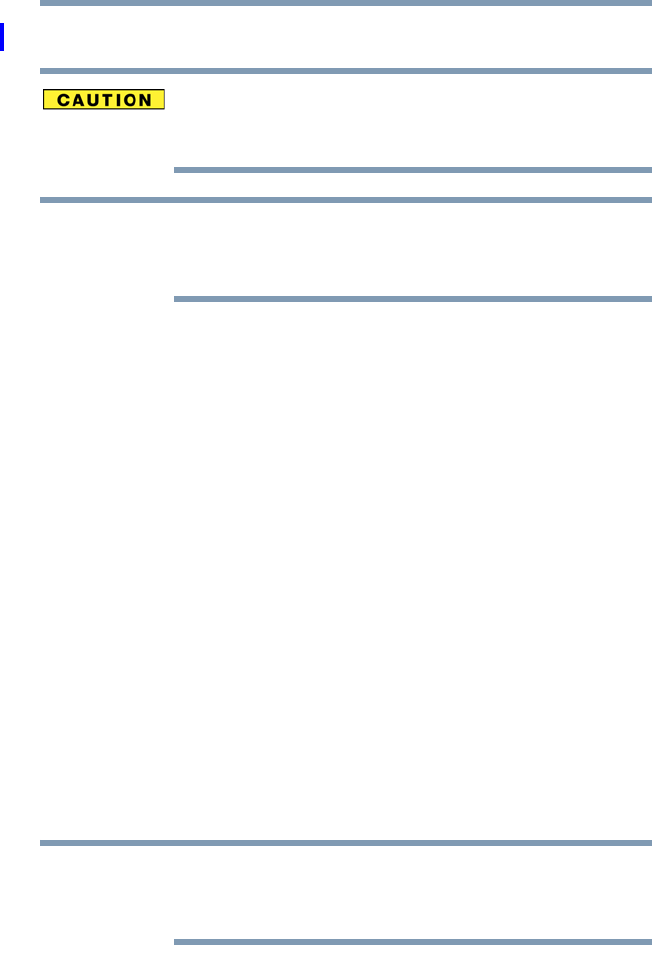
45
Getting Started
Setting up your computer
5.375 x 8.375 ver 2.3
Setting up your software
When you turn on the computer for the first time, do not turn
off the power again until the operating system has loaded
completely.
The names of windows displayed, and the order in which
windows appear, may vary according to your software setup
choices.
The first time you turn on your computer, the Setup Wizard
guides you through steps to set up your software.
1From the Welcome screen click Next to enter the Setup
Wizard.
2Confirm acceptance of Microsoft’s End User License
Agreement and click Next.
3Select the appropriate option from the Help Protect Your
Computer screen and click Next.
4Enter the computer name and description and click Next
or Skip.
5Select how your computer will connect to the Internet
and click Next.
The computer will pause for a moment while checking
for an Internet connection.
If an Internet connection could not be found, a window
will display the message: “An Internet connection could
not be chosen.” Click Next to continue.
If you are connecting your computer to a network, consult your
system administrator before you choose your computer name
and network settings.
NOTE
NOTE

46 Getting Started
Registering your computer with Toshiba
5.375 x 8.375 ver 2.3
6Follow the remaining screen prompts to complete the
setup process.
Once you click the final screen, your computer restarts
automatically.
Registering your computer with Toshiba
Product registration is strongly recommended, and allows
Toshiba to send you periodic updates, announcements, and
special offers applicable to your product. Product registration
can be completed during the initial start up process of your
computer. If you decide not to register at that time, you can
either double-click the icon on your desktop or go to the
Toshiba Web site at www.register.toshiba.com at a later time.
Failure to complete Product Registration will not diminish
Customer rights under the Toshiba limited Warranty.
To register online, you must be connected to the Internet.
Adding optional external devices
Before adding external devices or memory, Toshiba
recommends setting up your software. See “Setting up your
software” on page 45.
After starting your computer for the first time you may want to:
❖Add more memory (see “Adding memory (optional)” on
page 54)
❖Connect a mouse (see “Using a mouse” on page 71)
❖Connect a full-size keyboard (see “Using an external
keyboard” on page 71)
❖Connect an external monitor (see “Using external display
devices” on page 69)
NOTE
NOTE
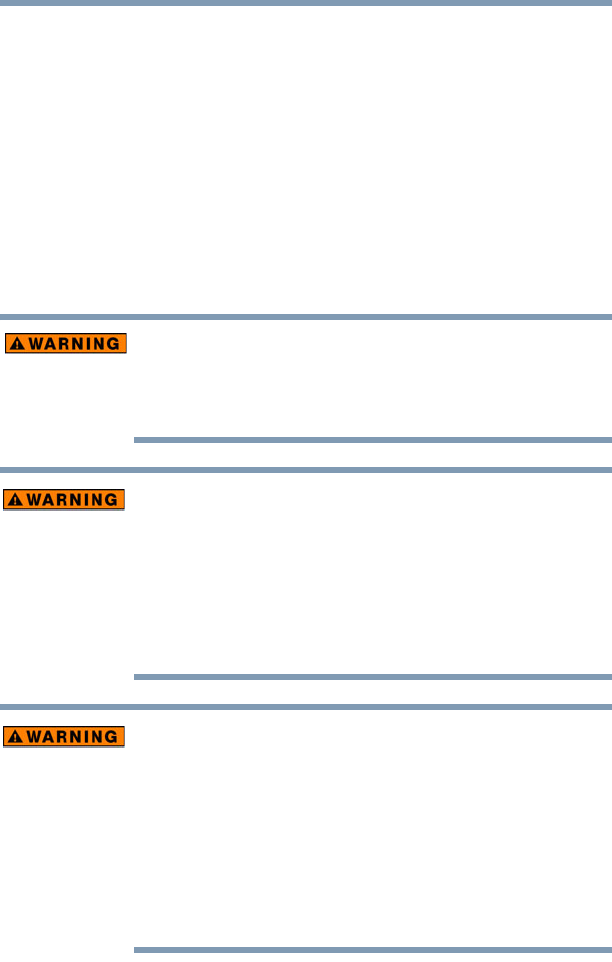
47
Getting Started
Connecting to a power source
5.375 x 8.375 ver 2.3
❖Connect a local printer (see “Connecting a printer” on
page 72)
❖Connect an optional external disk drive (see “Connecting
an optional external diskette drive” on page 74)
❖Install PC Cards (see “Using PC Cards” on page 149)
Connecting to a power source
Your computer requires power to operate. Use the power
cord/cable and AC adaptor to connect the computer to a live
electrical outlet, or to charge the computer’s battery.
Never pull on a power cord/cable to remove a plug from a
socket. Always grasp the plug directly. Failure to follow this
instruction may damage the cord/cable, and/or result in a fire
or electric shock, possibly resulting in serious injury.
Always confirm that the power plug (and extension cable plug
if used) has been fully inserted into the socket, to ensure a
secure electrical connection. Failure to do so may result in a
fire or electric shock, possibly resulting in serious injury.
Be careful if you use a multiple connector. An overload on one
socket could cause a fire or electric shock, possibly resulting
in serious injury.
Always use the TOSHIBA AC adaptor that was provided with
your computer and the TOSHIBA Battery Charger (that may have
been provided with your computer), or use AC adaptors and
battery chargers specified by TOSHIBA to avoid any risk of fire
or other damage to the computer. Use of an incompatible AC
adaptor or Battery Charger could cause fire or damage to the
computer possibly resulting in serious injury. TOSHIBA
assumes no liability for any damage caused by use of an
incompatible adaptor or charger.
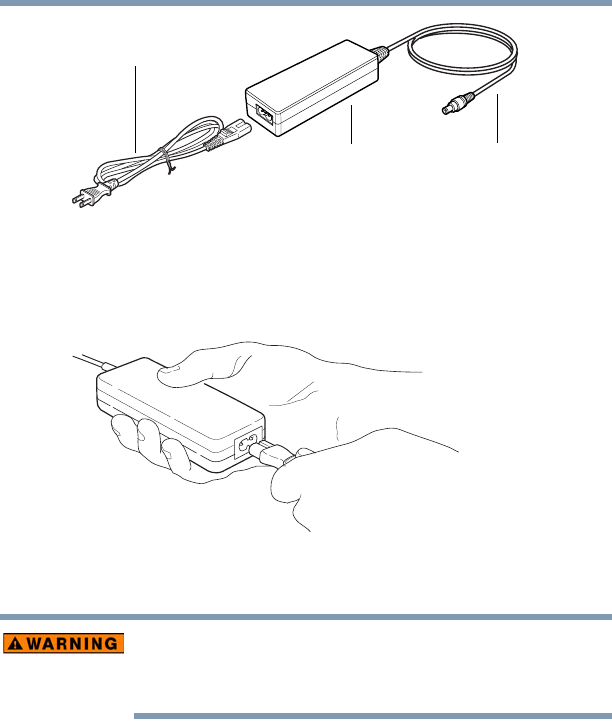
48 Getting Started
Connecting to a power source
5.375 x 8.375 ver 2.3
(Sample Illustration) Power cord/cable and AC adaptor
To connect AC power to the computer:
1Connect the power cord/cable to the AC adaptor.
(Sample Illustration) Connecting the power cord/cable to the
AC adaptor
Handling the cord on this product will expose you to lead, a
chemical known to the State of California to cause birth defects
or other reproductive harm. Wash hands after handling.
Power cord/cable
AC adaptor AC adaptor cord
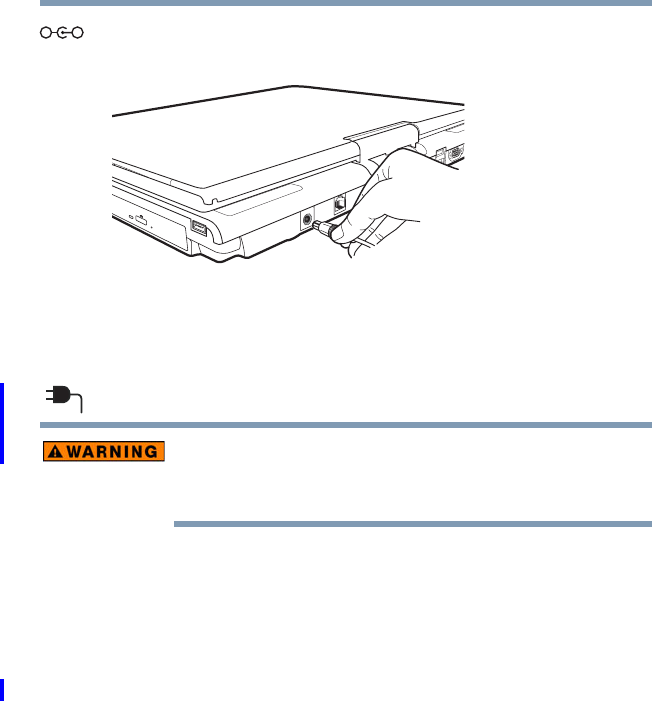
49
Getting Started
Connecting to a power source
5.375 x 8.375 ver 2.3
2Plug the AC adaptor cord into the DC-IN on the back of
the computer.
(Sample Illustration) Connecting the AC adaptor cord to the
computer
3Connect the power cord/cable to a live electrical outlet.
The AC power light on the indicator panel glows green.
Never attempt to connect or disconnect a power plug with wet
hands. Failure to follow this instruction could result in an
electric shock, possibly resulting in serious injury.
The computer’s main battery light gives you an indication
of the main battery’s current charge:
❖Glows amber while the main battery is being charged
(AC adaptor connected)
❖Glows green when the main battery is fully charged
❖Is unlit when the main battery has discharged, the
battery is not charging, or the AC adaptor is not
plugged into the computer or AC outlet
❖Flashes amber when the main battery charge is low
and it is time to recharge the main battery or plug in
the AC adaptor
_
+
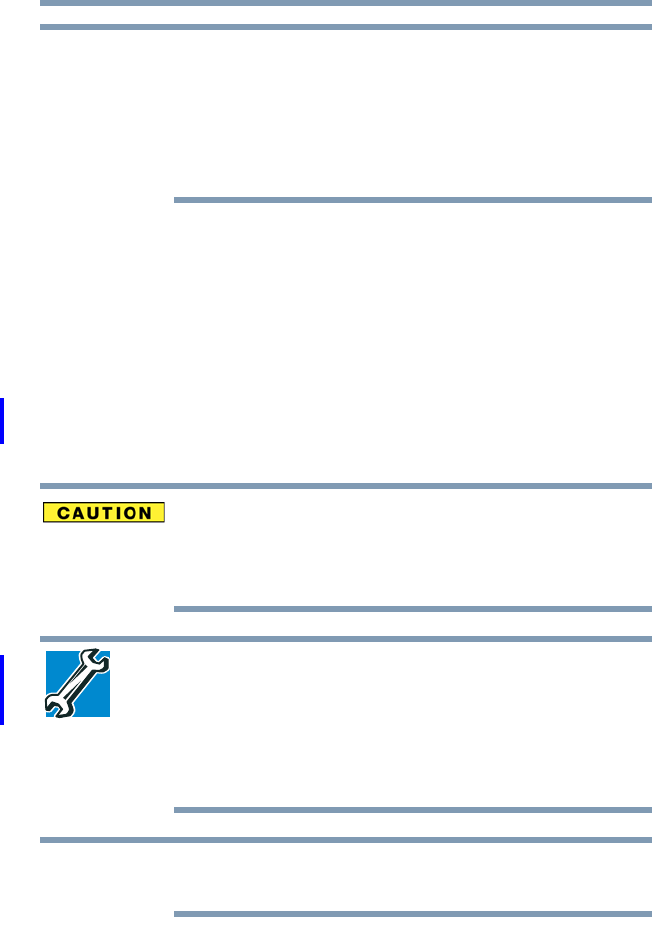
50 Getting Started
Charging the main battery
5.375 x 8.375 ver 2.3
If the AC power light flashes amber during charging,
either the main battery is malfunctioning, or it is not
receiving correct input from the AC power supply.
Disconnect the AC power cord/cable and remove the
main battery pack. See “Changing the main battery” on
page 121 for information on replacing the main battery.
Charging the main battery
Your computer came with its battery already installed. Before
using the battery to power the computer, you must charge the
battery.
To charge the battery, leave the computer plugged into an AC
power source with the computer turned off until the battery
light glows green. After that, the battery will be completely
charged and ready to power the computer.
Once the battery is charged for the first time, avoid leaving the
computer plugged in and turned off for more than a few hours
at a time. Continuing to charge a fully charged battery can
damage the battery.
TECHNICAL NOTE: The recharging of the battery cannot occur
when your computer is using all of the power provided by the
AC adaptor to run applications, features, and devices. Your
computer’s Power Saver utility can be used to select a power
level setting that reduces the power required for system
operation and will allow the battery to recharge.
Battery life and charge time may vary depending on the
applications, power management settings, and features used.
NOTE
NOTE
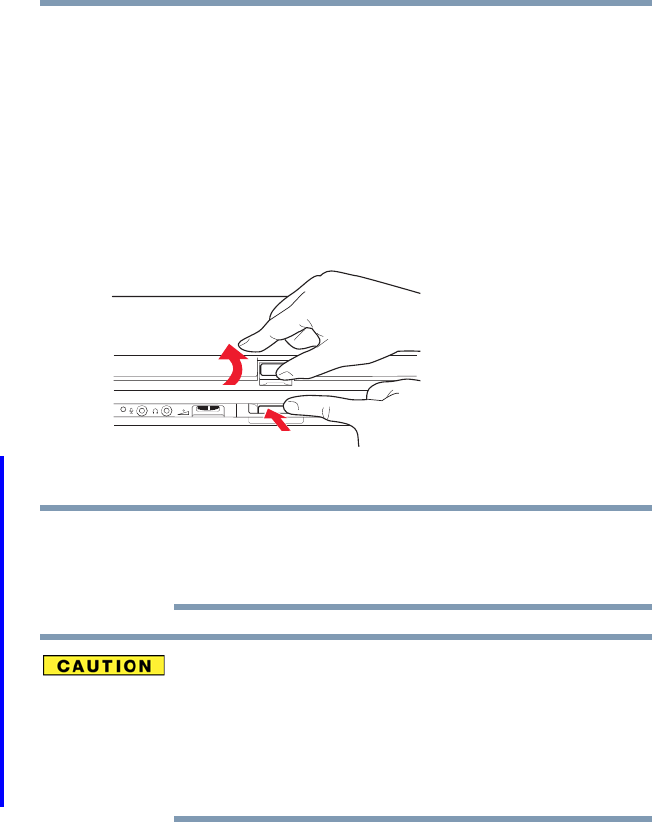
51
Getting Started
Using the computer for the first time
5.375 x 8.375 ver 2.3
Using the computer for the first time
The computer is now ready for you to turn it on and begin
using it.
Opening the display panel
1Slide the display latch to the right.
2Lift the display panel.
(Sample Illustration) Opening the display panel
When opening or closing the LCD display panel, place one
hand on the palm rest to hold the computer in place and use
the other hand to slowly open or close the LCD display panel.
To avoid damaging the LCD display panel, do not force it
beyond the point where it moves easily and never lift the
computer by the LCD display panel.
Do not press or push on the LCD display panel and be careful
to remove any pens or other objects from the keyboard area
before closing the LCD display panel.
NOTE
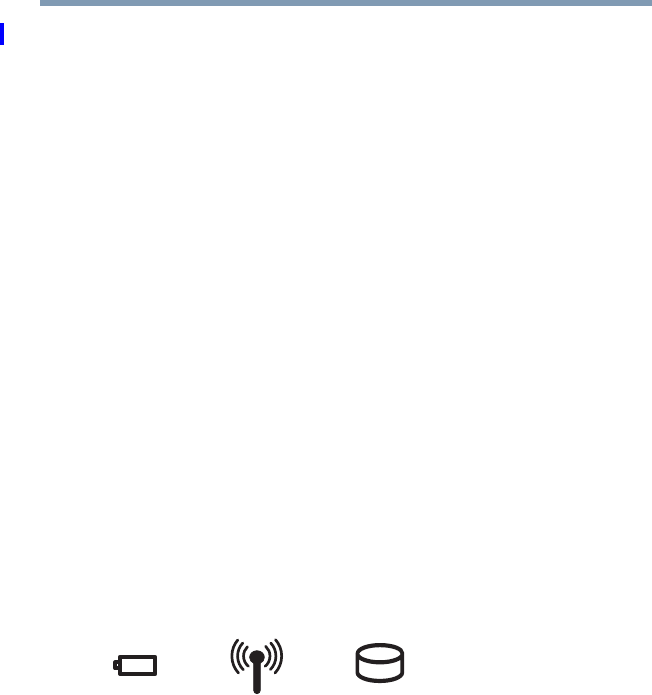
52 Getting Started
Using the computer for the first time
5.375 x 8.375 ver 2.3
Small bright dots may appear on your screen display when
you turn on your computer. Your display contains an
extremely large number of thin-film transistors (TFT) and is
manufactured using high-precision technology. Any small
bright dots that may appear on your display are an intrinsic
characteristic of the TFT manufacturing technology. Over a
period of time, and depending on the usage of the computer,
the brightness of the screen will deteriorate. This is also an
intrinsic characteristic of the screen technology. When the
computer is operated on battery power, the screen will dim
and you may not be able to increase the brightness of the
screen while on battery power.
Your computer’s features and specifications
Certain notebook chassis are designed to accommodate all
possible configurations for an entire product Series. Your
select model may not have all the features and specifications
corresponding to all of the icons or switches shown on the
notebook chassis, unless you have selected all those features.
This information applies to all the features and icons
described in this guide.
Below are examples of some of the many possible icons used
on your computer:
(Sample Illustration) System icons
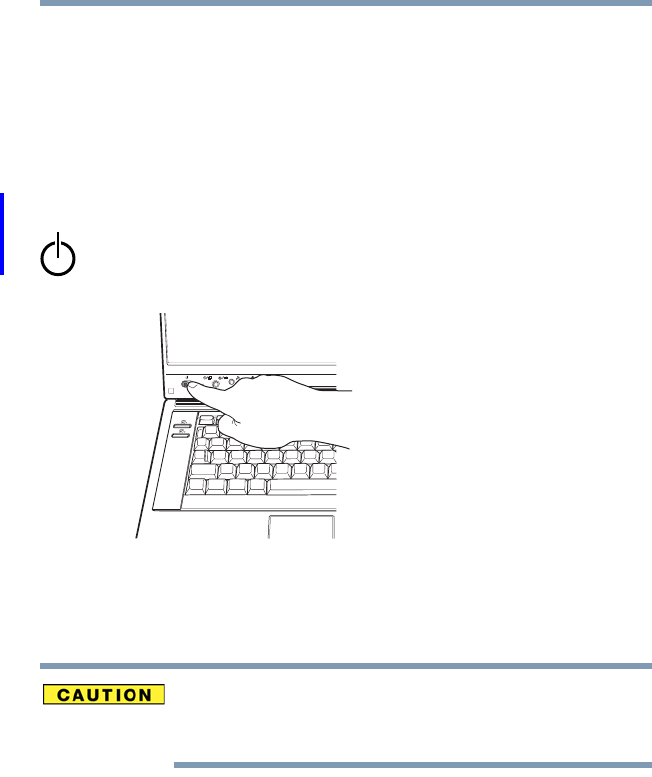
53
Getting Started
Using the computer for the first time
5.375 x 8.375 ver 2.3
Turning on the power
To turn on the computer:
1Make sure any external devices (such as the AC adaptor,
if you plan to use AC power rather than battery power)
are properly connected and ready.
2Check to ensure that all optical drives are empty.
3Slide and hold the power switch until the on/off light on
the system indicator panel glows green—about one
second.
(Sample Illustration) Turning on the power
The preinstalled operating system will load
automatically.
When you turn on the computer for the first time, do not turn
off the power again until the operating system has loaded
completely.
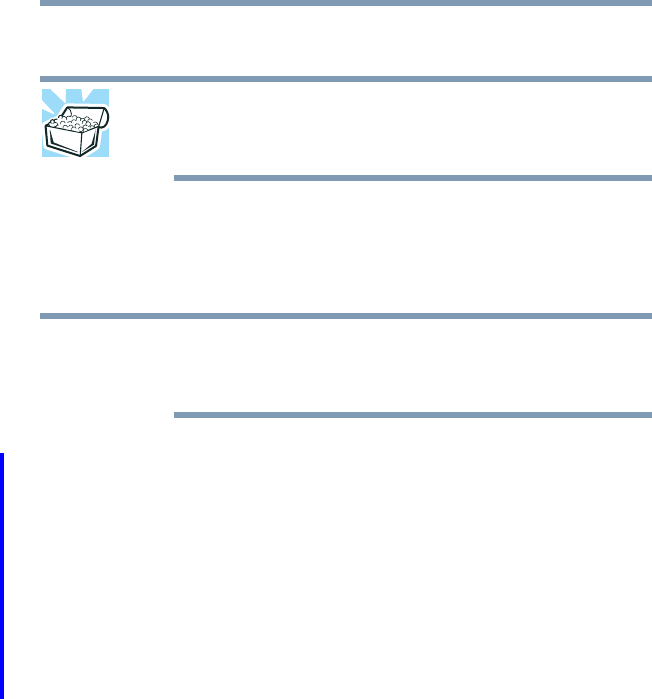
54 Getting Started
Adding memory (optional)
5.375 x 8.375 ver 2.3
Adding memory (optional)
HINT: To purchase additional memory modules, see the
accessories information packaged with your system or visit
accessories.toshiba.com.
Your computer comes with enough memory to run most of
today’s popular applications. You may want to increase the
computer’s memory if you use complex software or process
large amounts of data.
Before adding external devices or memory, Toshiba
recommends setting up your software. See “Setting up your
software” on page 45.
Installing a memory module
Your computer has two memory module slots. Both slots are
located under the keyboard and should only be accessed by a
Toshiba authorized service provider.
If you are a technically advanced user, visit
pcsupport.toshiba.com for information. Toshiba will not be
responsible for any product damage, data loss, service or part
replacement made necessary by improper installation of a
memory module.
NOTE

55
Getting Started
Hard Drive Recovery Utilities
5.375 x 8.375 ver 2.3
Hard Drive Recovery Utilities
Your computer has been configured with a hard disk partition
to allow you to recover your hard disk drive or reinstall
selected applications and software features or utilities.
It is strongly recommended that you create recovery CDs/
DVDs before using your system. For more information on
creating Recovery media see “Creating Recovery CDs/DVDs”
on page 55.
Using the HDD Recovery, you can:
❖Create Hard Drive Recovery CDs or DVDs using a
writable drive.
❖Recover your hard disk drive to the factory-set default.
❖Recover just your C: drive, leaving any other partitions
you may have created intact, for example, a D: drive.
❖Recover your hard disk drive to the factory-set default
without the HDD Recovery partition.
❖Delete your hard disk drive recovery partition without the
risk of losing your data.
❖Reinstall drivers and applications which were bundled
with your computer.
Creating Recovery CDs/DVDs
Depending on your system configuration, you may be able to
copy the Hard Drive Recovery Utilities to CD or DVD which
gives you the ability to recover your hard disk drive and
reclaim additional hard disk space used to store the Hard
Drive Recovery Utilities on your computer.
NOTE
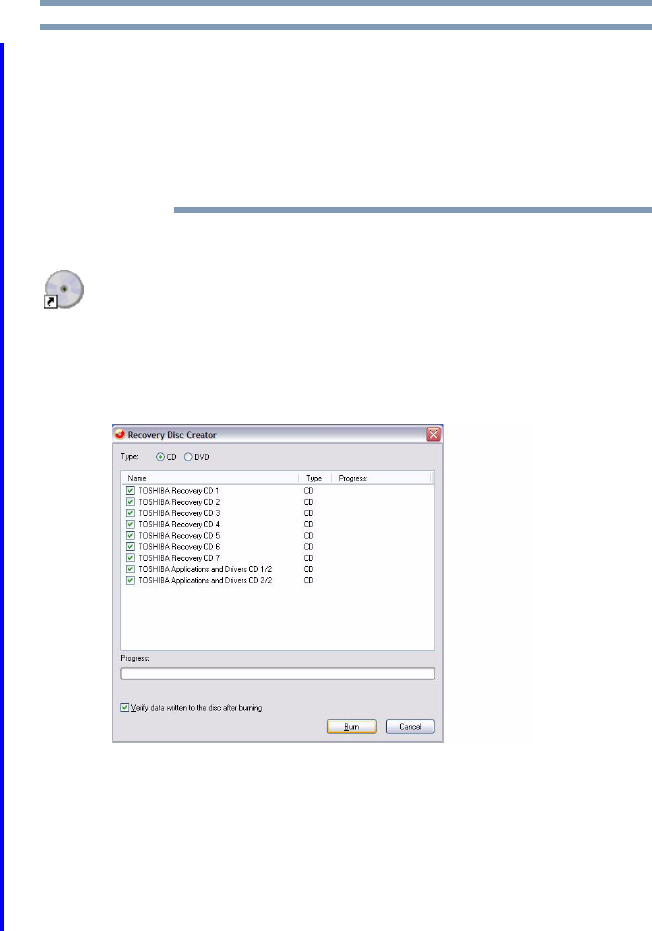
56 Getting Started
Hard Drive Recovery Utilities
5.375 x 8.375 ver 2.3
The system will prompt you to insert the appropriate number of
blank CDs or DVDs to copy the Hard Drive Recovery Utilities. If
your optical disc drive is not writable, contact Toshiba Customer
Support to obtain the Recovery media for your system.
The Toshiba Global Support Centre in the United States is
(800) 457-7777, outside the United States it is (949) 859-4273.
To create recovery CDs/DVDs:
1Double-click the Recovery Disc Creator icon on the Windows
desktop. You can also launch the application by clicking
Start, All Programs, then Recovery Disc Creator.
2Select CD or DVD (to create Recovery media on CDs or
DVDs).
(Sample Image) Recovery Disc Creator screen
3Select the items you want to copy by clicking the check
box next to the item’s Name – recovery files, applications
(original bundled drivers and applications), or both the
recovery files and applications.
4Click Burn.
NOTE
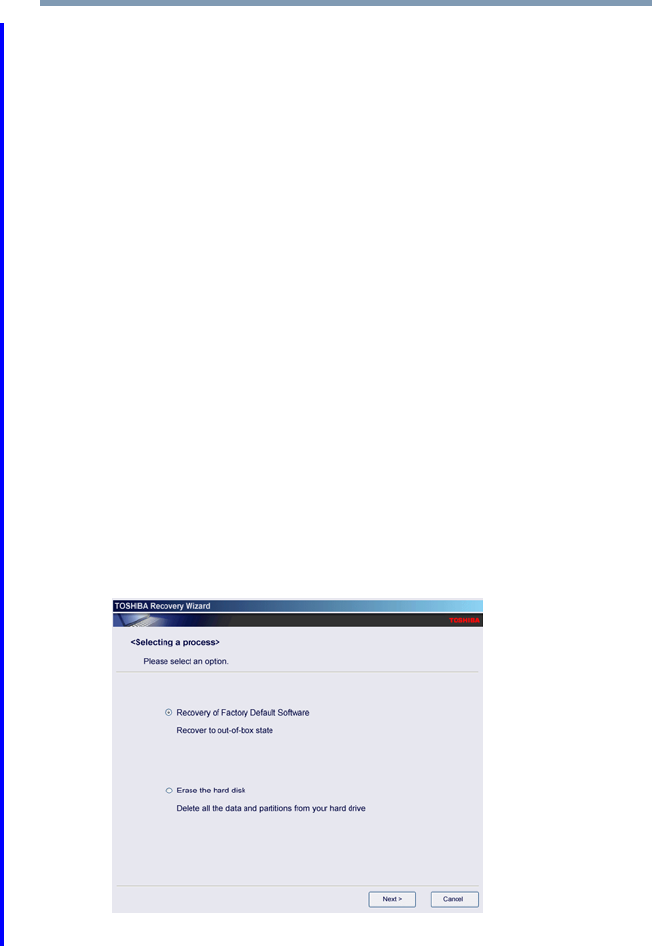
57
Getting Started
Hard Drive Recovery Utilities
5.375 x 8.375 ver 2.3
5Insert the first blank CD or DVD into your computer’s
CD/DVD writable drive when prompted.
6Follow the on-screen prompts for completing the copy
process.
For more information on using the Recovery media you have
created with the preceding steps see “Hard Disk Drive
Recovery using the Recovery media” on page 62.
Hard Disk Drive Recovery using the recovery partition
You have the options of recovering your system using the
Hard Drive Recovery partition to the factory-set default, or
recovering just your C: drive and leaving other partitions (for
example, a D: drive) intact, or changing the size of your C:
drive and then recovering it.
To recover your hard disk drive using the utilities stored on
your computer’s HDD:
1Make sure the computer is turned off.
2Press and hold the 0 (zero) key on your keyboard while
powering on the computer. When the computer powers on,
the Toshiba Recovery Wizard screen displays.
(Sample Image) Toshiba Recovery Wizard screen
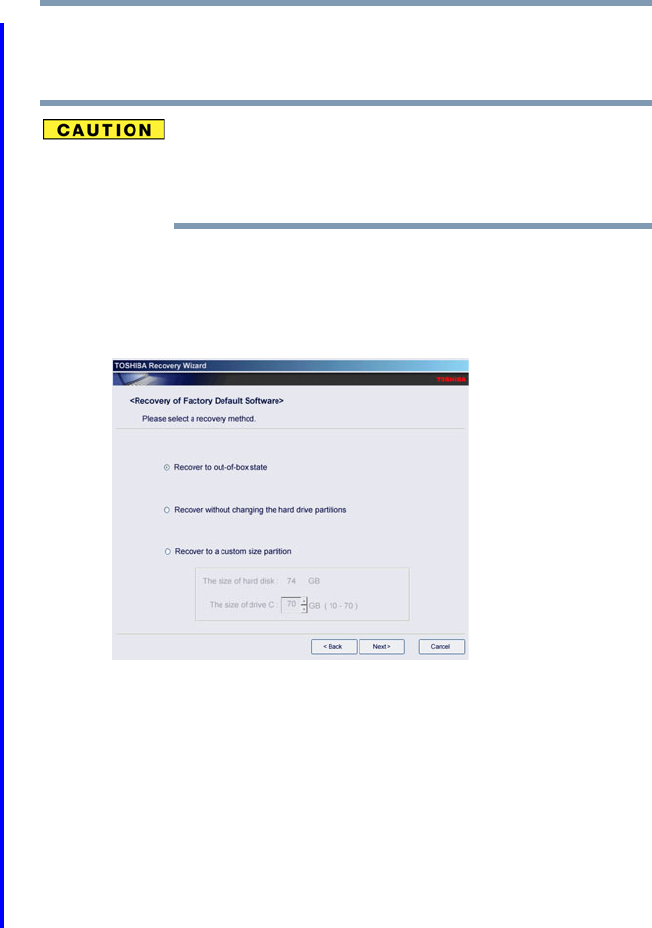
58 Getting Started
Hard Drive Recovery Utilities
5.375 x 8.375 ver 2.3
Recovering the original factory image
(recommended recovery method)
Recovering a hard disk drive to its factory default setting
deletes all partitions on the hard disk drive and your
information will be lost. Be sure to save your work to external
media first.
1On the Toshiba Recovery Wizard screen, select Recovery of
Factory Default Software, then click Next.
The Recovery of Factory Default Software screen appears.
(Sample Image) Recovery of Factory Default Software screen
2Select Recover to out-of-box-state, then click Next.
A confirmation message displays reminding you that all
data will be lost during the recovery process. Be sure to
save your work to external media before proceeding.
3Click Next to begin the recovery. Once complete, a
message displays that the HDD has been recovered.
4Press any key on the keyboard to restart the computer.
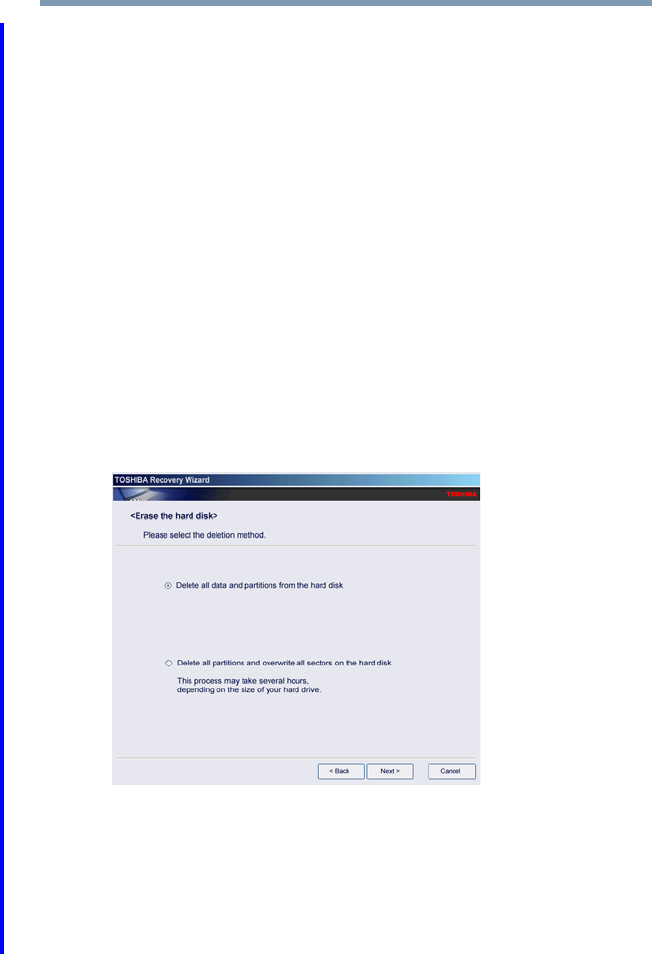
59
Getting Started
Hard Drive Recovery Utilities
5.375 x 8.375 ver 2.3
Erasing the hard disk
The Recovery Wizard allows you to delete all data and
partitions from the hard disk.
To delete the data and partitions from your hard disk:
1On the Toshiba Recovery Wizard screen, select Erase the
hard disk, then click Next.
2The next screen lists the two methods you can choose:
❖Delete all data and partitions from the hard disk—
This option deletes all of the data on the hard disk without
overwriting the HDD.
❖Delete all partitions and overwrite all sectors on the
hard disk—This option deletes all data, then overwrites
the entire HDD for security purposes. This may take
several hours, depending on the size of your HDD.
(Sample Image) Erase the hard disk screen
3Select the desired method, then click Next.
A confirmation message displays reminding you that all
data will be lost. Be sure you have saved your work to
external media before proceeding.
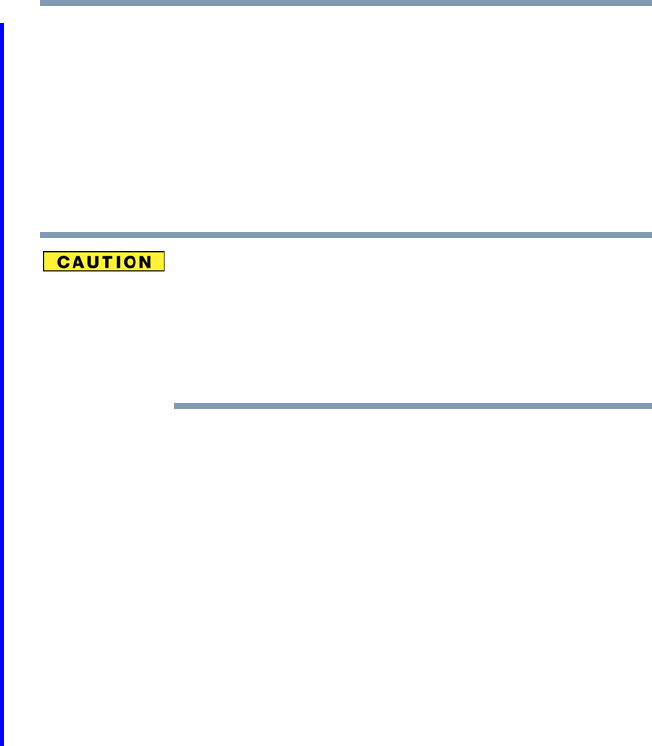
60 Getting Started
Hard Drive Recovery Utilities
5.375 x 8.375 ver 2.3
4Click Next to begin deleting the HDD. When the process
is completed, a message displays informing you that the
HDD has been deleted.
5Press any key on the keyboard to restart the computer.
Recovering the C: partition of the HDD without
changing the current partition size
Recovering the C: drive to its factory default setting reformats
your drive and your information on the recovered drive will be
lost. Be sure to save your work to external media first. If you
have created other partitions (for example, a D: drive) those
partitions and any information on them will not be affected and
will remain intact.
To recover only your C: drive:
1On the Toshiba Recovery Wizard Screen, select “Recovery of
factory default.” Then, click Next.
2Select “Recover without changing the hard drive
partitions.” A confirmation message appears, reminding
you that all information on the C: drive will be lost during
the recovery process. Be sure you have saved your work
to external media before proceeding.
3Click Next to begin the restoration. Once complete, a
message displays that the HDD has been recovered.
4Press any key on your keyboard to restart the computer.
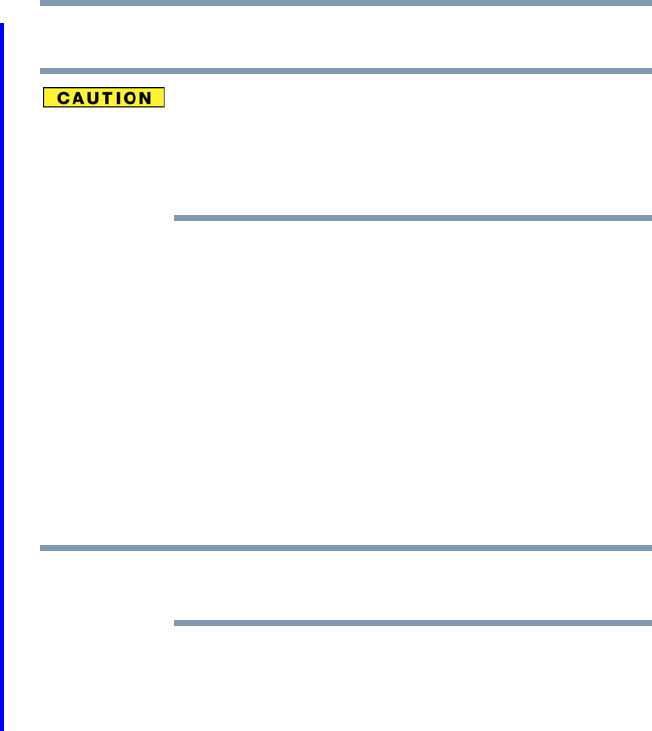
61
Getting Started
Hard Drive Recovery Utilities
5.375 x 8.375 ver 2.3
Recovering the C: partition with a user specified size
Resizing and recovering your C: drive to its factory default
setting reformats all partitions on the HDD (for example, if you
created a D: drive, it will be deleted during the recovery
process) and your information will be lost. Be sure to save
your work to external media first.
To resize and recover your C: drive:
1On the Toshiba Recovery Wizard screen, select “Recovery of
factory default.” Then, click Next.
2Select “Recover to a custom size partition.”
3Specify the size of the C: drive.
❖Press the Left/Right Arrow keys to increase/decrease the
C: drive size by 1 GB.
❖Press the Up/Down Arrow keys to increase/decrease the
C: drive size by 5 GB.
The size of the C: drive will display on the progress bar as you
make your selections.
4Click Next to begin the restoration. Once complete, a
message displays that the HDD has been recovered.
5Press any key on your keyboard to restart the computer.
NOTE
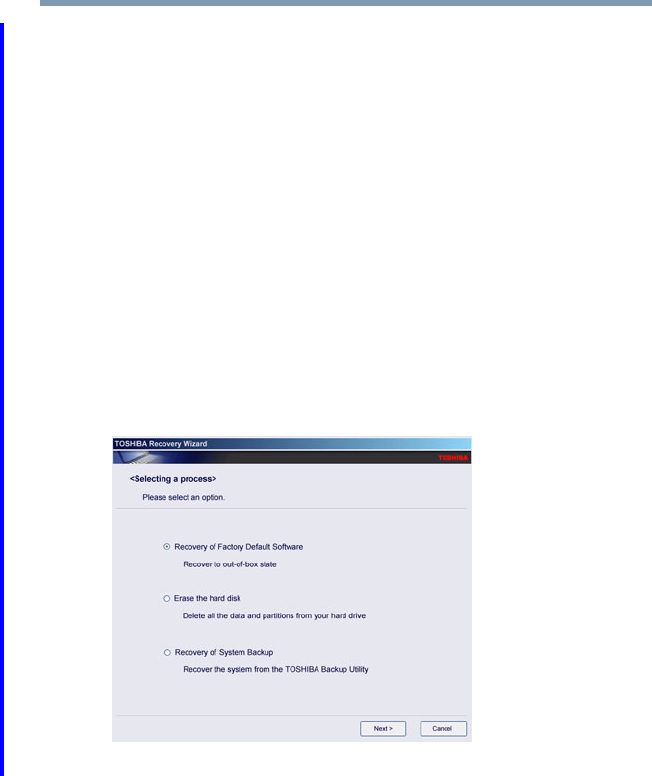
62 Getting Started
Hard Drive Recovery Utilities
5.375 x 8.375 ver 2.3
Hard Disk Drive Recovery using the Recovery media
If you need to recover your computer to its default factory
state, you can rebuild the system using your Hard Drive
Recovery Utilities.
To recover your hard disk drive using the utilities burned to
CDs or DVDs (refer to “Creating Recovery CDs/DVDs” on
page 55):
1Insert the first recovery CD or DVD into your CD/DVD
drive and power on the computer.
2When the initial screen displays, press F12.
The boot menu appears.
3Using the arrow keys, select the CD/DVD option and
press Enter.
(Sample Image) Toshiba HDD Recovery Utility screen
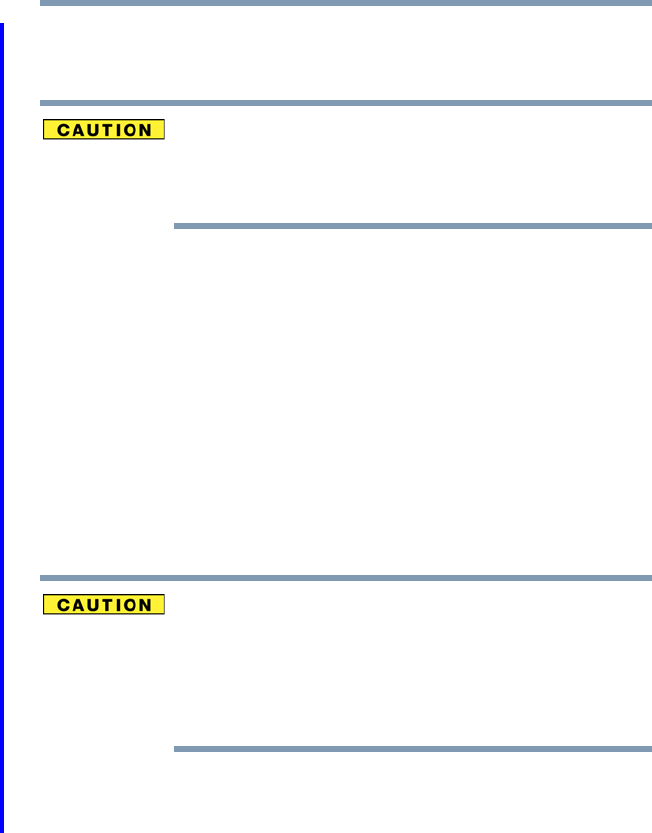
63
Getting Started
Hard Drive Recovery Utilities
5.375 x 8.375 ver 2.3
Recovering the original factory image
(recommended recovery method)
Recovering a hard disk drive to its factory default setting
deletes all partitions on the hard disk drive and your
information will be lost. Be sure to save your work to external
media first.
1Select “Recovery of Factory Default Software.” Click Next.
2Select “Recover to out-of-the-box-state.” Click Next. A
confirmation message displays, reminding you that all
data will be lost during the recovery process. Be sure you
have saved your work to external media before
proceeding.
3Click Next to begin the recovery process. Once complete,
a message displays that the HDD has been recovered.
4Press any key on the keyboard to restart the computer.
Recovering the C: partition of the HDD only
Recovering the C: drive to its factory default setting reformats
your drive and your information on the recovered drive will be
lost. Be sure to save your work to external media first. If you
have created other partitions (for example, a D: drive) those
partitions and any information on them will not be affected and
will remain intact.
To recover only your C: drive:
1Select “Recovery of Factory Default Software.” Click Next.
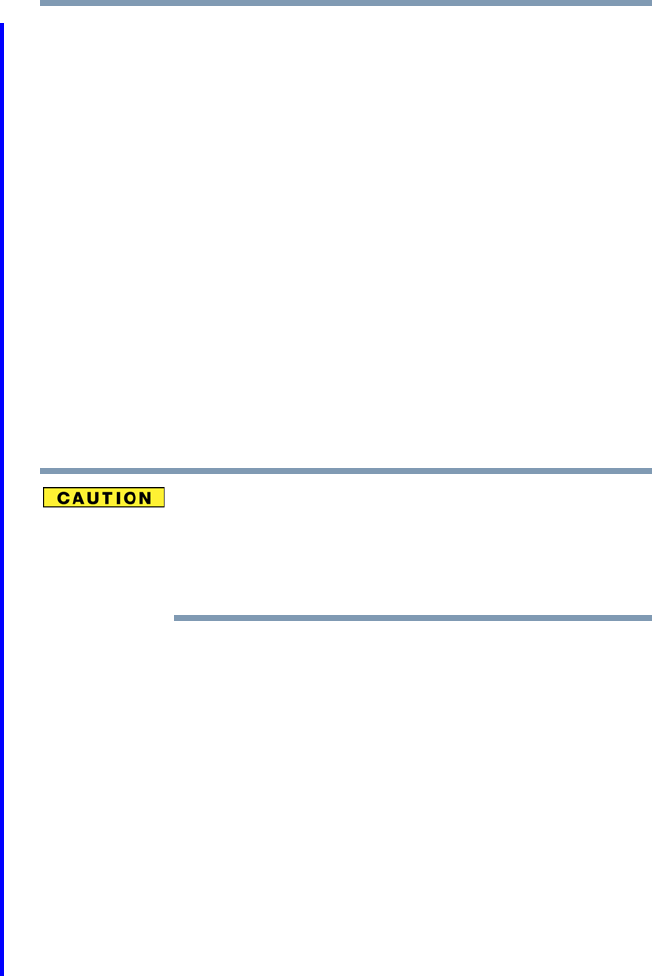
64 Getting Started
Hard Drive Recovery Utilities
5.375 x 8.375 ver 2.3
2Select “Recover without the hard drive partitions.” Click
Next.
❖A confirmation message appears, reminding you that all
information on the C: drive will be lost during the
recovery process. Be sure you have saved your work to
external media before proceeding.
3Click Next to begin the restoration. Once complete, a
message displays that the HDD has been recovered.
4Press any key on your keyboard to restart the computer.
Recovering the entire HDD without the HDD
Recovery Area
This option recovers your C: drive without creating the HDD
Recovery Utilities partition. This will increase the size of
your C: drive
Recovering your C: drive to its factory default state without the
recovery partition reformats all partitions on the HDD (for
example, if you created a D: drive, it will be deleted during the
recovery process) and your information will be lost. Be sure to
save your work to external media first.
To recover your C: drive without the recovery partition:
1Select “Recovery of Factory Default Software.” Click Next.
2Select “Recover using all HDD space (no HDD recovery
partition).” Click Next.
❖A confirmation message appears, reminding you that all
partitions will be reformatted and all data will be lost
during the recovery process. Be sure you have saved your
work to external media before proceeding.
3Click Ye s to begin the restoration. Once complete, a
message displays that the HDD has been recovered.
4Press any key on your keyboard to restart the computer.
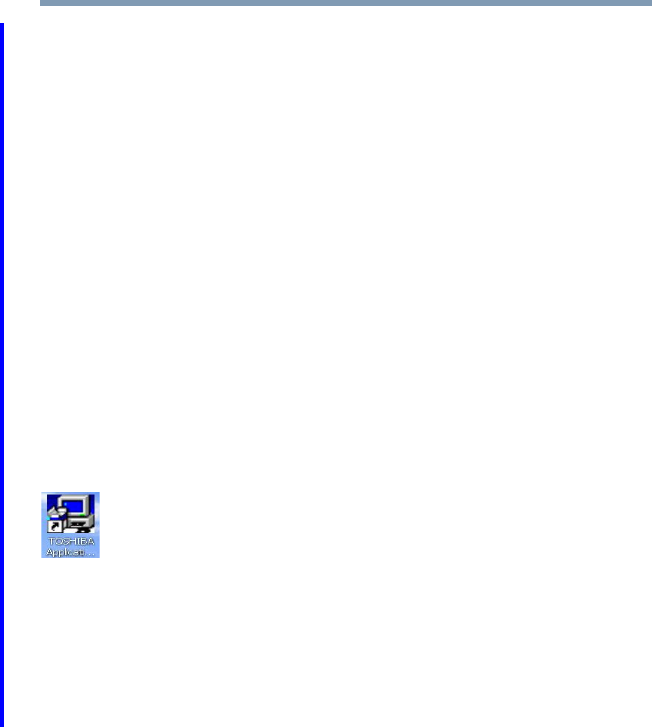
65
Getting Started
Hard Drive Recovery Utilities
5.375 x 8.375 ver 2.3
Checking the HDD operating status
After restoring your hard disk drive, you can check its status
as follows:
1Click Start, and then click Control Panel.
2Double-click the Administrative Tools icon.
3Double-click the Computer Management icon.
4Click Disk Management.
5Highlight the hard disk drive in the Volume list to display
its status in the lower portion of the screen.
Installing drivers and applications
The Toshiba Application Installer allows you to reinstall the
drivers and applications that were originally bundled with
your computer.
To reinstall drivers and applications:
1Double-click the Toshiba Application Installer icon on the
Windows desktop.
2Click Next.
3Click the item(s) you want to install.
4Click Install.
5Follow the on-screen prompts to complete the installation
process.

66 Getting Started
Using the TouchPad™
5.375 x 8.375 ver 2.3
Using the TouchPad™
The TouchPad™, the small, smooth, square cutout located in
front of the keyboard, is sensitive to touch and enables you to
move the cursor with the stroke of a finger. Simply move
your finger on the TouchPad in the direction you would like
to move the cursor:
❖To move the cursor to the top of the page, push your
finger forward on the TouchPad.
❖To move the cursor to the bottom of the page, drag your
finger toward yourself.
❖To move the cursor to the right side of the page, slide
your finger across the TouchPad from left to right.
❖To move it to the left side, slide your finger from right to
left.
Because the TouchPad is much smaller than the display
screen, moving your cursor across the screen often means
having to move your finger several times across the TouchPad
in the preferred direction.
Once you have positioned your cursor, you can click it into
place by either double-tapping the TouchPad or clicking the
control buttons.
NOTE

67
Getting Started
Using the TouchPad™
5.375 x 8.375 ver 2.3
Scrolling with the TouchPad™
There are two active regions on the TouchPad™ that allow you
to scroll as you would with any wheel device on a mouse or
trackball.
To scroll vertically, run your finger up or down along the right
edge of the TouchPad. To scroll horizontally, run your finger
along the bottom edge of the TouchPad. This feature can be
disabled or changed in the Mouse Properties dialog box.
Control buttons
When a step instructs you to click or choose an item, move
the cursor to the item, then press and release the primary
(left-hand) button. To double-click, press the primary button
twice in rapid succession. The primary button usually
corresponds to the left mouse button.
The function of the secondary (right-hand) button depends on
the program you are using. It usually corresponds to the right
mouse button (“right-clicking”). Check your program’s
documentation to determine whether it uses the right mouse
button.
Disabling or enabling the TouchPad™
The TouchPad™ is enabled by default. To change the enable/
disable TouchPad setting:
1Click Start, and then Control Panel.
The Control Panel window appears.
2Click Printers and Other Hardware.
3Click the Mouse icon.
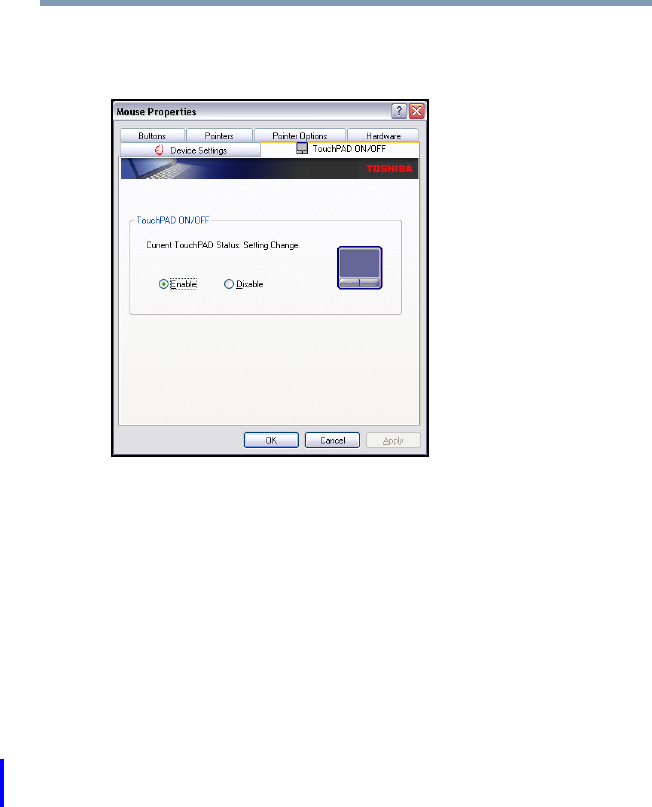
68 Getting Started
Using the TouchPad™
5.375 x 8.375 ver 2.3
4Click the TouchPAD ON/OFF tab.
The TouchPAD ON/OFF tab view window appears.
(Sample Image) TouchPAD ON/OFF screen
5Select Disable or Enable, whichever is appropriate.
6Click Apply.
7Click OK.
The Mouse Properties window closes.
8Close the Printers and Other Hardware window.
9Close the Control Panel window.
You can also use a hot key to disable or enable the
TouchPad. See “Disabling or enabling the TouchPad” on
page 261.

69
Getting Started
Using external display devices
5.375 x 8.375 ver 2.3
Using external display devices
Your computer comes with a built-in LCD display, but you
can also connect an external display device to an available
video port, as follows:
❖An external monitor or projector via the RGB (monitor) port
❖A TV, VCR, or DVD recorder via the S-video (TV-out) port
Before connecting an external monitor or video projector,
configure your computer for the type of device you are
connecting. To do this, refer to the documentation for your
operating system and devices.
Connecting an external monitor or projector
You can easily attach an external monitor or projector to your
computer if you need a larger screen. To do this:
1Connect the monitor’s video cable to the RGB (monitor)
port on the left side of the computer.
2Connect the device’s power cable to a live electrical
outlet.
3Turn on the external device.
4Set the display mode by pressing Fn + F5, or by
configuring the Display Properties settings.
Directing the display output when you turn on the computer
Once you have connected an external display device, you can
choose to use the internal display only, the external device
only, or both simultaneously. The quickest way to change the
display output settings is to use the display hot key (Fn + F5):
1Press Fn and F5 simultaneously.
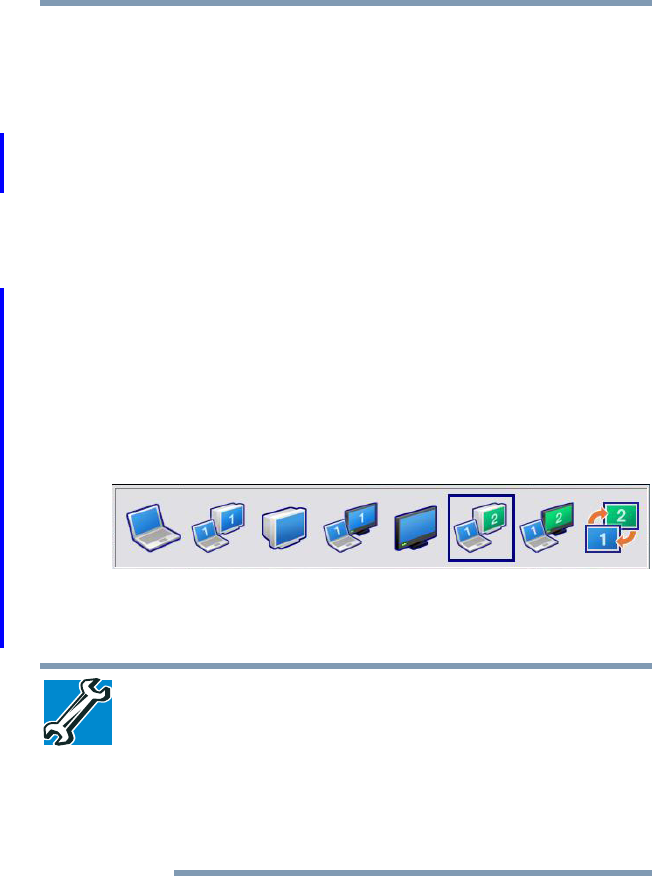
70 Getting Started
Using external display devices
5.375 x 8.375 ver 2.3
2While holding down Fn, press F5 repeatedly until the
setting you want takes effect. Briefly pause each time you
press the F5 key to allow time for the display to change.
This hot key cycles through the settings in the following
order:
❖Built-in display only
❖Built-in display and external monitor simultaneously
❖External monitor only
❖TV and built-in display
❖TV only
❖Primary and CRT
❖Dual Mode display
❖Swap image display
(Sample Image) Display options window
3Release the Fn key.
TECHNICAL NOTE: You can also change these settings using
the Display Properties box.
Set the option for the video controller by clicking Start,
Control Panel, Appearance and Themes, and then Display.
Choose the Settings tab, click the Advanced button, select
Display Device, select the applicable Monitor type, and then
click Apply or OK.
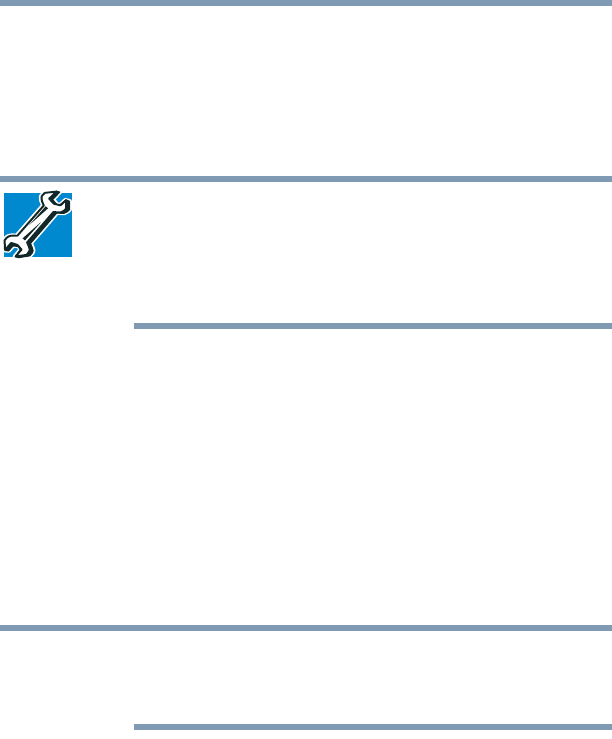
71
Getting Started
Using an external keyboard
5.375 x 8.375 ver 2.3
Adjusting the quality of the external display
To obtain the best picture quality from your television (or
other video display device), you may need to adjust the video
settings. See the video device documentation for additional
configuration steps.
TECHNICAL NOTE: To use one of the simultaneous modes,
you must set the resolution of the internal display panel to
match the resolution of the external display device. The
external display device must support a resolution of 800 x 600
or higher.
Using an external keyboard
If you prefer to use a full-size keyboard, you can attach one to
your computer. The computer’s USB ports support any USB-
compatible keyboard.
Using a mouse
You may want to use a mouse instead of the computer’s built-
in TouchPad. You can use a USB-compatible mouse.
After logging on to your system, the mouse cursor may move
to the upper-right side of the screen. If this occurs, press the
Esc or Windows key to return it to its original position.
NOTE
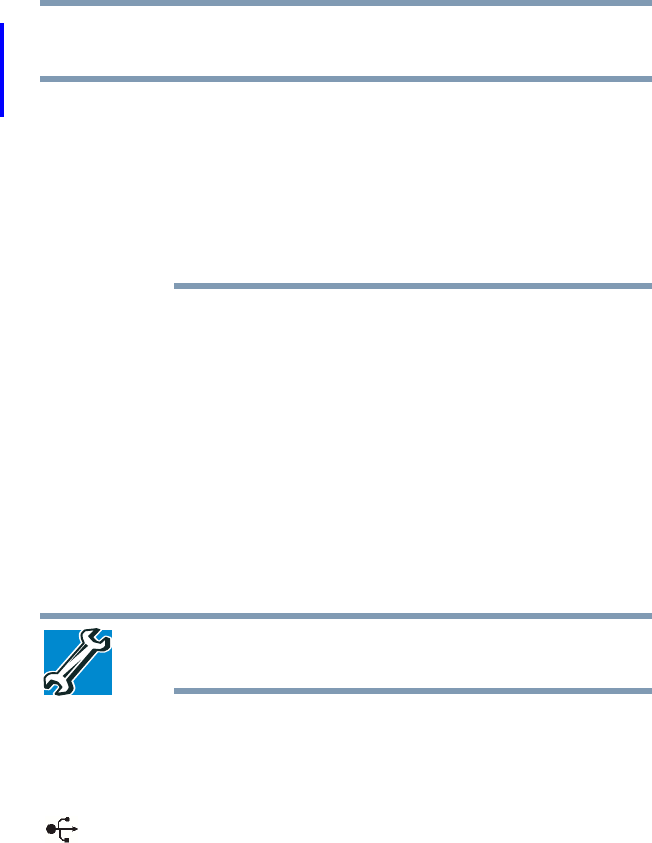
72 Getting Started
Connecting a printer
5.375 x 8.375 ver 2.3
Connecting a printer
Your printer documentation may require you to install the
printer software before physically connecting the printer to
your computer. If you do not install the software as instructed
by the printer manufacturer, the printer may not function
correctly.
Read the documentation that came with your printer. Follow
the manufacturer’s instructions when connecting a printer.
You can connect a USB-compatible printer to your computer
through the USB ports. To determine if the printer is USB-
compatible, check its documentation.
To make the connection, you need a suitable USB cable
which may come with your printer. If a USB cable was not
included with your printer, you can purchase one from a
computer or electronics store.
If your printer supports Plug and Play, your computer will
automatically recognize the printer; the printer is then ready
for use. Refer to your printer documentation for further
instructions.
TECHNICAL NOTE: To determine if your printer supports Plug
and Play, check its documentation.
If your printer does not support Plug and Play, you can set up
the printer as described in “Setting up a printer” on page 73.
To connect a printer to your computer:
1Connect the printer cable to the printer and then connect
the other end to one of the computer’s USB ports.
2Plug the printer’s power cable into a live AC outlet.
NOTE
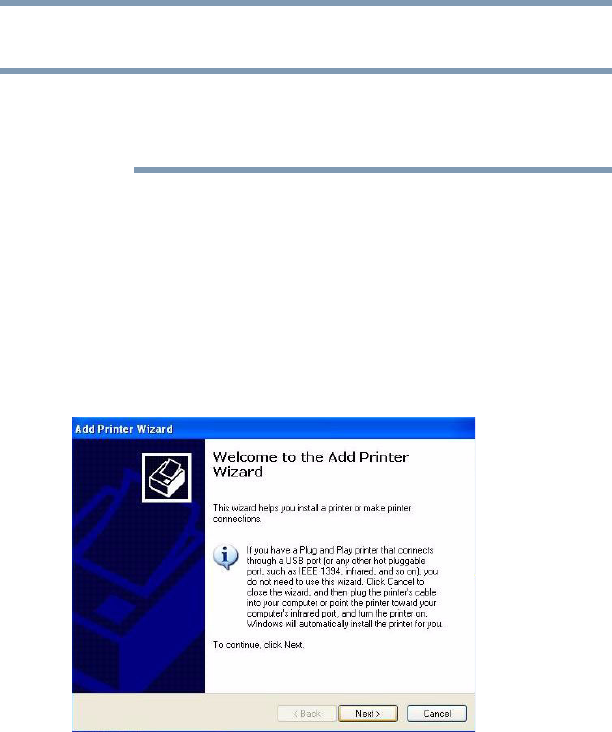
73
Getting Started
Connecting a printer
5.375 x 8.375 ver 2.3
Setting up a printer
Some printers require a specific installation process. Refer to
your printer installation guide for instructions before
completing the following procedure.
If your printer does not support Plug and Play, follow these
steps to set it up for the first time. You only need to set up the
printer once.
1Click Start, and then Printers and Faxes.
The Printers and Faxes window appears.
2Click Add a printer.
The Add Printer Wizard appears.
(Sample Image) Add Printer Wizard
3Follow the on-screen instructions to set up your printer.
NOTE
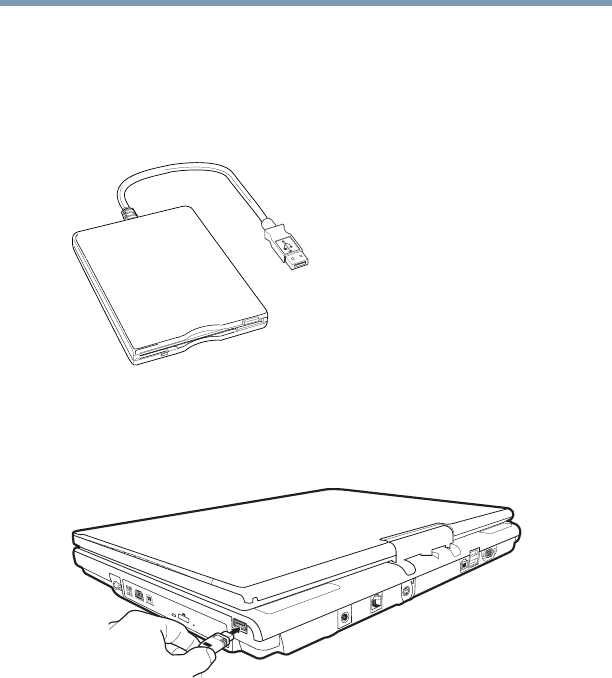
74 Getting Started
Connecting an optional external diskette drive
5.375 x 8.375 ver 2.3
Connecting an optional external diskette drive
Some operations, such as creating a password service
diskette, require a diskette drive designed for use with 3.5-
inch diskettes.
(Sample Illustration) Optional external USB diskette drive
To connect an optional external USB diskette drive, connect
the cable to one of the computer’s USB ports.
(Sample Illustration) Connecting an optional external USB
diskette drive
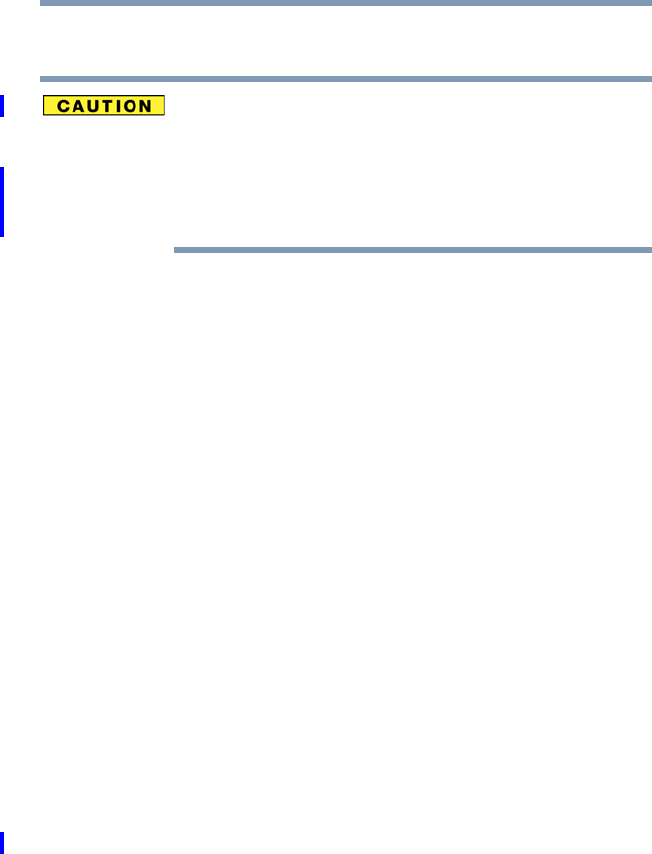
75
Getting Started
Turning off the computer
5.375 x 8.375 ver 2.3
Turning off the computer
Sliding the power switch before shutting down the Windows®
operating system could cause you to lose your work. Make
sure the system indicator panel’s disk light and the drive-in-
use light are off. If you turn off the power while a disk/disc is
being accessed, you may lose data or damage the disk/disc
and/or drive.
It is a good idea to turn off your computer when you are not
using it for a while.
If you are using the computer for the first time, leave the
computer plugged into a power source (even though the
computer is off) to fully charge the main battery.
Options for turning off the computer
Depending on the operating system installed, you have more
than one option available for turning off the computer: Turn
Off or Shut Down, Hibernate, and Standby. Each option has
its advantages.
Turn Off or Shut Down
Factors to consider when choosing either Turn Off or Shut
Down:
❖Use the Turn Off command if you are using Windows®
XP Home, or either Windows® XP Professional or
Windows® XP Media Center Edition (MCE) and are not
connected to a domain server.
❖Use the Shut Down command if you are using Windows®
XP Professional and are connected to a domain server.
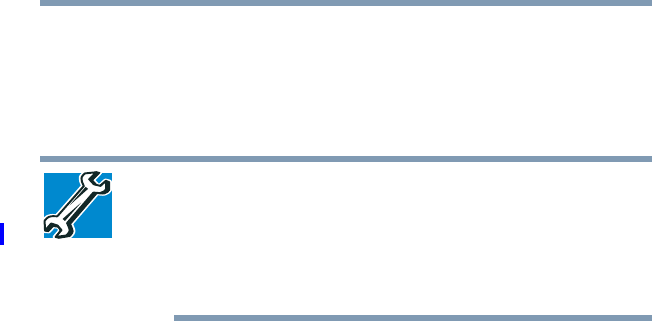
76 Getting Started
Turning off the computer
5.375 x 8.375 ver 2.3
❖If you have work in progress and are not connected to a
network, use the Windows® Standby or Hibernate
commands to save your system settings so that, when you
turn on the computer again, you will automatically return
to where you left off.
TECHNICAL NOTE: Before using any of these options to shut
down or turn off your computer, save your files and make sure
all disk/disc activity lights are off.
If you change your mind and decide to continue working after
all, wait a few seconds before turning the computer on again.
Hibernation mode
Hibernation mode shuts the computer down completely, but it
first saves the current state of the computer to the hard disk.
Since Hibernation mode does not require power to maintain
the saved information, system settings are retained
indefinitely.
Factors to consider when choosing Hibernation:
❖While in Hibernation mode, the computer uses no main
battery power.
❖Because the state of the system is stored on the hard disk,
no data is lost if the main battery discharges.
❖Restarting from Hibernation takes less time and
consumes less main battery power than restarting from
turning off the computer.
❖Since information is being retrieved from the hard disk
rather than from memory, restarting from Hibernation
takes a little more time and consumes more main battery
power to start up than when restarting from Standby.
❖When starting up again, the computer returns to the state
in which you left it, including all open programs and files
you were using.
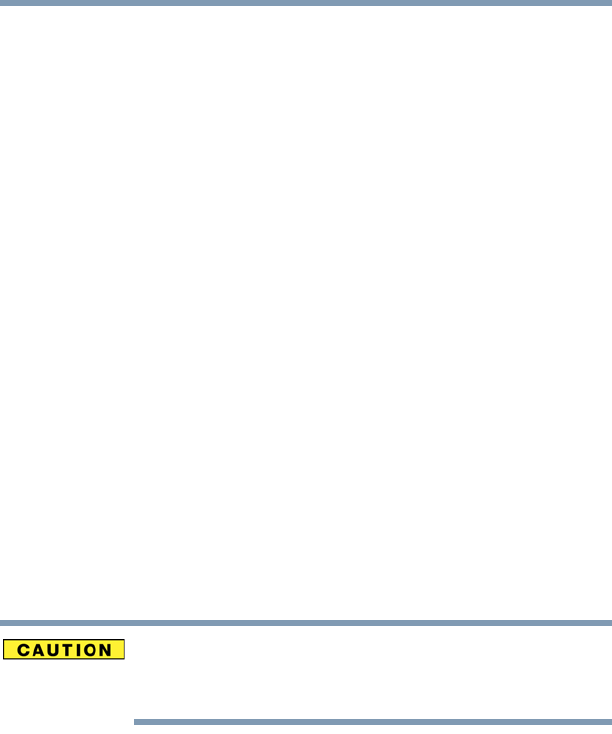
77
Getting Started
Turning off the computer
5.375 x 8.375 ver 2.3
For information on how to use and configure Hibernation
mode see “Using and configuring Hibernation mode” on
page 80.
Standby mode
The Standby command places the computer into a power-
saving mode. Standby holds the current state of the computer
in system memory (RAM) so that, when you restart the
computer, you can continue working from where you left off.
Factors to consider when choosing Standby:
❖While in Standby mode, the computer uses some main
battery power.
❖The Standby command does not store unsaved
information on your hard disk. You should save your
work before putting your computer on Standby.
❖Restarting from Standby takes less time and consumes
less main battery power than restarting from turning off
the computer or using Hibernation mode.
❖When starting up again, the computer returns to the mode
in which you left it, including all open programs and files
you were using.
If you power down using the Standby command and the main
battery discharges fully, your unsaved information will be lost.
Be sure to save your work first.
For information on using Standby, see “Using and
configuring Standby mode” on page 82.
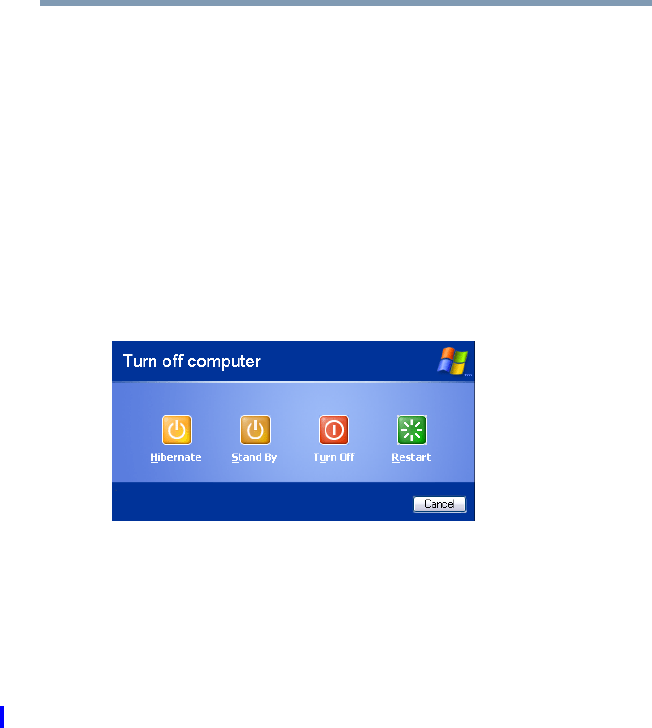
78 Getting Started
Turning off the computer
5.375 x 8.375 ver 2.3
Using the Turn Off Computer or Shut Down commands
Depending on the operating system installed, use the
following steps to turn off your computer.
Turn Off
For Windows® XP Home, or either Windows® XP
Professional or Windows® XP MCE when not connected to a
domain server, follow these steps to turn off the computer:
1Click Start, and then Turn off computer.
The Turn off computer dialog box appears.
(Sample Image) Turn off computer Windows® dialog box
2Click Turn Off.
The computer shuts down completely.
Shut Down
For Windows® XP Professional, follow these steps to turn off
the computer:
1Click Start, and then Shut down.
The Shut Down Windows® dialog box appears.
2Select Shut down from the drop-down list.
3Click OK.
The computer shuts down completely.
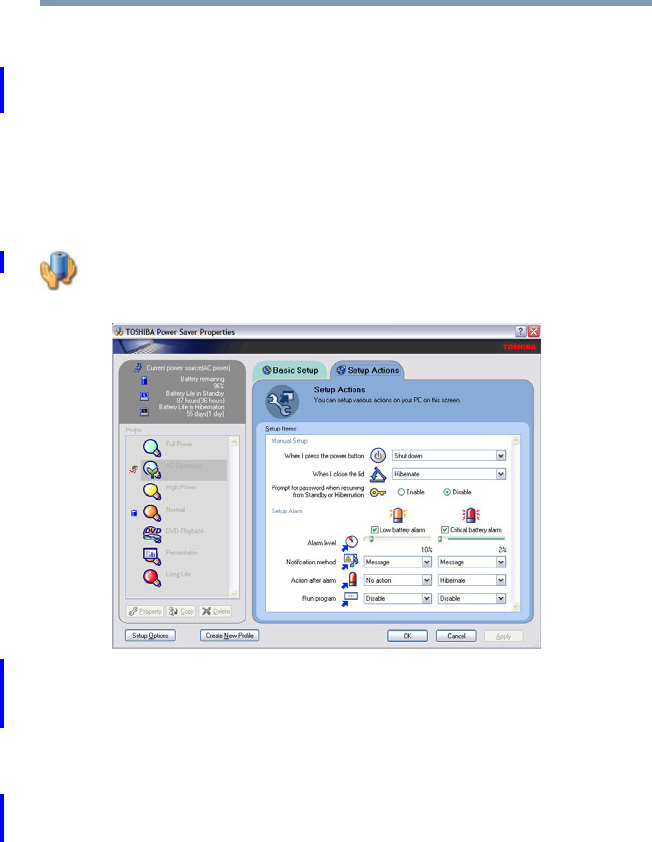
79
Getting Started
Turning off the computer
5.375 x 8.375 ver 2.3
Turning off the computer more quickly
You can also turn off the computer by sliding the power
switch.
To use this method, you first need to activate it using
Toshiba’s Power Saver utility.
1Click Start, Control Panel, and then Performance and
Maintenance.
2Click the TOSHIBA Power Saver icon.
3Click on the Setup Action tab.
(Sample Image) Setup action settings screen
4Select the options you want from the drop-down lists.
❖When I press the power button
Set this option to Shut down if you want the
computer to shut down when you slide the power
switch.
❖When I close the lid
Set this option to Shut down if you want the
computer to shut down when you close the display
panel.
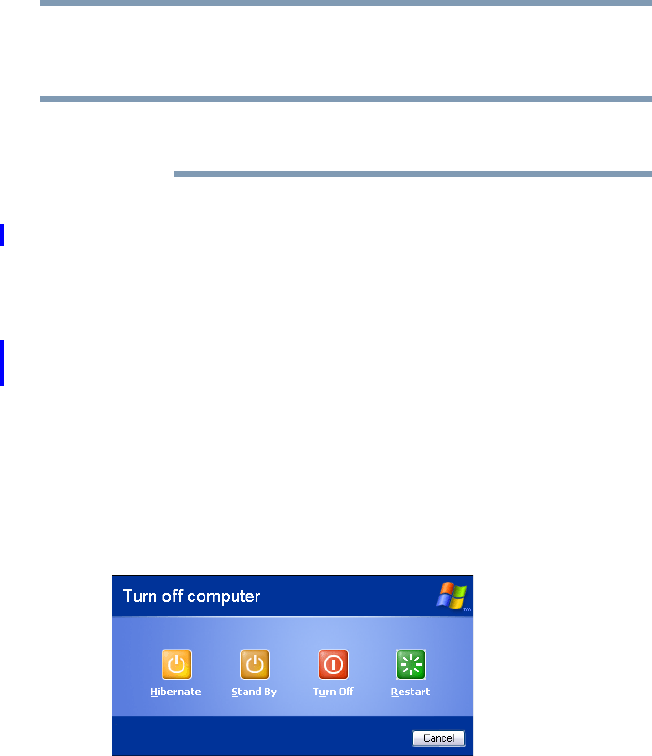
80 Getting Started
Turning off the computer
5.375 x 8.375 ver 2.3
5Click Apply.
6Click OK.
For more information about the Power Saver utility, see
“TOSHIBA Power Saver” on page 178.
Once the computer is configured, you can turn it off by either
sliding the power switch or closing the display panel,
depending on the options set.
Restarting your computer
To start the computer up again, slide the power switch until
the on/off light glows green.
If you turn off the computer by closing the display panel, you
can start it again by opening the display panel.
Using and configuring Hibernation mode
To turn off the computer using the Hibernation command,
click Start, Turn off computer, and then select Hibernate.
(Sample Image) Turn off computer Windows® dialog box
The computer saves the state of all open programs and files,
turns off the display, and then turns off.
NOTE
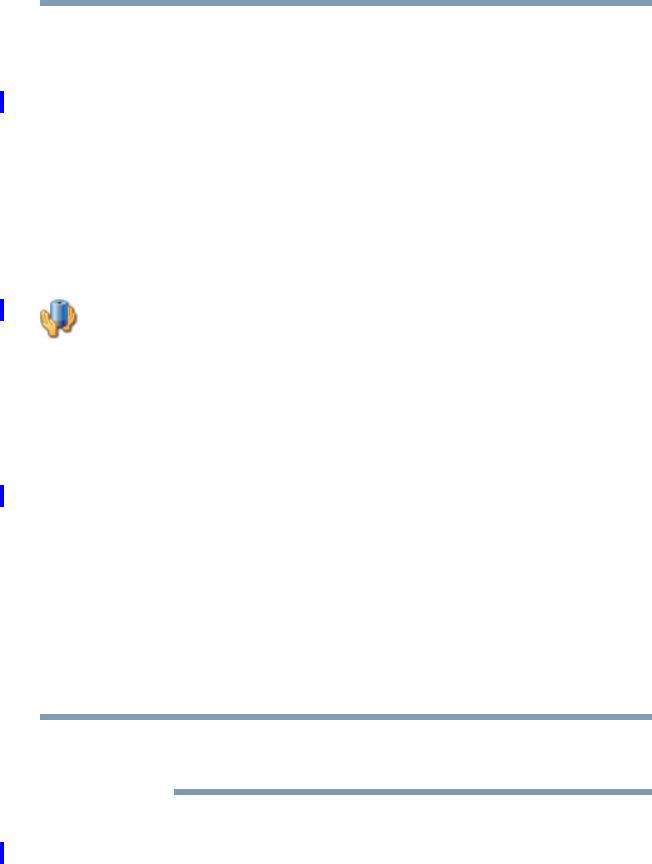
81
Getting Started
Turning off the computer
5.375 x 8.375 ver 2.3
Configuring Hibernation mode options
You can place the computer into Hibernation mode by either
sliding the power switch or closing the display panel. You can
also specify an amount of time after which the computer
automatically goes into Hibernation mode.
To use any of these methods, you first need to enable them in
Toshiba’s Power Saver utility.
1Click Start, Control Panel, and then Performance and
Maintenance.
2Click the TOSHIBA Power Saver icon.
3Click the Setup Action tab.
4Select Hibernation for the options you want.
❖When I press the power button
Set this option to Hibernate if you want the
computer to go into Hibernation mode when you
slide the power switch.
❖When I close the lid
Set this option to Hibernate if you want the
computer to go into Hibernation mode when you
close the display panel.
5Click Apply.
6Click OK.
For more information about the Power Saver utility, see
“TOSHIBA Power Saver” on page 178.
Once the computer is configured, you can place it into
Hibernation mode by either sliding the power switch or
closing the display panel, depending on the Hibernation
options set.
NOTE
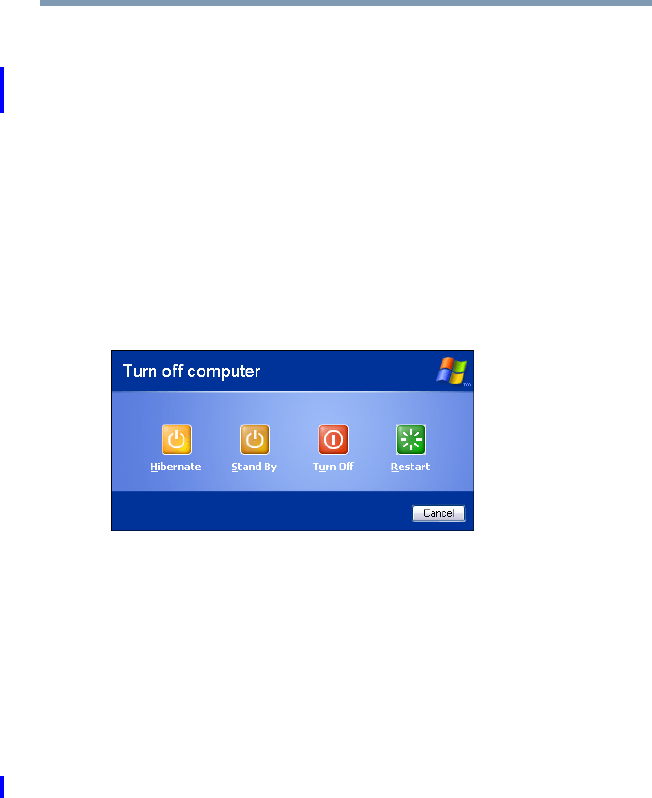
82 Getting Started
Turning off the computer
5.375 x 8.375 ver 2.3
Starting again from Hibernation mode
To start up the computer from Hibernation mode, slide the
power switch until the on/off light glows green. The
computer returns to the screen(s) you were using.
If you put the computer in Hibernation mode by closing the
display panel, you can start it again by opening the display
panel.
Using and configuring Standby mode
To turn off the computer using the Standby command, click
Start, Turn off computer, and then select Stand By.
(Sample Image) Turn off computer Windows® dialog box
The computer saves the status of all open programs and files,
turns off the display, and enters into a low-power mode. The
on/off light blinks amber indicating the computer is in
Standby mode.
Configuring Standby mode options
You can place the computer into Standby mode by either
sliding the power switch or closing the display panel. You can
also specify an amount of time after which the computer
automatically goes into Standby mode.
To use any of these methods, you first need to enable them in
Toshiba’s Power Saver utility.
1Click Start, Control Panel, and then Performance and
Maintenance.
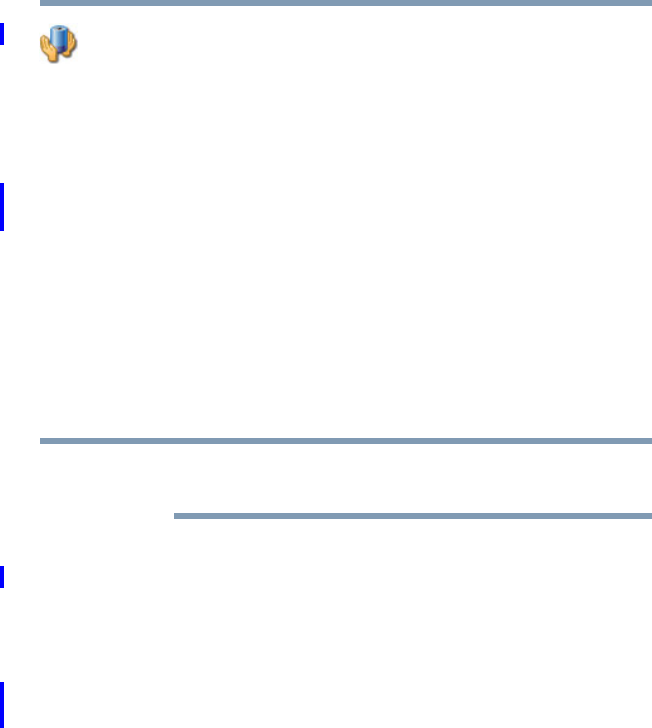
83
Getting Started
Turning off the computer
5.375 x 8.375 ver 2.3
2Click the TOSHIBA Power Saver icon.
3Click the Setup Action tab.
4Select Standby for the options you want.
❖When I press the power button
Set this option to Standby if you want the computer
to go into Standby mode when you slide the power
switch.
❖When I close the lid
Set this option to Standby if you want the computer
to go into Standby mode when you close the display
panel.
5Click Apply.
6Click OK.
For more information about the Power Saver utility, see
“TOSHIBA Power Saver” on page 178.
Once the computer is configured, you can place it into
Standby mode by either sliding the power switch or closing
the display panel, depending on the Standby options set.
Starting again from Standby mode
To start up the computer from Standby mode, slide the power
switch until the on/off light glows green. The computer
returns to the screen(s) you were using.
If you place the computer in Standby mode by closing the
display panel, you can start it again by opening the display
panel.
Closing the display panel
After you have turned off the computer, close the display
panel to keep dust and dirt out of the computer.
NOTE
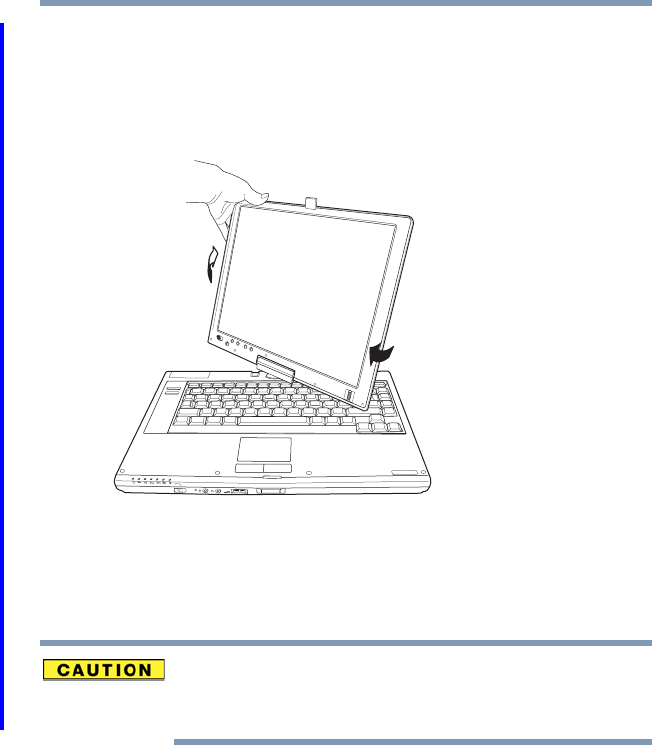
84 Getting Started
Using your computer in tablet mode
5.375 x 8.375 ver 2.3
Using your computer in tablet mode
One of your computer’s features is a convertible display that
allows you to use the screen much as you would a writing
tablet.
(Sample Illustration) Rotating the screen
By simply rotating and folding the screen over the keyboard,
your system is ready to use in tablet mode, with the included
Toshiba tablet pen.
When rotating LCD screen of your computer, be sure to slowly
turn the screen in the proper direction, and not apply excessive
force or speed.
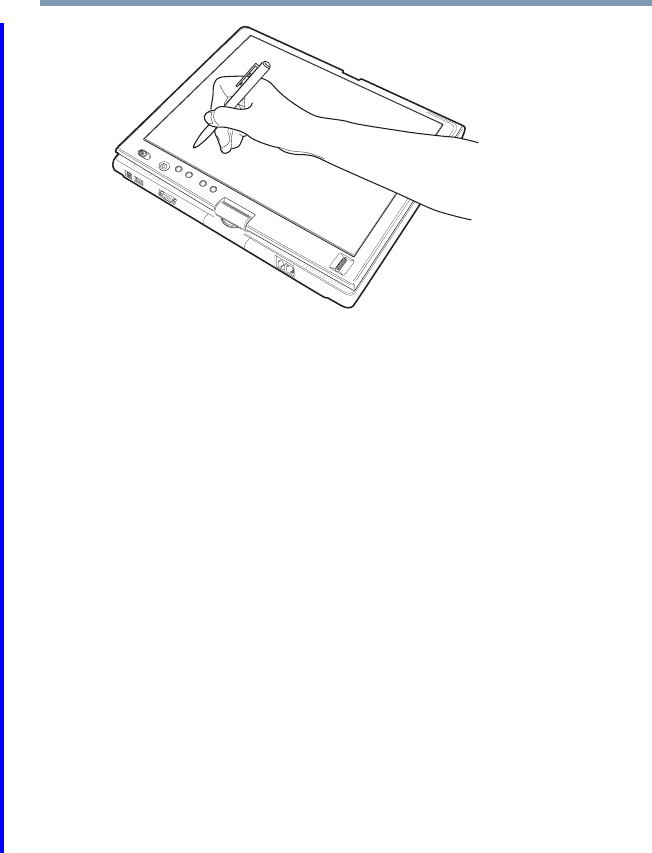
85
Getting Started
Using your computer in tablet mode
5.375 x 8.375 ver 2.3
(Sample Illustration) Using the computer in tablet mode
To remove the tablet pen, press it in, and then pull it out from
the right side of the computer.
For more information on using the computer in tablet mode,
see “Using tablet mode” on page 144.
Your computer came with applications already installed
specifically designed to work with the tablet feature of the
system. For more information on those applications, see the
documentation provided with them.
Customizing your computer’s settings
There are several ways in which you can customize your
computer to suit your particular requirements. Refer to your
operating system documentation or Help and Support for
details.
You may also wish to customize your power usage settings.
For more information, see “Power Profiles” on page 119.
There are additional custom settings you can choose. See
“Toshiba Utilities” on page 155.
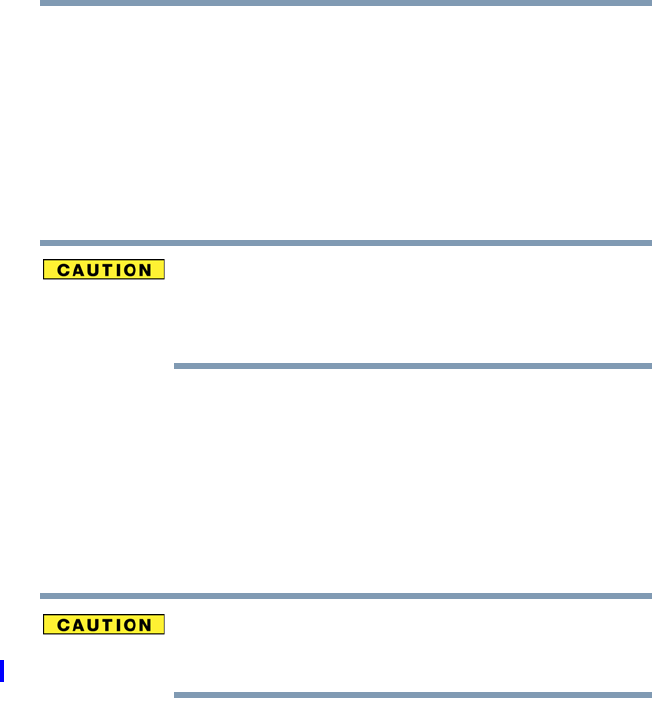
86 Getting Started
Caring for your computer
5.375 x 8.375 ver 2.3
Caring for your computer
This section gives tips on cleaning and moving your
computer. For information about taking care of your
computer’s battery, see “Taking care of your battery” on
page 124.
Cleaning the computer
Keep liquids, including cleaning fluid, out of the computer’s
keyboard, speaker, and other openings. Never spray cleaner
directly onto the computer. Never use harsh or caustic
chemical products to clean the computer.
To keep your computer clean, gently wipe the display panel
and exterior case with a lightly dampened cloth.
Moving the computer
Before moving your computer, even across the room, make
sure all disk activity has ended (the drive indicator light stops
glowing) and all external peripheral cables are disconnected.
Do not pick up the computer by its display panel or by the
back (where the ports are located). Doing so could damage the
system.
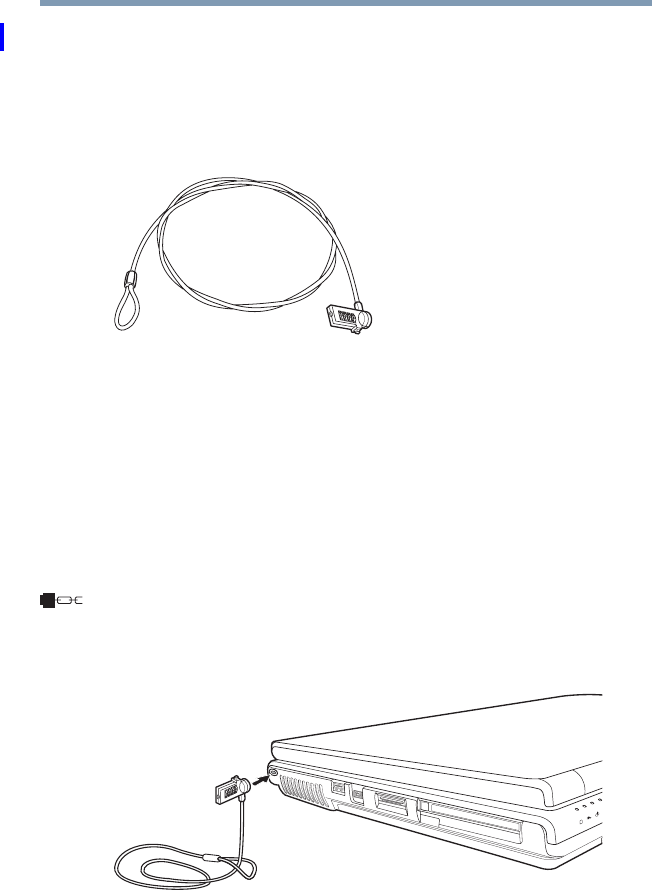
87
Getting Started
Caring for your computer
5.375 x 8.375 ver 2.3
Using a computer lock
You may want to secure your computer to a heavy object such
as your desk. The easiest way to do this is to purchase an
optional computer lock cable. For more information on
purchasing a cable lock, visit accessories.toshiba.com.
(Sample Illustration) Computer lock cable
To secure the computer:
1Wrap the cable through or around some part of a heavy
object.
Make sure there is no way for a potential thief to slip the
cable off the object.
2Pass the locking end through the loop.
3Insert the cable’s locking end into the security lock slot
on your computer, then engage the locking device.
The computer is now securely locked.
(Sample Illustration) Attaching security lock cable
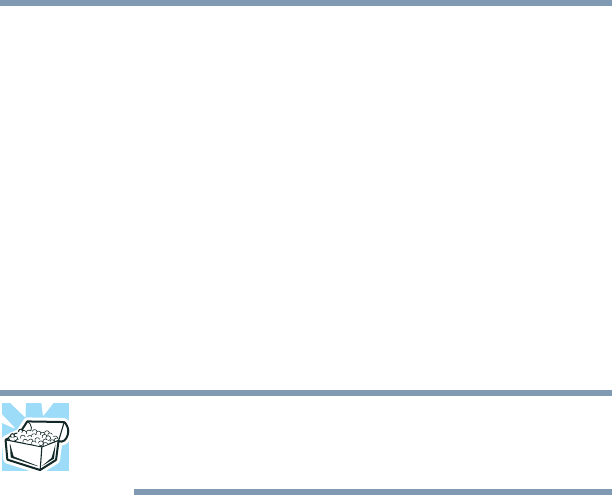
88
5.375 x 8.375 ver 2.3
Chapter 2
Learning the Basics
This chapter gives some computing tips and provides
important information about basic features.
Computing tips
❖Save your work frequently.
Your work stays in the computer’s temporary memory
until you save it to the disk. If the network you are using
goes down and you must restart your computer to
reconnect, or your battery runs out of charge while you
are working, you will lose all work since you last saved.
See “Saving your work” on page 96 for further
information.
HINT: Some programs have an automatic save feature that can
be activated. This feature saves your file to the hard disk at
preset intervals. See your software documentation for details.

89
Learning the Basics
Computing tips
5.375 x 8.375 ver 2.3
❖Back up your files to disks (or other removable media) on
a regular basis. Label the backup copies clearly and store
them in a safe place.
It is easy to put off backing up because it takes time.
However, if your hard disk suddenly fails, you will lose
all the data on it unless you have a separate backup copy.
❖Use Error-checking and Disk Defragmenter regularly to
conserve disk space and improve performance.
❖Scan all new files for viruses.
This precaution is especially important for files you
receive via diskette, email, or download from the
Internet.
❖Take frequent breaks to avoid repetitive-motion injuries
and eyestrain.
❖Do not turn off the computer if a drive indicator light
indicates a drive is active.
Turning off the computer while it is reading from or
writing to a disk may damage the disk, the drive, or both.
❖Before turning off the computer, use the Turn off
computer command or Standby command. See “Using
and configuring Standby mode” on page 82 to learn more
about Standby.
The Windows® operating system records information, such as
your desktop setup, during its shutdown procedure. If you do
not let the Windows® operating system shut down normally,
details such as new icon positions may be lost.
NOTE
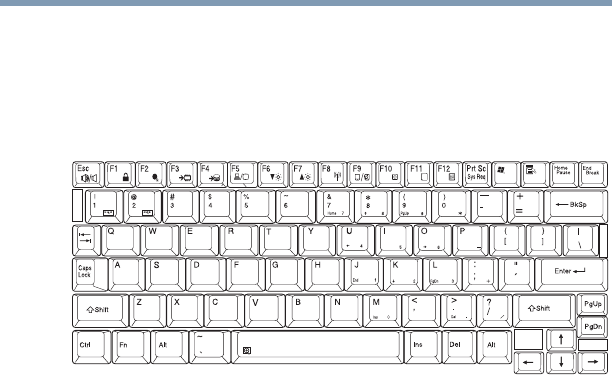
90 Learning the Basics
Using the keyboard
5.375 x 8.375 ver 2.3
Using the keyboard
Your computer’s keyboard contains character keys, control
keys, function keys, and special Windows® keys, providing all
the functionality of a full-size keyboard.
(Sample Illustration) Keyboard
Character keys
Typing with the character keys is very much like typing on a
typewriter, except that:
❖The space bar creates a space character instead of just
passing over an area of the page.
❖The lowercase letter l (el) and the number 1 are not
interchangeable.
❖The uppercase letter O and the number 0 are not
interchangeable.
Making your keyboard emulate a full-size keyboard
Although your computer’s keyboard layout is compatible
with a standard full-size keyboard, it has fewer keys.
A standard full-size keyboard has two Enter, Ctrl, and Alt keys;
editing keys; cursor positioning keys; and a numeric keypad.
Pressing the Fn key simultaneously in combination with one
of the specially marked keys allows you to emulate a full-size
keyboard.
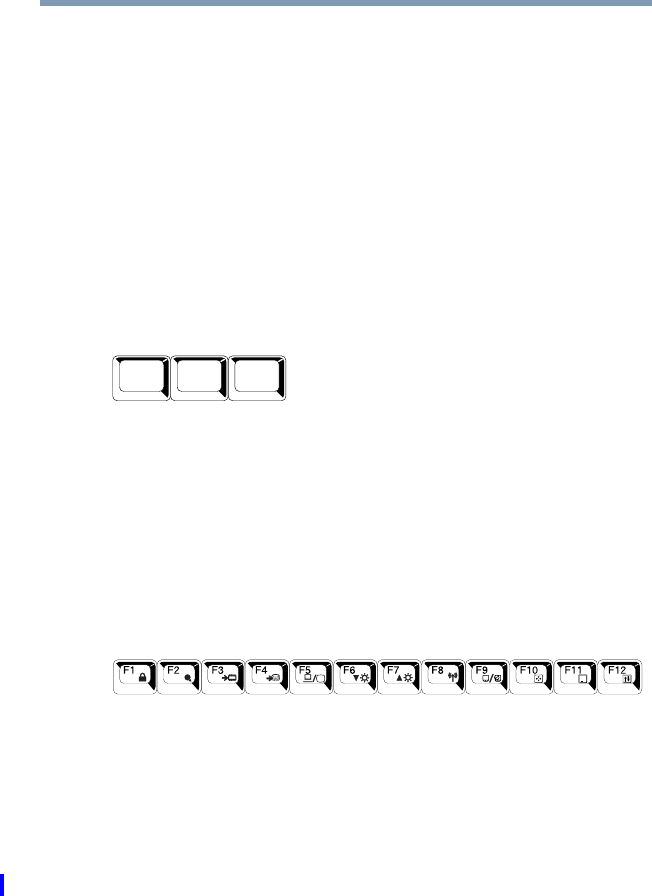
91
Learning the Basics
Using the keyboard
5.375 x 8.375 ver 2.3
Your computer’s keyboard has only one Enter and one Ctrl key.
Most of the time, this does not matter. However, some
programs assign separate functions to the right and left Ctrl
and Alt keys, or to the regular and numeric pad Enter keys on
the full-sized keyboard. Using the Fn key, you can simulate
these separate keys, as follows:
❖Press Fn and Ctrl simultaneously to simulate the Ctrl key on
the right side of the enhanced keyboard.
❖Press Fn and Enter simultaneously to simulate the Enter key
on the numeric pad of the enhanced keyboard.
Ctrl, Fn, and Alt keys
(Sample Illustration) Ctrl, Fn, and Alt keys
The Ctrl, Fn, and Alt keys do different things depending on the
program you are using. For more information, see your
program documentation.
Function keys
The function keys (not to be confused with the Fn key) are the
12 keys at the top of the keyboard.
(Sample Illustration) Function keys
F1 through F12 are called function keys because they execute
programmed functions when pressed. Used in combination
with the Fn key, function keys marked with icons execute
specific functions on the computer. For example, Fn+F9 turns
off the TouchPad. For more information, see “Fn-esse®” on
page 170, or “Hot Keys” on page 255.
Alt
Ctrl Fn
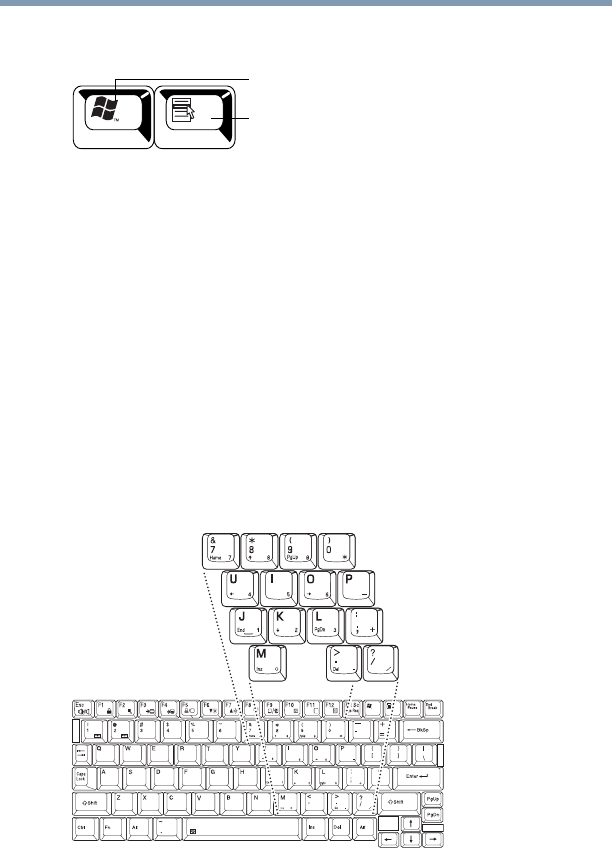
92 Learning the Basics
Using the keyboard
5.375 x 8.375 ver 2.3
Windows special keys
(Sample Illustration) Windows special keys
Your computer’s keyboard has two keys that have special
functions in Windows:
❖Windows key—Opens the Start menu
❖Application key—Has a similar function as the
secondary mouse button
Overlay keys
The keys with gray numbers and symbols on the front of
them form the numeric and cursor overlay. This overlay lets
you enter numeric data or control the cursor as you would
using the 10-key keypad on a desktop computer’s keyboard.
(Sample Illustration) Numeric and cursor control overlay
Application key
Windows key
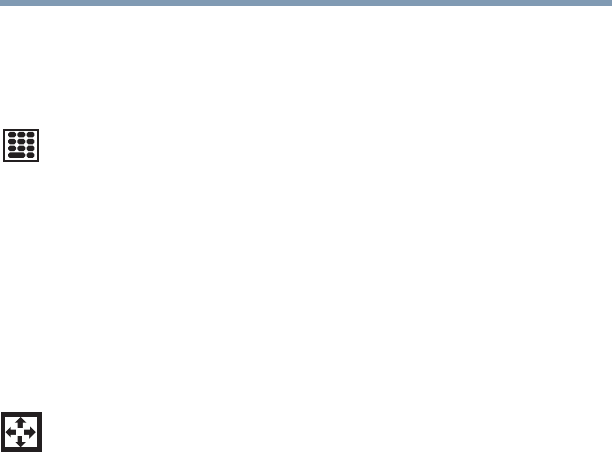
93
Learning the Basics
Starting a program
5.375 x 8.375 ver 2.3
Using the overlay to type numeric data
The keys with the numbers on their right front are the
numeric overlay keys.
To turn the numeric overlay on, press Fn and F11
simultaneously. The numeric mode light on the keyboard
indicator panel glows when the numeric overlay is on.
To disable the numeric overlay, hold down the Fn key and
press F11 again. The numeric mode light on the keyboard
indicator panel goes out.
Using the overlay for cursor control
The keys with the gray arrows and symbols on their left front
are the cursor control overlay keys.
To turn the cursor control overlay on, press Fn and F10
simultaneously. The cursor control mode light on the
keyboard indicator panel glows when the cursor control
overlay is on.
To disable the cursor control overlay, hold down the Fn key
and press F10 again. The cursor control mode light on the
keyboard indicator panel goes out.
Starting a program
The easiest way to start a program is to double-click the name
of the file that contains the information you want to work on.
To find the file, use My Computer or Windows® Explorer.
If you prefer to open the program first, you have four options.
You can:
❖Double-click the icon for the program on your desktop
❖Use the Start menu
❖Use Windows® Explorer or My Computer to locate the
program file
❖Use the Run dialog box
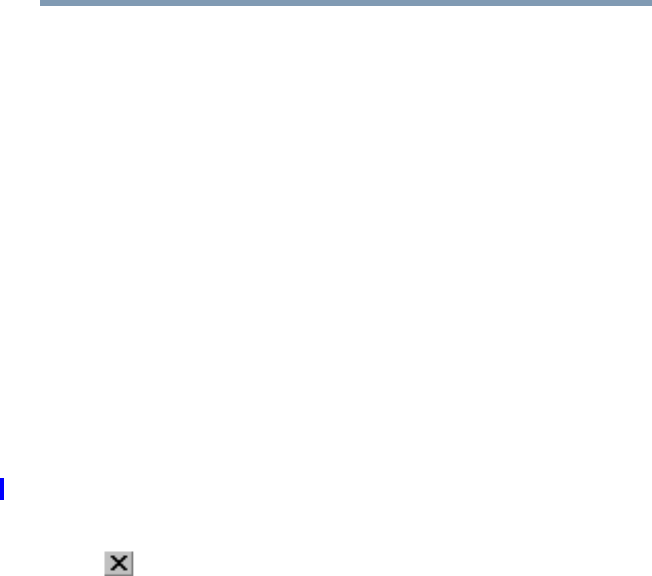
94 Learning the Basics
Starting a program
5.375 x 8.375 ver 2.3
The next three sections explain how to start a program from
the Start menu, Explorer and the Run dialog box.
Starting a program from the Start menu
When you install a program, the operating system usually
puts an icon in the All Programs menu. To start a program
that has an icon in the All Programs menu, follow these steps,
which use the Windows® WordPad program as an example:
1Click Start, and then All Programs.
The Windows® operating system displays the All
Programs menu, which lists programs and program
groups. If your program is listed, go to step 3, otherwise,
continue with step 2.
2Click the program group, in this example, Accessories.
The Accessories menu is displayed.
3Click the program, in this example, WordPad.
WordPad opens.
To close the program, click the Close button in the upper-
right corner of the program’s window.
Starting a program from Windows® Explorer
If a program is not listed in the All Programs menu, you can
start it from Windows® Explorer. Windows® Explorer gives
you a view of your computer’s contents as a hierarchy or
“tree.” You can easily see the contents of each drive and
folder on your computer. To use this method, you should
know the file name and location of the program’s executable
file (this file ends with .exe).
This example opens WordPad using Windows Explorer.
1Click Start, and then All Programs.
2Click Accessories.
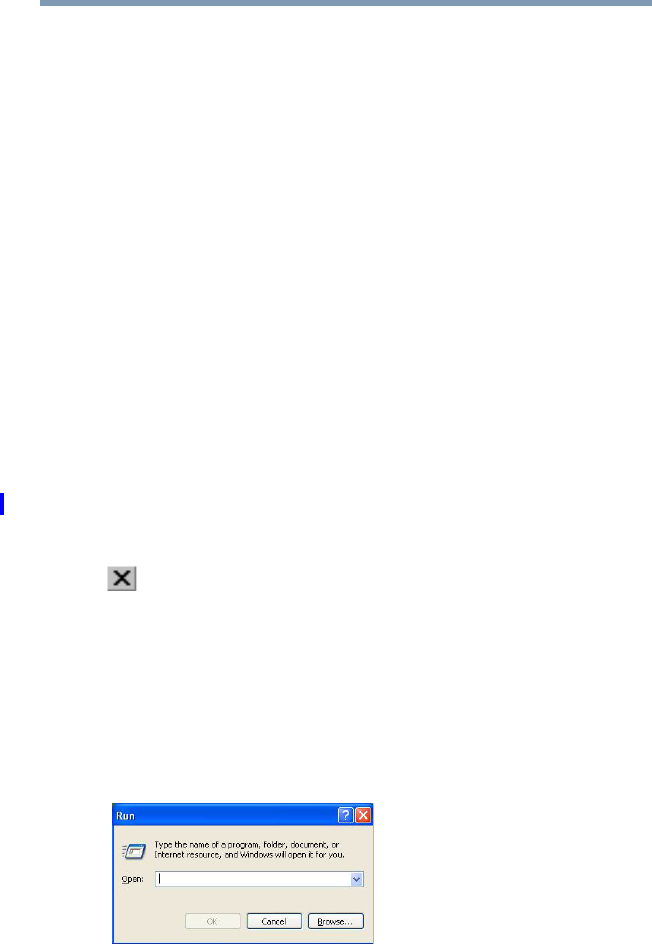
95
Learning the Basics
Starting a program
5.375 x 8.375 ver 2.3
3Click Windows Explorer.
4Click My Computer to expand the window.
5In the left part of the window, click the line that ends in
“(C:).”
6In the left part of the window, under the C: icon, double-
click the folder containing the program, in this case
Program Files.
Windows® Explorer shows the contents of the Program
Files folder on the right side of the window. The left side
of the window shows all the folders contained within the
Program Files folder.
7In the left part of the window, click Windows NT.
8In the left part of the window, click Accessories.
Windows® Explorer shows the contents of the
Accessories folder on the right side of the window.
9In the right part of the window, double-click wordpad.
The operating system opens WordPad.
To close the program, click the Close button in the upper-
right corner of the program’s window.
Starting a program from the Run dialog box
This example uses the Run command to start WordPad:
1Click Start, and then Run.
The Run dialog box appears.
(Sample Image) Run dialog box
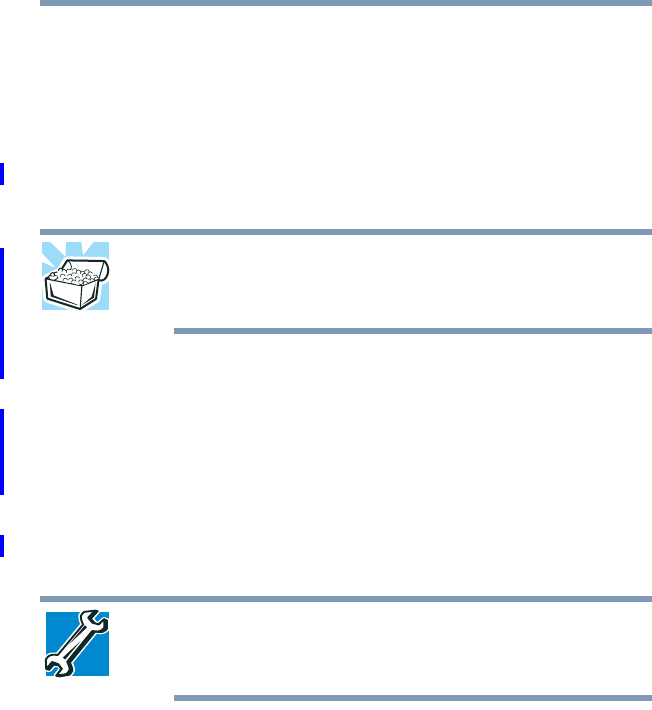
96 Learning the Basics
Saving your work
5.375 x 8.375 ver 2.3
2In the Run dialog box:
❖If you know the program’s location, type the
command line. For a program in the Windows®
folder, type just the program name. Otherwise, type
the full file path. For example, to access WordPad,
type: c:\Program Files\Windows NT\Accessories\wordpad.exe,
then click OK.
HINT: To run the same program again, click the arrow to the
right of the text box and select the command line from the
drop-down list.
❖If you do not know the location, you can search for it
by clicking Start, then Search, and then following
the on-screen instructions.
Saving your work
Before you turn off the computer, save your work on the hard
disk drive, diskette, flash media, or CD. This is one of the
most important rules of computing.
TECHNICAL NOTE: Save your data even when you are using
the Standby command, in case the main battery discharges
before you return to work.
Saving documents is quick and easy, so it is a good idea to get
in the habit of saving frequently.
Many programs offer a feature that saves documents at
regular intervals. Check your program’s documentation to see
if it has an automatic save feature.
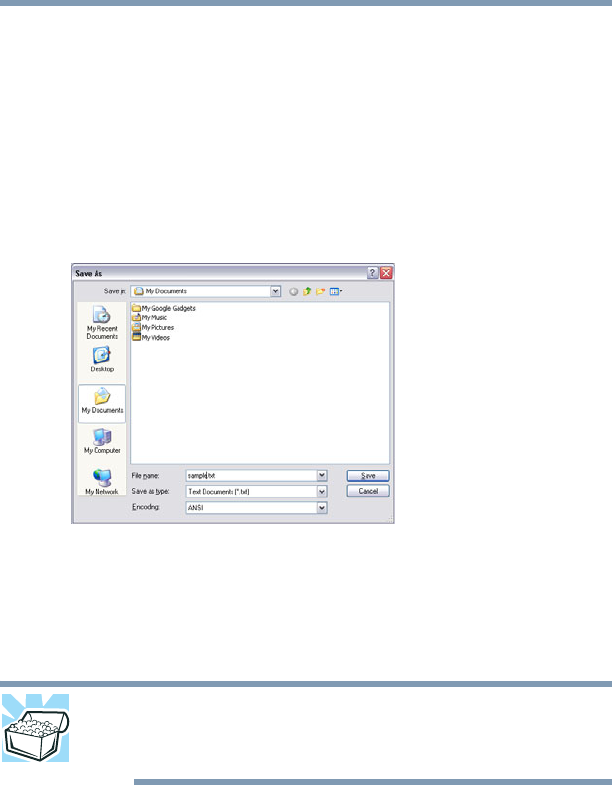
97
Learning the Basics
Saving your work
5.375 x 8.375 ver 2.3
Saving files
1In your Windows® application, click File, and then Save.
If you are working with a document that already has a file
name, this is all you need to do. If you created a new
document, your program displays a Save As dialog box.
Use this dialog box to specify where to store the
document and to give it a file name.
(Sample Image) Save As dialog box
2Choose the drive and folder where you want your file to
be stored.
3Type a file name, then click Save.
HINT: To make another copy of the file you are currently
working with, choose Save As from the File menu and give the
new file a different name.
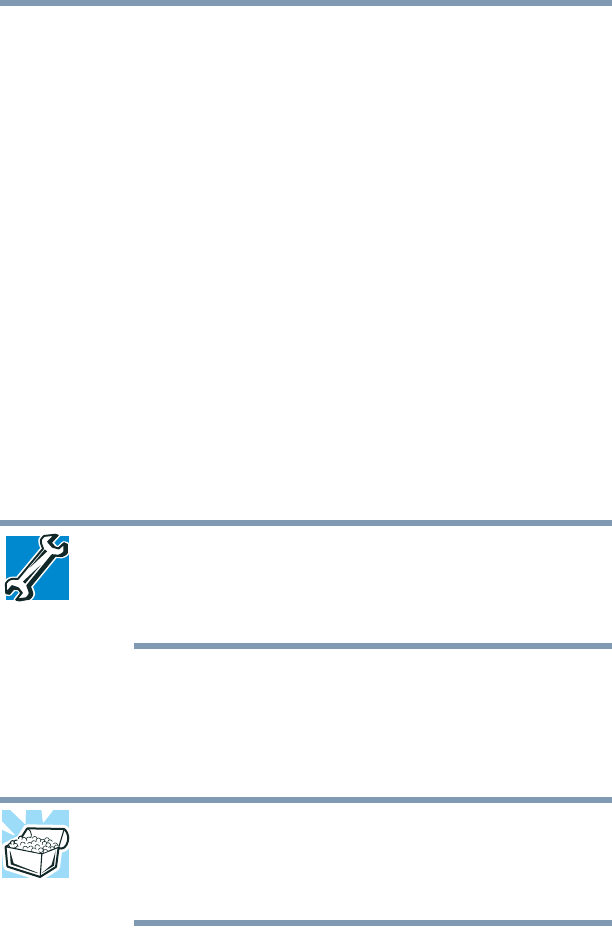
98 Learning the Basics
Printing your work
5.375 x 8.375 ver 2.3
File names
The Windows operating system supports long file names that
can contain up to 255 characters and can include spaces.
Some applications do not support long file names and require
file names limited to no more than eight characters.
You may use all the letters and numbers on the keyboard plus
these characters: _ ^ $ ~ ! # % & { } ( ) @ and '. File names
are not case-sensitive.
Using a file extension
Most programs assign an extension to the file name that
identifies the file as being created in the program with a
particular format. For example, Microsoft Word saves files
with a .doc extension. Any file name with an extension of
“.doc” is assumed to be a Microsoft Word file. Creating your
own extension is usually unwise, since the program is
unlikely to recognize a strange extension and may refuse to
handle your file correctly.
TECHNICAL NOTE: By default, the Windows® operating
system does not show file extensions. For information on
showing or hiding file extensions, see your Windows® online
Help.
Printing your work
Ensure the operating system is set up for your printer as
described in “Setting up a printer” on page 73.
HINT: You only need to set up the printer the first time you
connect it. If you use more than one printer or are changing
printers, you will need to set up the Windows® operating
system to run with the additional printer(s).
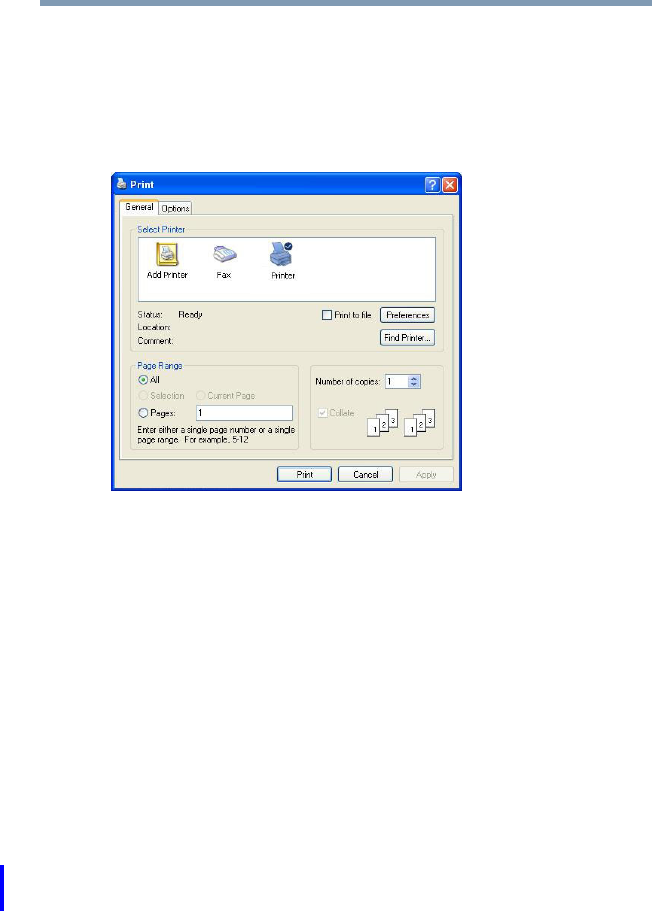
99
Learning the Basics
Backing up your work
5.375 x 8.375 ver 2.3
To print a file:
1If your printer is not on, turn it on now.
2In your Windows® application, click File, and then Print.
The program displays a Print dialog box.
(Sample Image) Print dialog box
3Specify the print parameters. For example, the range of
pages and number of copies to print.
4Click Print.
Backing up your work
Back up all the files you create in case something happens to
your computer. You can back up your files to different types
of media such as CDs, DVDs, diskettes, or to a network, if
available.
To back up several files at one time, use the Microsoft®
Windows® backup program preinstalled on the computer’s
hard disk. Also see “Backing up your data to CDs with
Windows XP” on page 247.
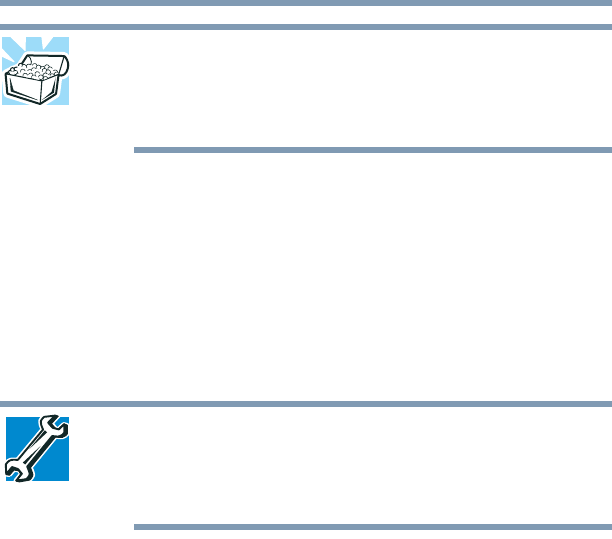
100 Learning the Basics
Using the optical drive
5.375 x 8.375 ver 2.3
HINT: Backing up all the files on your hard disk may take a
considerable amount of time and multiple CDs/DVDs. You
may prefer to use a high-capacity backup system, such as an
external hard drive.
Small files can be backed up on diskettes if an optional
external diskette drive is available.
Restoring your work
To restore information from your backup media to your hard
disk, use the Restore page in the backup program. Look in the
online Help or your operating system documentation for
information on restoring files.
TECHNICAL NOTE: When restoring files, the backup program
prompts you if you try to overwrite a file that already exists on
the hard disk. Make sure the backup version is the one you
want before overwriting the existing file.
Using the optical drive
Optical storage has become the preferred medium for
software, music, and video. Digital versatile discs (DVDs)
provide a significant increase in data storage and support
features that are not available on any other video platform.
These features include wide-screen movies, multiple
language tracks, digital surround sound, multiple camera
angles, and interactive menus.
For these reasons, your computer may come with an optical
drive.
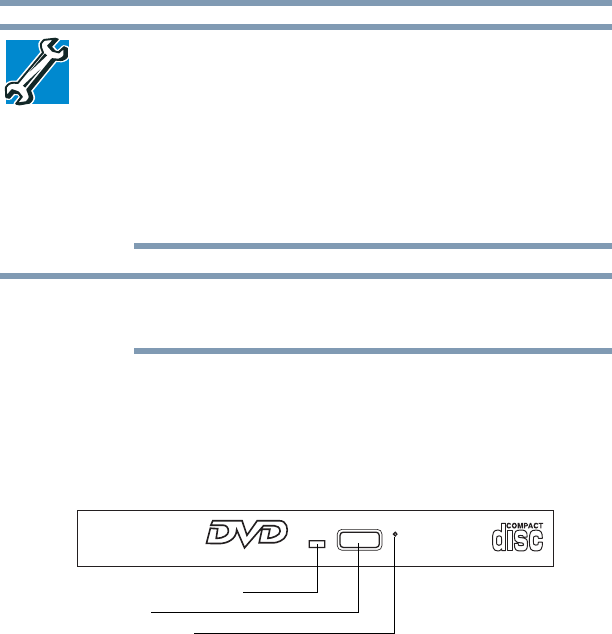
101
Learning the Basics
Using the optical drive
5.375 x 8.375 ver 2.3
TECHNICAL NOTE: Your optical drive is set to play region 1
(North America) DVD-ROMs. If you play a DVD disc from
another region, the drive will automatically change to play in
the format of the other region. The drive will allow you to
change regions four times. On the fourth change, the region
will be “locked in.” That is, the drive will only play DVDs from
that last region. Note that changing from region 1 to region 2
and back to region 1 is counted as two changes.
For optimum DVD performance, it is recommended that you
play DVDs while running the computer on AC power.
Optical drive components
The optical drive is located on the right side of the computer.
Your optical drive may look like this:
(Sample Illustration) Optical drive
Drive in-use indicator light—Indicates when the drive is in
use.
Eject button—Press to release the disc tray.
NOTE
Drive in-use indicator light
Eject button
Manual eject hole
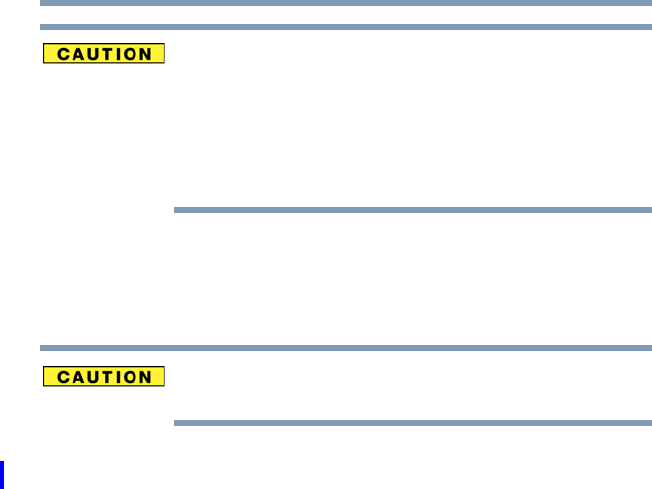
102 Learning the Basics
Using the optical drive
5.375 x 8.375 ver 2.3
Do not press the eject button or turn off the computer while the
drive in-use indicator light is glowing. Doing so could damage
the disc or the drive.
When the disc tray is open, be careful not to touch the lens or
the area around it. Doing so could cause the drive to
malfunction.
Manual eject hole—Use if you need to release the disc tray
when the power is off. Use a straightened paper clip or other
narrow object to press the manual eject button located inside
the hole.
Never use a pencil to press the manual eject button. Pencil
lead can break off inside the computer and damage it.
Inserting a disc
To insert a compact disc into the drive:
1Make sure the computer is turned on.
The drive will not open if the computer’s power is off.
2Make sure the drive’s in-use indicator light is off.
3Press the drive’s eject button.
The disc tray slides partially out of the drive (about 1 inch).
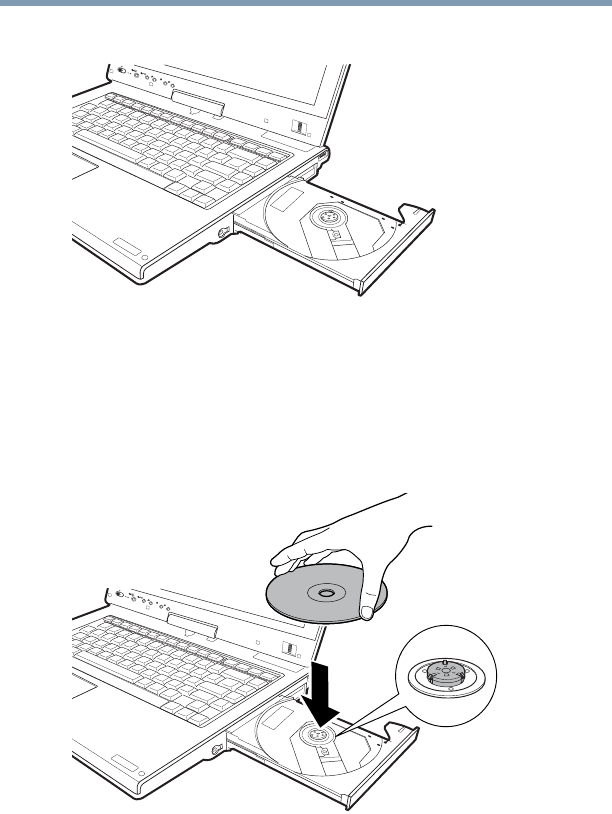
103
Learning the Basics
Using the optical drive
5.375 x 8.375 ver 2.3
4Grasp the tray and pull it fully open.
(Sample Illustration) Drive tray fully extended
5Hold the disc by its edges and check that it is free of dust.
If the disc is dusty, clean it as described in “Caring for
CD or DVD discs” on page 108.
6Place the disc carefully in the disc tray, label side up.
(Sample Illustration) Positioning the disc in the drive
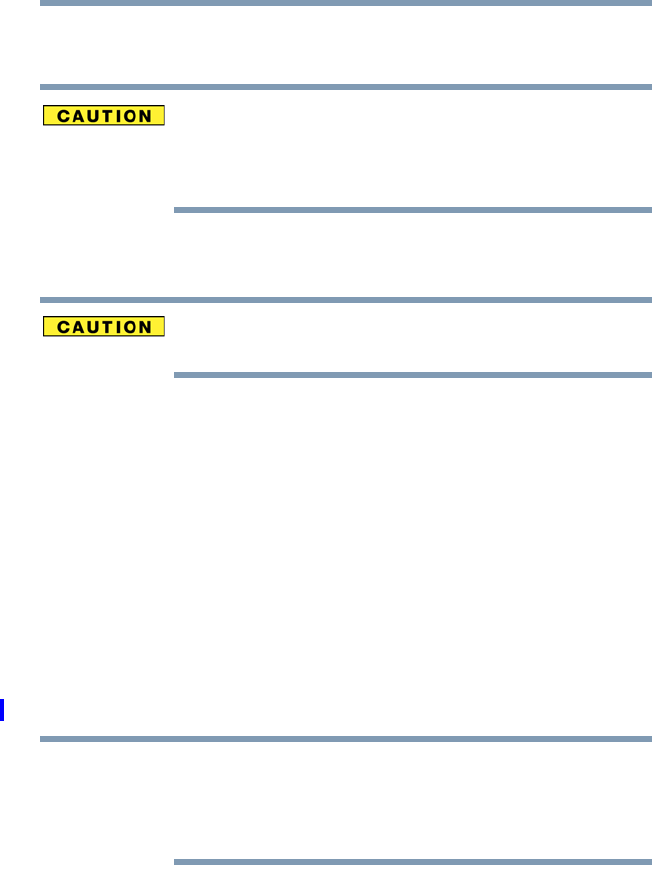
104 Learning the Basics
Using the optical drive
5.375 x 8.375 ver 2.3
7Gently press the disc onto the center spindle until it clicks
into place.
Handle DVDs and CDs carefully, making contact only with the
center hole and edge. Do not touch the surface of the disc. Do
not stack discs. If you incorrectly handle the discs, you could
lose data.
8Make sure the disc is completely on the spindle and is
lying flat on the tray.
If you insert the disc incorrectly, it may jam the drive. If this
happens, contact Toshiba support for assistance.
9Push the disc tray in by pressing gently on the center of
the tray until it clicks into place.
You are ready to use the disc.
Playing an audio CD
Insert an audio CD and close the disc tray.
If the computer is turned on, Windows Media® Player opens
and the CD begins to play. You can use the Windows Media
Player program to control the CD.
To access the Windows Media Player, you can open it
through the Start menu or activate it from the Taskbar.
When using Windows Media Player, your system may not be
able to activate Standby or Hibernation modes. To prevent this
from occurring, close Windows Media Player before you select
Standby or Hibernation mode.
NOTE
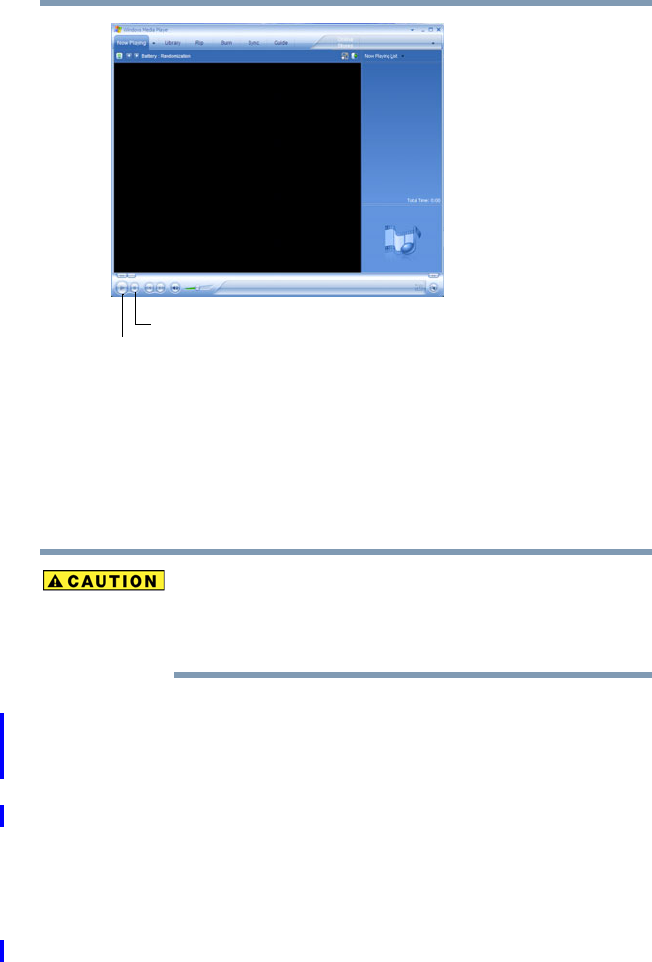
105
Learning the Basics
Using the optical drive
5.375 x 8.375 ver 2.3
(Sample Image) Windows Media Player screen
The Windows Media Player control panel works much like an
ordinary compact disc player:
❖To play the CD or to pause, click the Play/Pause button.
❖To stop the CD, click the Stop button.
Before putting on headphones to listen to an audio CD, turn
the volume dial down. Do not set the volume too high when
using headphones. Continuous exposure to loud sound can
harm your hearing.
Playing optical media
If you insert a CD/DVD into the optical drive and the Auto-
Run feature does not automatically start your disc, try
launching the CD/DVD manually. To do this, follow these
steps:
1Click Start, and then My Computer.
2Click the optical drive icon.
The disc drive will run the CD/DVD.
Stop button
Play/Pause button

106 Learning the Basics
Using the optical drive
5.375 x 8.375 ver 2.3
If your disc does not run using this method, try using an
application that is associated with the media on the disc. For
example, if it is a music CD, open Windows® Media Player
and use it to select and then play the CD. For other types of
media, use the associated software to open the files on the
disc.
Creating a CD/DVD
Depending on the configuration, your computer may come
with a multi-function drive that allows you to:
❖Play pre-recorded DVDs
❖Play pre-recorded CDs
❖Read and write data (depending on your system
configuration) and music files to CD-Recordable (CD-R)
and CD-Rewritable (CD-RW) discs; and DVD±R/±RW
or DVD RAM discs.
Due to manufacturing and quality variations in third party
optical media (e.g., CD or DVD) or optical media players/
recorders, in certain cases, your Toshiba optical drive may not
record on certain optical media that bear the applicable logo,
or play back optical media recorded by other computers or
optical media recorders. Additionally, certain optical media
recorded on your optical drive may not play back or operate
properly on other computers or optical media players. These
problems are not due to any defect in your Toshiba computer
or optical drive. Please refer to your computer's product
specification for listing of specific format compatibilities.
Copy protection technology may also prevent or limit
recording or viewing of certain optical media.
For details on how to use the software, please refer to the
respective Online Help menus.
NOTE
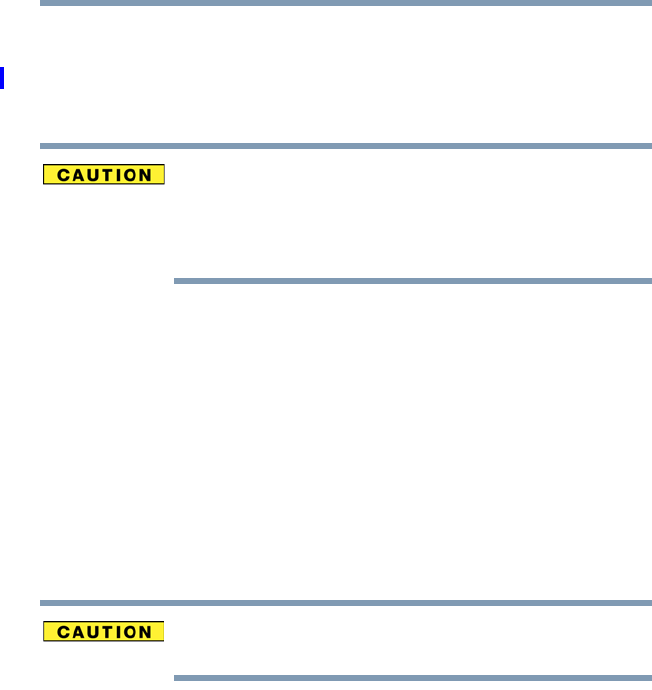
107
Learning the Basics
Using the optical drive
5.375 x 8.375 ver 2.3
Removing a disc with the computer on
To remove a disc (CD or DVD) with the computer turned on:
1Press the eject button on the drive.
Do not press the eject button while the in-use indicator light is
glowing. Doing so could damage the disc or the drive.
Also, if the disc is still spinning when you open the disc tray,
wait for it to stop spinning before you remove it.
2Pull the tray out until it is fully open, remove the disc,
and place it in its protective cover.
3Gently press the tray in to close it.
Removing a disc with the computer off
To remove a disc with the computer turned off:
1Insert a slender object, such as a straightened paper clip, into
the manual eject hole.
The disc tray slides partially out of the drive (about 1 inch).
Never use a pencil to press the manual eject button. Pencil
lead can break off inside the computer and damage it.
2Pull the tray out until it is fully open, remove the disc,
and place it in its protective cover.
3Gently press the tray in to close it.

108 Learning the Basics
Toshiba’s online resources
5.375 x 8.375 ver 2.3
Caring for CD or DVD discs
❖Store your discs in their original containers to protect
them from scratches and keep them clean.
❖Do not bend a disc or place heavy objects on top of it.
❖Do not apply a label to, or otherwise mar the surface of, a
disc.
❖Hold a disc by its outside edge. Fingerprints on the
surface can prevent the optical drive from reading the
data properly.
❖Do not expose discs to direct sunlight or extreme heat or
cold.
❖To clean a disc that is dirty, wipe it with a clean, dry
cloth. The most efficient method to clean it is to start
from the center of the disc and wipe toward the outward
edge (not in a circle). If necessary, moisten the cloth with
water or a neutral cleaner (not benzine or rubbing
alcohol). Let the disc dry completely before inserting it in
the drive.
Toshiba’s online resources
Toshiba maintains a number of online sites to which you can
connect. These sites provide information about Toshiba
products, give help with technical questions and keep you up
to date with future upgrades. For more information, see
“Contacting Toshiba” on page 252.

109
5.375 x 8.375 ver 2.3.2
Chapter 3
Mobile Computing
This chapter covers all aspects of using your computer while
traveling.
Toshiba’s energy-saver design
Your computer enters a low-power suspension mode when it
is not being used, thereby conserving energy and saving
money in the process. It has a number of other features that
enhance its energy efficiency.
Many of these energy-saving features have been set by
Toshiba. We recommend you leave these features active,
allowing your computer to operate at its maximum energy
efficiency, so that you can use it for longer periods while
traveling.
Running the computer on battery power
The computer contains a removable Lithium-Ion (Li-Ion)
high-capacity battery that provides power when you are away
from an AC outlet. You can recharge it many times.

110 Mobile Computing
Running the computer on battery power
5.375 x 8.375 ver 2.3.2
Battery Notice
Battery life may vary considerably from specifications
depending on product model, configuration, applications,
power management settings and features utilized, as well as
the natural performance variations produced by the design of
individual components. Published battery life numbers are
achieved on select models and configurations tested by
Toshiba at the time of publication. Recharge time varies
depending on usage. Battery may not charge while the
computer is consuming full power.
After a period of time, the battery will lose its ability to
perform at maximum capacity and will need to be replaced.
This is normal for all batteries. To purchase a new battery
pack, see the accessories information that shipped with your
computer or visit the Toshiba Web site at
accessories.toshiba.com. Use only batteries designed to work
with your Toshiba notebook computer.
To ensure that the battery maintains its maximum capacity,
operate the computer on battery power at least once a month
until the battery is fully discharged. Please see “Maximizing
battery life” on page 125 for procedures. If the computer is
continuously operated on AC power, either through an AC
adaptor or a docking station (if applicable to your system),
for an extended period (more than a month), the battery may
fail to retain a charge. This may shorten the life of the battery,
and the battery light may not indicate a low-battery condition.
For optimum DVD performance, it is recommended that you
play DVDs while running the computer on AC power. In
addition, your computer’s Power Saver utility can be used to
select a power level setting for DVD playback.
The computer also has an internal real-time-clock (RTC)
battery.
NOTE
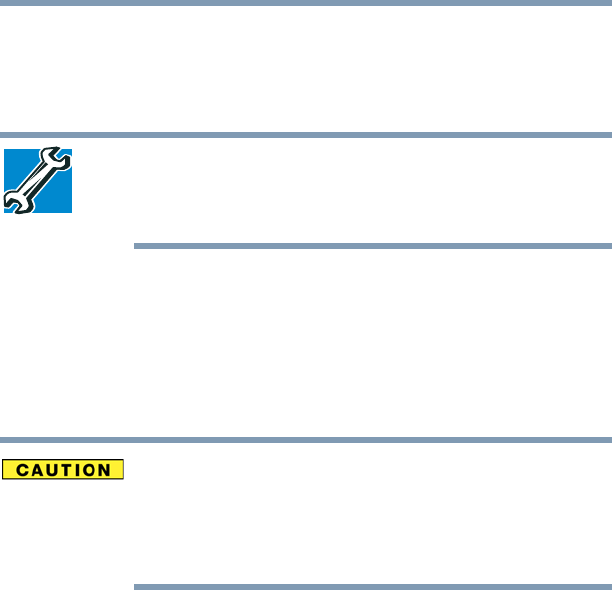
111
Mobile Computing
Running the computer on battery power
5.375 x 8.375 ver 2.3.2
The RTC battery powers the RTC memory that stores your
system configuration settings and the current time and date
information. It maintains this information for up to a month
while the computer is turned off.
TECHNICAL NOTE: The RTC battery does not charge while the
computer is turned off, even when AC power is attached.
The RTC battery charges only while the computer is powered on.
Power management
Your computer ships with the power management options
preset to a configuration that will provide the most stable
operating environment and optimum system performance for
both AC power and battery modes.
Changes to these settings may result in system performance
or stability issues. Users who are not completely familiar with
the power management component of the system should use
the preset configuration. For assistance with setup changes,
contact Toshiba’s Global Support Centre.
Using additional batteries
In addition to the main battery, you may also have an optional
second battery (not included with your computer). If you
travel and need to work for many hours without an AC power
source, you may purchase a battery module for use in the
computer, or carry additional charged battery packs with you.
You can then replace a discharged battery and continue
working.
For more information on batteries and accessories, see
accessories.toshiba.com.
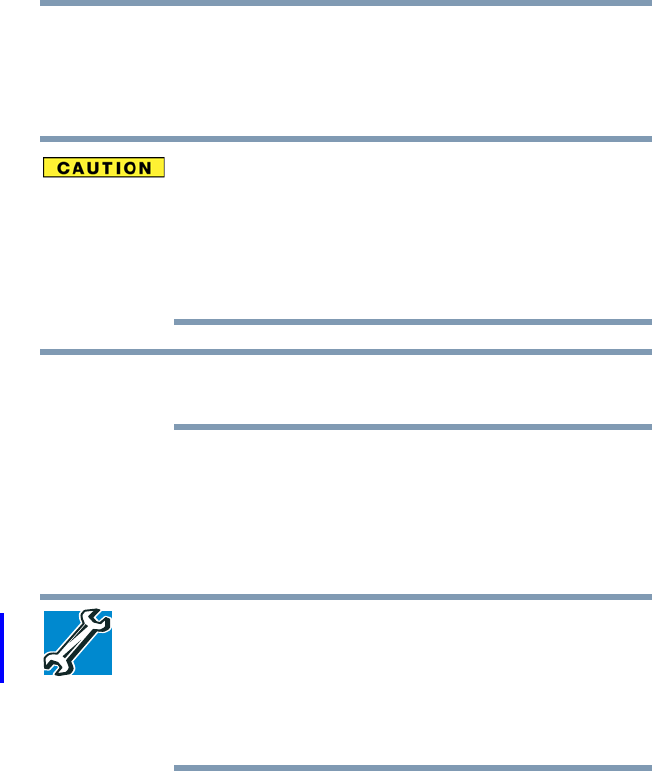
112 Mobile Computing
Charging batteries
5.375 x 8.375 ver 2.3.2
Charging batteries
The battery needs to be charged before you can use it to
power the computer.
Never leave batteries in the battery charger for more than a
week at a time. Doing so may reduce the potential charge of
the battery.
Always use the battery charger specified by Toshiba. You can
order a Toshiba battery charger from Toshiba’s Web site at
accessories.toshiba.com.
Battery charge time may vary depending on the applications,
power management settings, and features used.
Charging the main battery
To charge the main battery while it is in your computer, plug
the computer into a live electrical outlet. The battery charges
whether the computer is on or off.
TECHNICAL NOTE: The recharging of the battery cannot occur
when your computer is using all of the power provided by the
AC adaptor to run applications, features, and devices. Your
computer's Power Saver utility can be used to select a power
level setting that reduces the power required for system
operation and will allow the battery to recharge.
NOTE
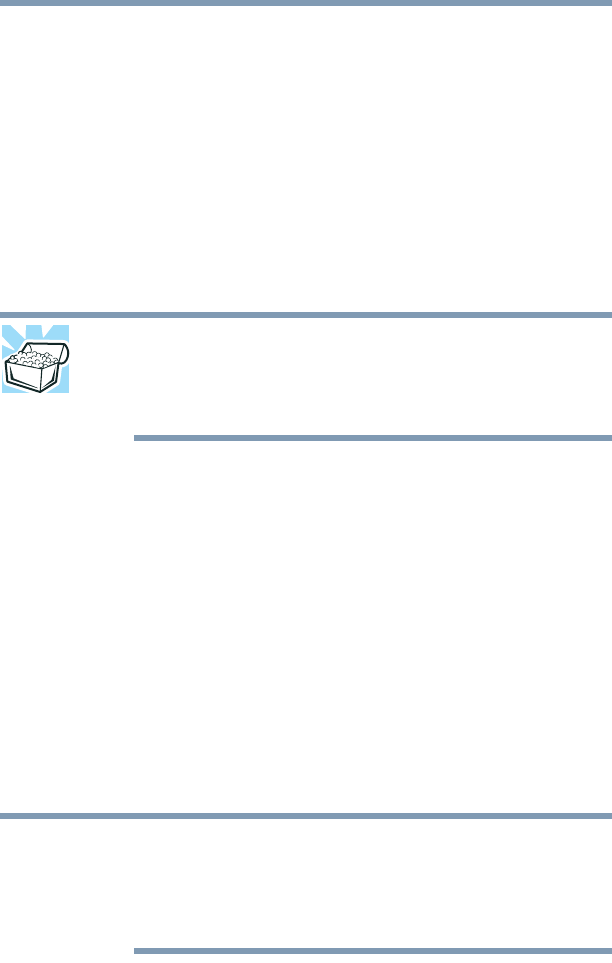
113
Mobile Computing
Charging batteries
5.375 x 8.375 ver 2.3.2
The battery may not start charging immediately under the
following conditions:
❖The battery is extremely hot or cold.
To ensure that the battery charges to its full capacity, wait
until it reaches room temperature (50 to 80 degrees
Fahrenheit, 10 to 26 degrees Celsius).
❖The battery is almost completely discharged.
Leave the power connected and the battery should begin
charging after a few minutes.
HINT: Once the battery is fully charged, we recommend that
you operate your computer on battery power until the battery
discharges completely. Doing this extends battery life and
helps ensure accurate monitoring of battery capacity.
Charging the RTC battery
Your computer has an internal real-time clock (RTC) battery.
The RTC battery powers the System Time Clock and BIOS
memory used to store your computer’s configuration settings.
When fully charged, it maintains this information for up to a
month when the computer is powered off.
The RTC battery may have become completely discharged
while your computer was shipped, resulting in the following
error message during startup:
BAD RTC BATTERY
BAD CHECKSUM (CMOS)
CHECK SYSTEM
The above error message may vary by computer model.
The RTC battery does not charge while the computer is turned
off even when the AC adaptor is charging the computer. The
RTC battery charges when the computer is powered on.
NOTE
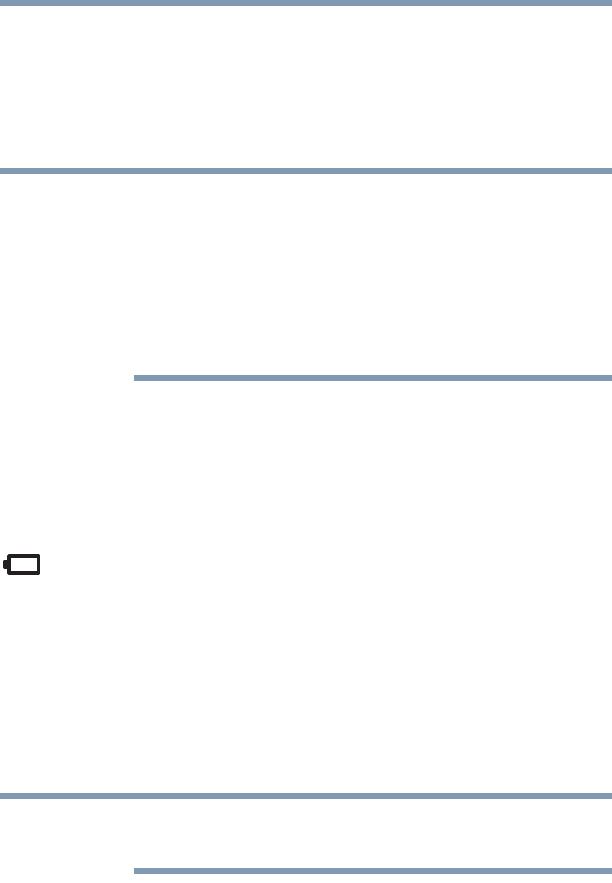
114 Mobile Computing
Monitoring main battery power
5.375 x 8.375 ver 2.3.2
If the RTC battery is low, the real-time clock and calendar
may display the incorrect time and date, or stop working.
To recharge the RTC battery, plug the computer into a live
electrical outlet and leave the computer powered on for 24
hours.
It is seldom necessary to charge the RTC battery because it
charges while the computer is on. If the RTC battery is low, the
real-time clock and calendar may display the incorrect time
and date or stop working.
When Hibernation mode is enabled and the RTC battery is
completely discharged, a warning prompts you to reset the
real-time clock.
The computer can be used while the RTC battery is being
charged, although the charging status of the RTC battery
cannot be monitored.
Monitoring main battery power
The computer’s main battery light gives you an indication of
the main battery’s current charge:
❖Glows amber while the main battery is being charged
(AC adaptor connected).
❖Glows green when the main battery is fully charged.
❖Is unlit when the battery has discharged, the battery is not
charging, or the AC adaptor is not plugged into the
computer or AC outlet.
Battery life and charge time may vary, depending upon power
management settings, applications and features used.
❖Flashes amber when the main battery charge is low and it
is time to recharge the main battery or plug in the AC
adaptor.
NOTE
NOTE
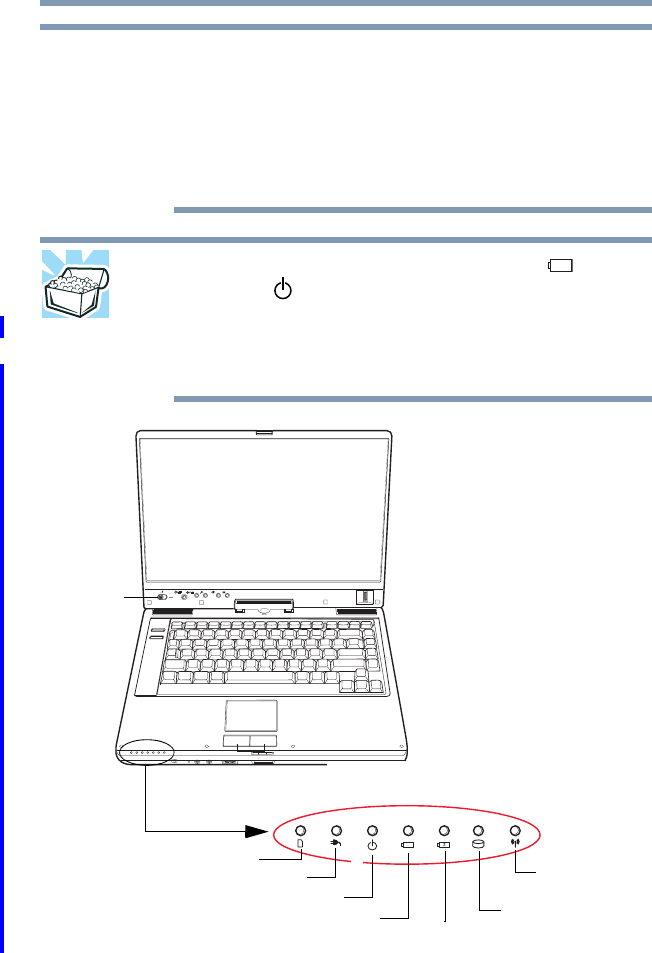
115
Mobile Computing
Monitoring main battery power
5.375 x 8.375 ver 2.3.2
If the AC power light flashes amber during charging, either the
battery pack is malfunctioning, or it is not receiving correct
input from the AC power supply.
Disconnect the AC power cord/cable and remove the battery
pack. See “Changing the main battery” on page 121 for
information on replacing the main battery.
HINT: Be careful not to confuse the battery light ( ) and the
on/off light ( ) (near the front-left edge of the keyboard).
When the on/off light flashes amber, it indicates that the
system is suspended (using the Windows® operating system
Standby command).
(Sample Illustration) Power and battery light locations
NOTE
Power
switch
System Indicator Lights
AC power light
Battery light Hard disk drive light
Bridge Media light
On/off light
Wireless indicator
light
Second battery light
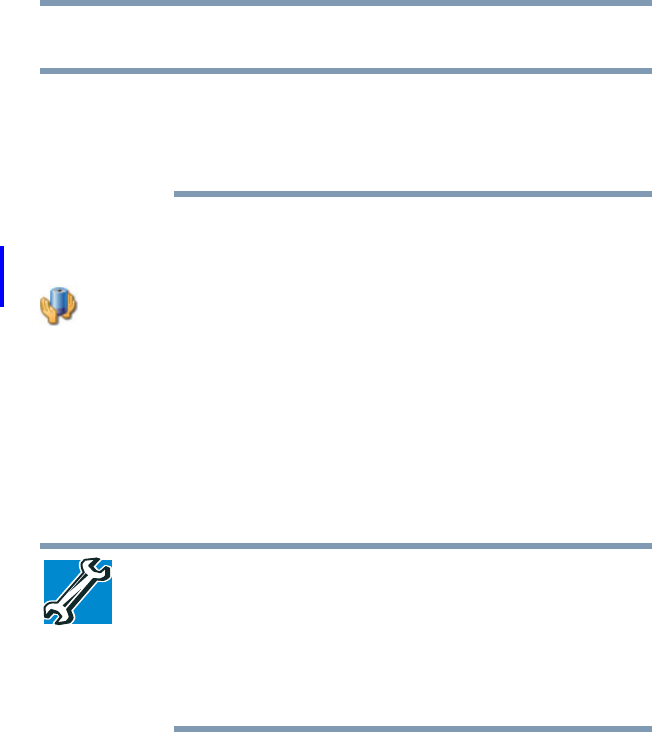
116 Mobile Computing
Monitoring main battery power
5.375 x 8.375 ver 2.3.2
Determining remaining battery power
Wait at least 16 seconds after turning on the computer before
trying to monitor the remaining battery power. The computer
needs this time to check the battery’s remaining capacity and
perform its calculations.
1Click Start, Control Panel, Performance and
Maintenance, and then TOSHIBA Power Saver.
2Click the TOSHIBA Power Saver icon.
The Power Saver Properties window appears.
The remaining battery charge is indicated on the left side
of the dialog box.
With repeated discharges and recharges, the battery’s
capacity gradually decreases. A frequently used older
battery does not power the computer for as long as a new
battery, even when both are fully charged.
TECHNICAL NOTE: The computer drains the battery faster at
low temperatures. Check your remaining charge frequently if
you are working in temperatures below 50 degrees Fahrenheit.
The computer calculates the remaining battery charge based
on your current rate of power use and other factors such as the
age of the battery.
NOTE

117
Mobile Computing
Monitoring main battery power
5.375 x 8.375 ver 2.3.2
What to do when the main battery runs low
When the main battery runs low you can:
❖Plug the computer into an external power source and
recharge the main battery
❖Place the computer into Hibernation mode and replace
the main battery with a charged spare
❖Connect the computer to an optional high capacity
battery (if available for your computer)
❖Save your work and turn off the computer
If you do not manage to do any of these things before the
main battery completely runs out of power, the computer
automatically enters Hibernation mode and turns itself off.
Hibernation mode keeps track of where you were, so that
when you turn on the power again, you can continue where
you left off.
If you have Hibernation mode enabled (the default), the
computer copies the details of your open programs and files
to the hard disk before shutting down. For more information
on using Hibernation, see “Hibernation mode” on page 76.
Setting battery alarms
You can set two alarms. Each alarm can be set to alert you
when a specified percentage of remaining battery power has
been reached. You can set how the warning occurs: sound an
alarm, display a message, both, or none. You can also set the
computer to enter Standby mode or Hibernation mode or to
completely power down when the alarm goes off.
To change the default alarm settings:
1Click Start, Control Panel, Performance and
Maintenance, and then TOSHIBA Power Saver.
2Click the Setup Action tab.
3Configure the Alarm settings to suit your needs.

118 Mobile Computing
Monitoring main battery power
5.375 x 8.375 ver 2.3.2
Conserving battery power
How long a fully charged battery pack lasts when you are
using the computer depends on a number of factors, such as:
❖How the computer is configured
❖How much you use the hard disk, optical drive, diskette
drives, or other optional devices
❖Where you are working, since operating time decreases at
low temperatures
There are various ways in which you can conserve power and
extend the operating time of your battery:
❖Enable Standby or Hibernation, which saves power when
you turn off the computer and turn it back on again
❖Use Toshiba’s power-saving options
These power-saving options control the way in which the
computer is configured. By using them, you can increase the
length of time you can use the computer before you need to
recharge the battery.
Toshiba has combined these options into preset Power
Profiles. Using one of these profiles lets you choose between
maximum power savings and peak system performance. You
may also set individual power-saving options to suit your own
needs.
The following sections describe how to choose a Power
Profile and discuss each power-saving option.
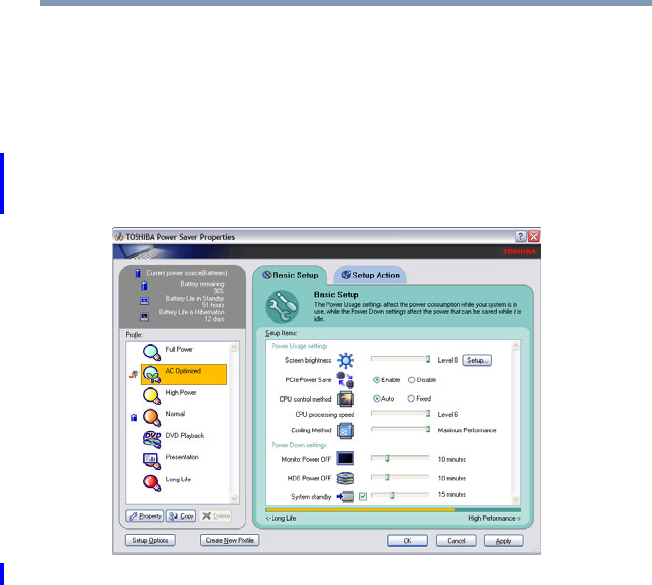
119
Mobile Computing
Monitoring main battery power
5.375 x 8.375 ver 2.3.2
Power Profiles
You can choose a predefined Power Profile or select your
own combination of power management options. To do this:
1Click Start, Control Panel, Performance and
Maintenance, and then TOSHIBA Power Saver.
The TOSHIBA Power Saver Properties window appears.
(Sample Image) TOSHIBA Power Saver Properties window
2Select an appropriate profile for your work environment
or create your own custom profile.
By changing the options that appear in the Power Saver
Properties dialog box and clicking OK, you can reconfigure
that function. You may choose a power-saving management
strategy to best suit your computing needs. If you are running
on batteries and the programs that you are using do not
require a lot of system resources, you may experience longer
work sessions by enabling the Normal setting. Any options
that you change become the active settings when you exit the
program. (You do not have to restart your system before they
become active settings.)
For more information, see “TOSHIBA Power Saver” on
page 178.
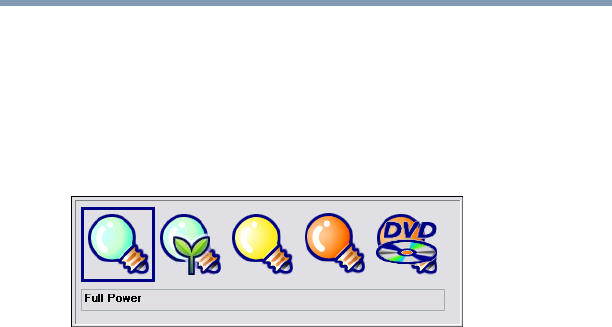
120 Mobile Computing
Monitoring main battery power
5.375 x 8.375 ver 2.3.2
Using a hot key to set the Power Profile
You may use a hot key to set the Power Profile.
To set the Power Profile:
1Press Fn and F2 simultaneously to display the Power
Profile pop-up window.
(Sample Image) Power Profile pop-up window
2While continuing to press Fn, press F2 until you select the
desired Power Profile.
The Power Profile options are: Full Power, High Power,
Normal, DVD Playback, Presentation, and Long Life.
3Release the Fn key.
The pop-up window disappears. You are now in the
selected mode.
For more information on setting the battery Power Profile,
see “TOSHIBA Power Saver” on page 178.
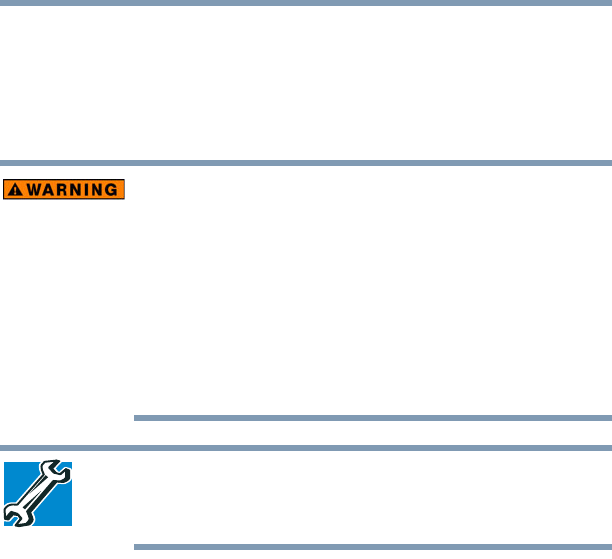
121
Mobile Computing
Changing the main battery
5.375 x 8.375 ver 2.3.2
Changing the main battery
When your main battery has run out of power, you have two
options: plug in the AC adaptor or install a charged main
battery.
Never short circuit the battery pack by either accidentally or
intentionally bringing the battery terminals in contact with
another conductive object. This could cause serious injury or
fire, and could also damage the battery pack and computer.
❖Never expose a battery pack to abnormal shock, vibration
or pressure. The battery pack's internal protective device
could fail, causing it to overheat or ignite, resulting in
caustic liquid leakage, or explosion or fire, possibly
resulting in death or serious injury.
TECHNICAL NOTE: To avoid losing any data, save your files
and then either completely shut down your computer or put it
into Hibernation mode before changing the main battery.
Removing the battery from the computer
To remove the battery:
1Save your work.
2Turn off the computer or place it in Hibernation mode
according to the instructions in “Using and configuring
Hibernation mode” on page 80.
3Unplug and remove any cables connected to the
computer, including the AC adaptor.
4Close the display panel and turn the computer upside
down.
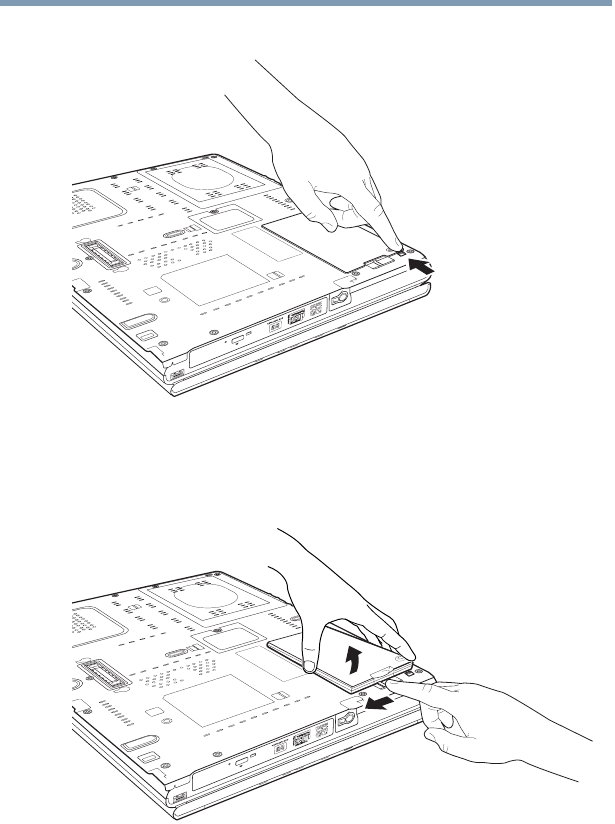
122 Mobile Computing
Changing the main battery
5.375 x 8.375 ver 2.3.2
5Slide the battery release lock to the unlocked position.
(Sample Illustration) Unlocking the battery release lock
6Slide the battery release latch to release the battery.
7Pull the discharged battery out of the computer.
(Sample Illustration) Removing the battery
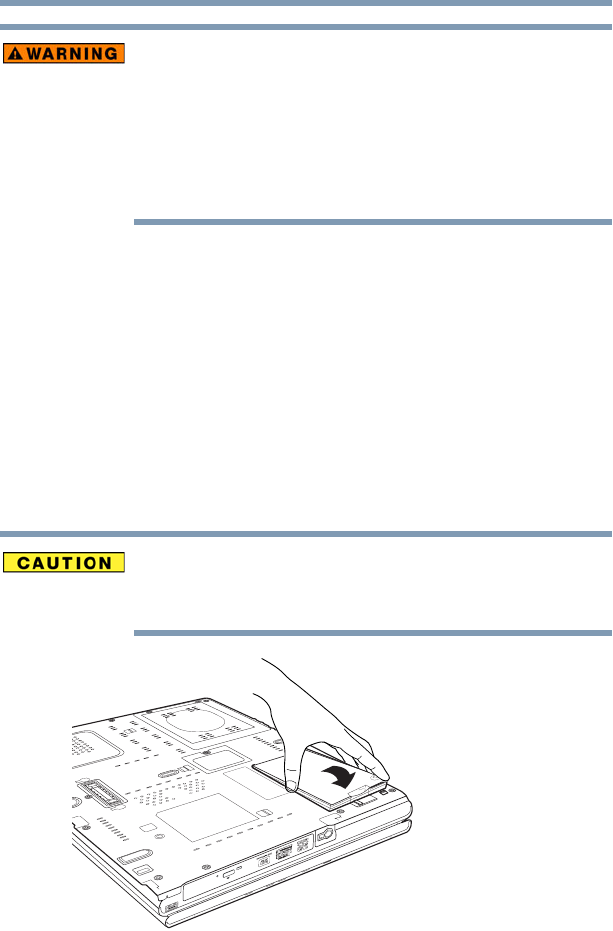
123
Mobile Computing
Changing the main battery
5.375 x 8.375 ver 2.3.2
If the battery is leaking or its case is cracked, put on protective
gloves to handle it, and discard it immediately. Always dispose
of used battery packs in compliance with all applicable laws
and regulations. Put insulating tape, such as cellophane tape,
on the electrode during transportation to avoid a possible
short circuit, fire or electric shock. Failure to do so could
possibly result in serious injury.
Inserting a charged battery
To insert a battery:
1Wipe the terminals of the charged battery with a clean
cloth to ensure a good connection.
2Insert the charged battery into the slot until the latch
clicks.
The battery pack has been designed so that you cannot
install it with reverse polarity.
If the battery does not slide into the slot easily, move the
battery release lock to the unlocked position and try again. Do
not force the battery into position.
(Sample Illustration) Inserting the battery
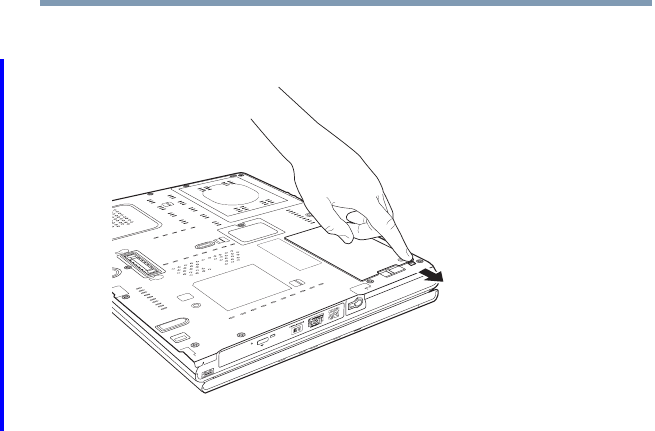
124 Mobile Computing
Taking care of your battery
5.375 x 8.375 ver 2.3.2
3Slide the battery lock to the locked position.
(Sample Illustration) Locking the battery release lock
4Turn the computer right side up.
5Reconnect any cables that were removed in step 3 of
“Removing the battery from the computer” on page 121.
6Restart the computer.
Taking care of your battery
The following sections offer tips on how to take care of your
battery and prolong its life.
Safety precautions
❖If the battery pack produces an odor, overheats or
changes color or shape while it is being used or charged,
turn off the computer’s power immediately and
disconnect the power cord/cable from the power socket.
Carefully remove the battery pack from the computer.
❖Do not try to disassemble a battery pack.

125
Mobile Computing
Taking care of your battery
5.375 x 8.375 ver 2.3.2
❖Do not overcharge or reverse charge a battery.
Overcharging will shorten its life, and reverse charging
could damage it.
❖Avoid touching the metal terminals of the battery with
another metal object. Short-circuiting the battery can
cause it to overheat and may cause damage to the battery
or the computer.
❖Do not incinerate a spent battery, as this could cause it to
explode and release caustic liquid.
❖If a battery is leaking or damaged, replace it immediately.
Use protective gloves when handling a damaged battery.
❖To replace the main battery, use an identical battery that
you can purchase through the Toshiba Web site at
accessories.toshiba.com.
❖A reverse polarity condition should be avoided with all
batteries. The main battery is designed so that it cannot
be installed in reverse polarity.
❖Charge the battery only in the computer or in a battery
charger designated as an approved option.
❖When you install the battery pack, you should hear a
click when it is seated properly.
❖Do not expose the battery pack to fire. The battery pack
could explode.
Maximizing battery life
To maximize the life of your battery pack:
❖At least once a month, disconnect the computer from a
power source and operate it on battery power until the
battery pack fully discharges. Before doing so, follow the
steps below:
1Turn off the computer’s power.
2Disconnect the AC adaptor and turn on the
computer’s power. If it does not turn on, go to step 4.

126 Mobile Computing
Taking care of your battery
5.375 x 8.375 ver 2.3.2
3Operate the computer on battery power for five
minutes. If the battery pack has at least five minutes
of operating time, continue operating until the battery
pack is fully discharged. If the battery light flashes or
there is some other warning to indicate a low battery,
go to step 4.
4Connect the AC adaptor to the computer and the
power cord/cable to a power outlet. The DC-IN or
AC power-light should glow green, and the battery
light should glow amber to indicate that the battery
pack is being charged. If the DC-IN or AC power-
light indicator does not glow, power is not being
supplied. Check the connections for the AC adaptor
and power cord/cable.
5Charge the battery pack until the battery light glows
green.
❖If you have extra battery packs, rotate their use.
❖If you will not be using the system for an extended
period, more than one month, remove the battery pack.
❖Disconnect the AC adaptor when the battery is fully
charged. Overcharging makes the battery hot and
shortens its life.
❖If you are not going to use the computer for more than
eight hours, disconnect the AC adaptor.
❖Store spare battery packs in a cool dry place out of direct
sunlight.
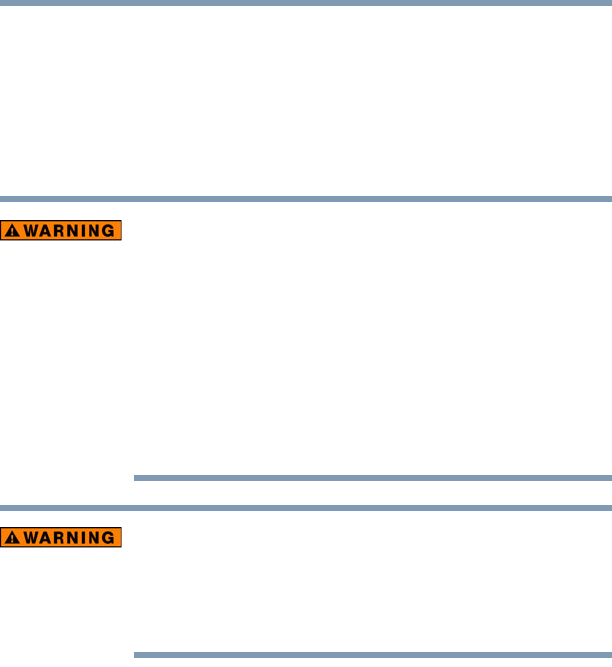
127
Mobile Computing
Disposing of used batteries
5.375 x 8.375 ver 2.3.2
Disposing of used batteries
The life of a battery pack depends on usage. When the battery
pack needs replacing, the main battery light flashes amber
shortly after you have fully recharged the battery.
You must discard a battery if it becomes damaged.
Never attempt to dispose of a battery pack by burning or by
throwing it into a fire, and never allow exposure to a heating
apparatus (e.g., microwave oven). Heat can cause a battery
pack to explode and/or release caustic liquid, both which may
possibly cause serious injury.
Always dispose of used battery packs in compliance with all
applicable laws and regulations. Put insulating tape, such as
cellophane tape, on the electrode during transportation to
avoid a possible short circuit, fire or electric shock. Failure to
do so could possibly result in serious injury.
Always use the battery pack supplied as an accessory or an
equivalent battery pack specified in the User's Manual. Other
battery packs have different voltage and terminal polarities.
Use of non-conforming battery packs could generate smoke or
cause fire or rupture, possibly resulting in serious injury.
After repeated use, the batteries will finally lose their ability
to hold a charge and you will need to replace them. Under
certain applicable laws and regulations, it may be illegal to
dispose of old batteries by placing them in the trash.
Please be kind to our shared environment. Check with your
local government authority for details regarding where to
recycle old batteries or how to dispose of them properly. If
you cannot find the information you need elsewhere, call
Toshiba at: (800) 457-7777.
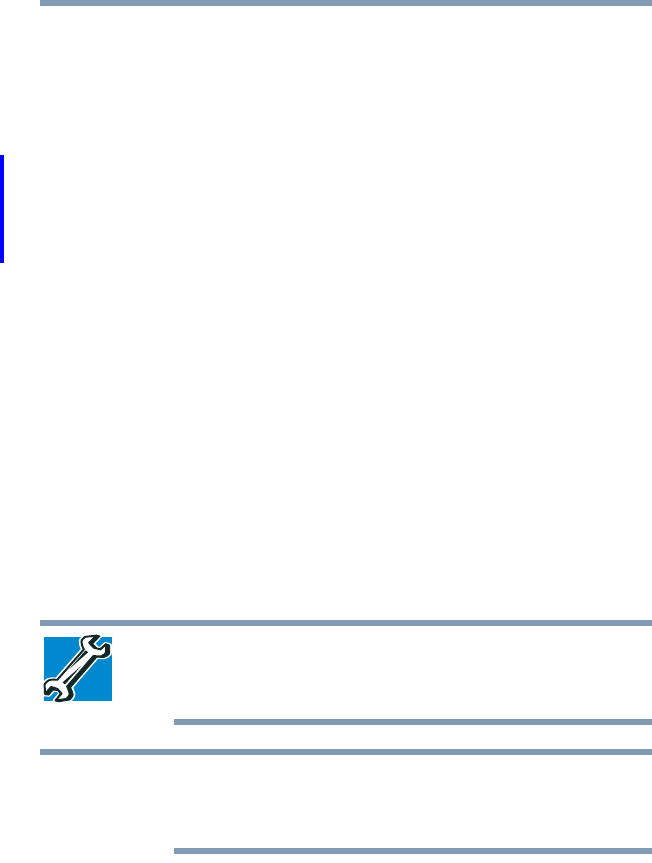
128 Mobile Computing
Traveling tips
5.375 x 8.375 ver 2.3.2
Toshiba is dedicated to preserving the environment by
sponsoring Call2Recycle, a program of the Rechargeable
Battery Recycling Corporation. For more information and for
drop-off locations, visit www.rbrc.org or call 1-800-822-
8837.
Notice regarding CR coin cell batteries, applicable to
California, U.S.A. only:
Perchlorate Material - special handling may apply. See
http://www.dtsc.ca.gov/hazardouswaste/perchlorate/
Traveling tips
The environmental precautions listed in “Selecting a place to
work” on page 40, also apply while traveling.
❖Never leave your computer on a sunny ledge or in a place
where it could get wet or covered in dust.
❖Always travel with the computer in a carrying case.
Toshiba offers a choice of carrying cases for the
computer. They all provide plenty of extra space for
manuals, power cords, and compact discs. Contact your
authorized Toshiba representative for more information
or visit Toshiba’s Web site at accessories.toshiba.com.
TECHNICAL NOTE: When traveling by air, you may be required
to pass your notebook through airport security equipment. The
X-ray equipment will not harm your computer.
Before using your computer aboard an aircraft, make sure the
Wi-Fi® switch is set to the Off position if your computer has
wireless LAN capability.
NOTE
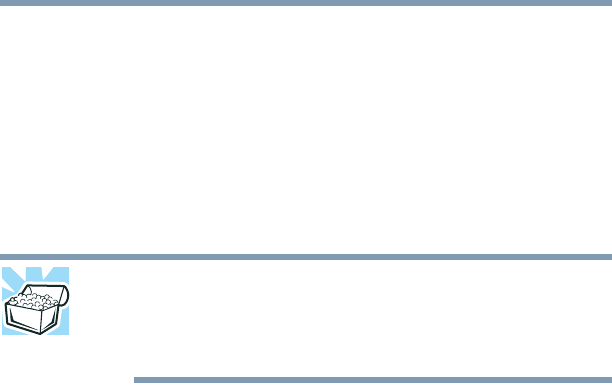
129
5.375 x 8.375 ver 2.3
Chapter 4
Exploring Your
Computer’s Features
In this chapter, you will explore some of the special features
of your notebook computer.
Exploring the desktop
The desktop is the launching pad for everything you can do in
the Windows® operating system. You use its features to start
programs, find documents, set up system components, and
perform most other computing tasks.
HINT: The illustrated examples in this guide may appear
slightly different from the screens displayed by your system.
The differences are not significant and do not indicate any
change in the functionality of your system.
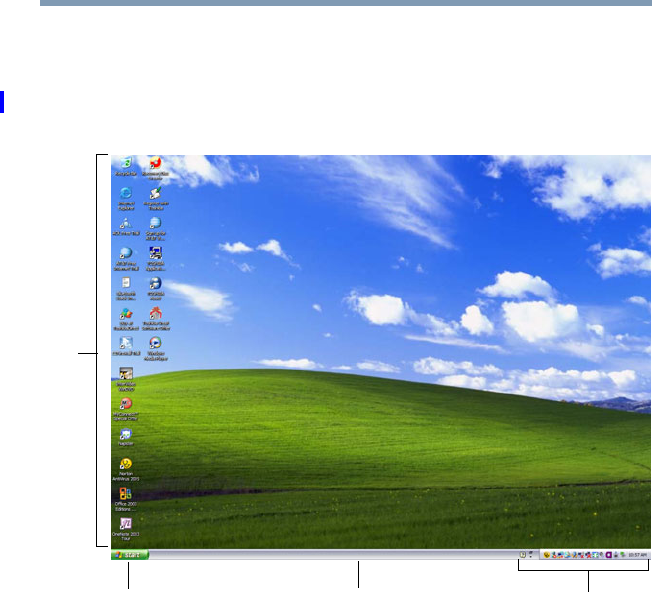
130 Exploring Your Computer’s Features
Exploring the desktop
5.375 x 8.375 ver 2.3
Finding your way around the desktop
Your computer’s desktop includes several standard features:
icons, Start button, Taskbar, System tray, and background
pattern.
(Sample Image) Windows® operating system desktop
Icons
An icon represents a folder, file, or program that can be
quickly activated by double-clicking the icon.
You can create a new desktop icon for any folder, file, or
program by dragging the element’s icon from its location in a
window to the desktop area.
Start button Taskbar
Icons
System tray
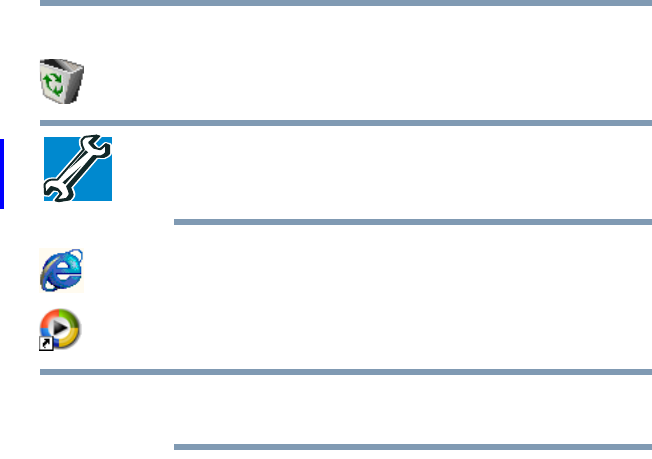
131
Exploring Your Computer’s Features
Exploring the desktop
5.375 x 8.375 ver 2.3
The icons initially displayed on your system desktop include:
Recycle Bin — Holds files you have deleted. You may be
able to retrieve these files until you empty the Recycle Bin.
TECHNICAL NOTE: If you delete a file from a diskette or flash
media, it does not go into the Recycle Bin. For more
information on the Recycle Bin, see Windows online Help.
Internet Explorer — The Microsoft® browser that provides
access to the Internet.
Windows® Media Player — Plays and organizes digital media
files on your computer and on the Internet.
If you place the cursor over an icon, a popup description of the
file contents appears.
Your desktop may contain other icons depending on your
configuration. See Windows® online Help for more specific
information on each icon and how to use it.
Start button
You use the Start button to:
❖Start programs
❖Access Microsoft® Windows® operating system update
❖Open documents
❖Adjust system settings
❖Find files
❖Access Windows® Help
❖Run programs
❖Suspend system activity and shut down the computer
NOTE

132 Exploring Your Computer’s Features
Setting up for communications
5.375 x 8.375 ver 2.3
Taskbar
Each time you open a program, a button associated with that
program appears on the Taskbar. With some programs, a
button appears on the Taskbar for each document or window
you open. You can use these buttons to quickly switch
between the programs or windows.
To make a program or window the currently active one, click
the associated Taskbar button.
System tray
The System tray displays icons of tasks or programs that run
continuously in the background. To learn more about each
task, position the cursor over the icon for a few moments and
a short description of the task appears.
Typical tasks in the System tray are Current time, Power
usage mode, Mouse properties, and speaker volume.
To activate a specific task, double-click the appropriate
System tray icon.
Setting up for communications
To connect to the Internet, use an online service, or
communicate across the telephone lines with another
computer, you need:
❖A modem (available on certain models)
❖A telephone line
❖A browser or communications program
❖An Internet Service Provider (ISP) or online service if
you plan to use the Internet

133
Exploring Your Computer’s Features
Setting up for communications
5.375 x 8.375 ver 2.3
Determining the COM port
Your modem (available on certain models) is connected to
one of the computer’s COM (communications) ports. The
default setting for the modem is COM3.
The following procedure is intended to support you if you
need to either upgrade your modem or reset the port to the
default settings.
If you are having trouble connecting through the modem, you
may need to determine the current COM port name and
possibly change it.
To find out which port your modem is connected to:
1Click Start, and then Control Panel.
2Click Printers and Other Hardware.
3Click Phone and Modem Options.
The Phone and Modem Options Properties dialog box
displays.
4Fill in the Local Information text boxes and click OK.
5Click the Modems tab.
Your modem should be listed next to one of the computer’s
COM ports.
6Make a note of the COM port number.
7To verify that the modem is set up properly, select the
modem you wish to check, and then click Properties to
bring up the dialog box with information specific to that
modem.
The Windows operating system communicates with the
modem and displays identifying information reported by
the modem. If the Windows operating system cannot
communicate with the modem, it displays an error
message. Consult the troubleshooting sections of your
modem and Windows operating system documentation.

134 Exploring Your Computer’s Features
Setting up for communications
5.375 x 8.375 ver 2.3
8Click OK to close the properties dialog box for that
specific modem.
9Click OK to close the Modem Properties dialog box.
10 Close the Control Panel.
Connecting the modem to a telephone line
Your computer may come with a built-in modem (available
on certain models) that can be connected to a standard voice-
grade telephone line.
The modem allows you to:
❖Access the Internet.
❖Communicate with your office’s local area network
(LAN) or larger corporate wide area network (WAN).
For specific information about connecting to a LAN or
WAN, consult your network administrator.
❖Send a fax directly from your computer.
For more detailed information regarding your computer’s
modem, visit Toshiba’s Web site at accessories.toshiba.com.
Before you can communicate using the modem, you need to
connect it to a telephone line. Your computer’s built-in
modem port provides an RJ-11 jack, allowing you to connect
the modem to a standard voice-grade telephone line.
1Plug one end of a telephone cable (purchased separately)
into the modem port on the right side of the computer.
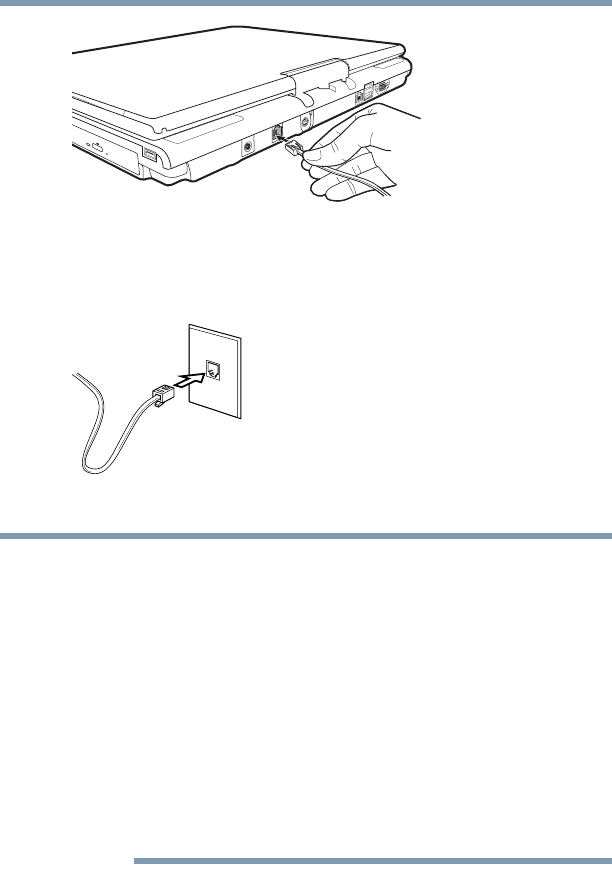
135
Exploring Your Computer’s Features
Setting up for communications
5.375 x 8.375 ver 2.3
(Sample Illustration) Connecting the telephone cable to the
modem port
2Connect the other end to the RJ-11 wall jack.
(Sample Illustration) Connecting to a wall jack
Connect the built-in modem only to ordinary analog phone
lines.
Never connect the built-in modem to a digital line
(ISDN).
Never connect the built-in modem to the digital
connector on a public telephone or to a digital private
branch exchange (PBX).
Never connect the built-in modem to a key telephone
system for residences or offices.
Connection to any communication line other than an analog
phone line could cause a computer system failure.
Now you are ready to send a fax or use the modem to connect
to an online service or the Internet.
NOTE

136 Exploring Your Computer’s Features
Setting up for communications
5.375 x 8.375 ver 2.3
Connecting your computer to a network
You can connect your computer to a network to increase its
capabilities and functionality using one of its communication
ports.
Accessing a network
To access a network:
❖At the office, connect an Ethernet cable to the RJ45 jack
on your computer. For specific information about
connecting to the network, consult your network
administrator.
❖While you are at home or traveling, you need a dial-up
connection. Ask your network administrator for the
telephone number of the network.
Setting up the connection
To set up an office connection, consult your network
administrator for network settings and additional
considerations.
To set up a dial-up connection, use the New Connection
Wizard:
1Click Start, and then All Programs.
2Click Accessories, Communications, and click New
Connection Wizard.
3Enter the phone number of your network connection and
let the program dial the number.
The computer connects to the network.

137
Exploring Your Computer’s Features
Setting up for communications
5.375 x 8.375 ver 2.3
How to disable the Ethernet LAN port
When your computer starts, Windows attempts to contact a
Dynamic Host Configuration Protocol (DHCP) server. If the
computer is not connected to a network, it may pause a few
minutes as it waits for a reply. To avoid this delay, you can
reconfigure Windows to disable the LAN port.
To disable the LAN port:
1Click Start, Control Panel, and then Performance and
Maintenance.
2Click the System icon, then click the Hardware tab, and
then click the Device Manager button.
3Select the appropriate network adapter.
4Click Actions.
5Select the Properties icon.
6Select the Do not use this device (disable) option from
the Device usage drop-down.
7Click OK.
Your LAN port is now disabled.
To enable the Ethernet LAN port, repeat steps one through
four. Select the Use this device (enable) check box, and click
OK.
Using Wireless LAN Connectivity
Wireless connectivity and some features may require you to
purchase additional software, external hardware or services.
Availability of public wireless LAN access points may be
limited.
NOTE
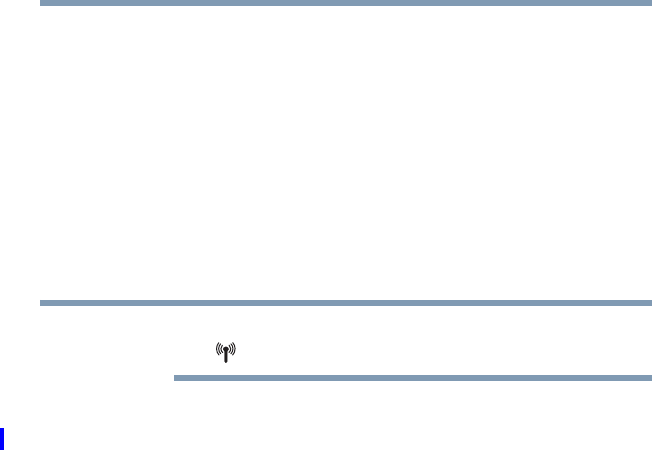
138 Exploring Your Computer’s Features
An overview of using the Internet
5.375 x 8.375 ver 2.3
Your system may come with an optional wireless LAN
module. This is a technology that expands wireless
communication beyond networking equipment, and can
connect many different kinds of electronic devices without
the need for cables.
For information on how to set up a wireless connection, refer
to your wireless networking device documentation or your
network administrator.
To use your wireless communication, slide the wireless on/off
switch to the On position.
When the Wi-Fi antenna switch is on, the wireless indicator
light will be lit.
For help with common Wi-Fi® networking problems, see
“Wireless networking problems” on page 238.
An overview of using the Internet
The following sections give a quick introduction to the
Internet and some of its exciting features, under these
headings:
❖The Internet
❖The World Wide Web
❖Internet Service Providers
❖Connecting to the Internet
❖Surfing the Internet
❖Internet features
❖Uploading to, and downloading files from, the Internet
NOTE

139
Exploring Your Computer’s Features
An overview of using the Internet
5.375 x 8.375 ver 2.3
The Internet
The Internet is an association of thousands of networks and
millions of computers around the world connected by
communications lines. They all work together to share
information.
The World Wide Web
The World Wide Web (or “Web”) is a subset of the Internet
— a collection of interlinked documents (located on
computers connected to the Internet) that work together using
a specific Internet protocol called Hypertext Transfer
Protocol (HTTP).
The World Wide Web offers information as text, images,
audio, or video to be referenced from anywhere in the world.
Special programs called Web browsers are specifically
designed to work with HTTP. They make it easier to connect
to a particular network address and send and receive
information.
Internet Service Providers
To connect a computer directly to the Internet, many people
and businesses use an Internet Service Provider (ISP). An ISP
is a company that has the equipment and the
telecommunication lines necessary to maintain an Internet
connection.
You can connect to the Internet by using a telephone and
modem or through other higher-speed communication
methods such as Digital Subscriber Lines (DSL), cable, and
satellite links.
Connecting to the Internet
To connect to the Internet, you need:
❖A modem and telephone line, or a LAN connection
❖A Web browser

140 Exploring Your Computer’s Features
An overview of using the Internet
5.375 x 8.375 ver 2.3
❖An Internet Service Provider (ISP) account
The Microsoft® Web browser Internet Explorer is
automatically configured on your system so that when you
first start it, it guides you through signing up for a new ISP
account, or assists you in setting up your computer to work
with your existing ISP.
Once you have established an ISP account, you can connect
to the Internet.
1Connect your computer’s modem to a telephone line.
For more information on connecting a modem, see
“Connecting the modem to a telephone line” on
page 134.
2Start your Web browser. Have your modem dial the ISP’s
telephone number, and establish a connection with the
ISP’s computer.
If you are using your computer at the office, then you
probably connect to the Internet through your company’s
network. See your network administrator about connecting to
the Internet.
Surfing the Internet
Once connected to the Internet, the Web browser displays a
home page, for example, your ISP’s home page on the
Internet or your company’s Web site home page.
To visit a desired Web site, type in the Web address. The Web
address, or Uniform Resource Locator (URL), is a unique
identifier for that computer system linked to the Internet. Web
addresses can also appear within a Web page’s text, and are
known as links. Clicking a link automatically transfers your
Web browser to that site.
You can also use a Search Engine, a Web site specifically
designed to help you look for information.

141
Exploring Your Computer’s Features
An overview of using the Internet
5.375 x 8.375 ver 2.3
Internet features
The Internet offers many types of communication tools to
help you perform many tasks.
❖Internet email
To send and receive email of your own, you need a
mailbox on the Web or an email address.
If you have an account with an ISP, you can probably set
up an email address at the same time you sign up for the
service.
❖Internet chat rooms
A chat room is a Web site that offers a place where
people with similar interests and ideas communicate in
real-time, one-on-one or in groups, by typing messages
which are instantly viewed by others on their computer
screens.
❖Internet news groups
A news group is similar to a chat room, but instead of
using a dedicated site to converse about a specialized
subject with others in real-time, it uses a Web site as a
clearinghouse where all the messages are placed, like a
gigantic bulletin board.
❖Online shopping
Many Web sites offer products and services for sale.
Uploading to, and downloading files from, the Internet
Transferring files from one computer to another is termed
uploading (transferring data from your computer to a site on
the Web), or downloading (transferring data from a site on the
Web to your computer).
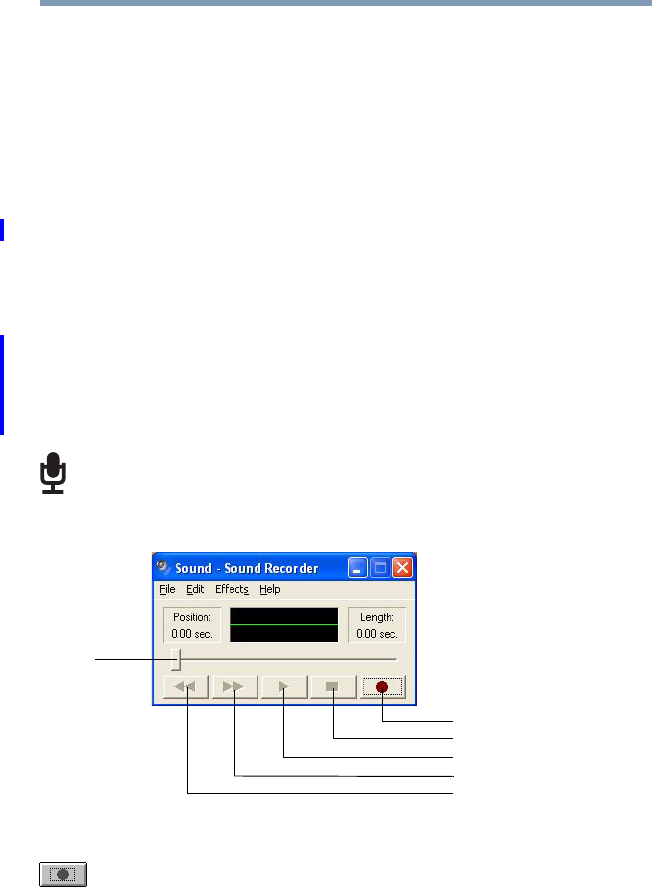
142 Exploring Your Computer’s Features
Exploring audio features
5.375 x 8.375 ver 2.3
There are several ways to upload or download data. It can be
as simple as attaching a file or document to an email, or you
can use the File Transfer Protocol (FTP) features of your Web
browser to transfer large amounts of data.
Exploring audio features
You can use your computer to record sounds using an
external microphone. You can play sound files or audio CDs
using the built-in speakers, headphones, or external speakers.
Recording sounds
You may record sounds by connecting an optional external
microphone or other sound source to the microphone jack.
Using a microphone
1Connect an external microphone to the computer.
2Click Start, All Programs, Accessories,
Entertainment, and then Sound Recorder.
(Sample Image) Sound Recorder screen
3Click the Record button.
4Speak normally into the microphone.
Record
Stop
Play
Skip forward
Skip backward
Positioning
bar
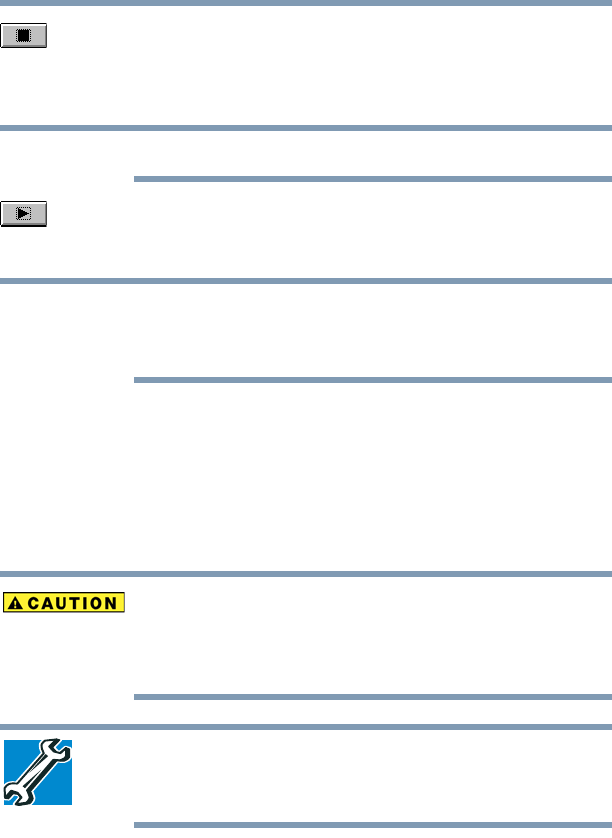
143
Exploring Your Computer’s Features
Exploring audio features
5.375 x 8.375 ver 2.3
5When you have finished recording, click the Stop button.
The Sound Recorder window displays the new sound file
as a waveform.
You can only record 60 seconds at a time.
6To hear what you just recorded, click the Play button.
7To save the file, select Save from the File menu.
The microphone on your computer might be set to Mute. To
check this, click Start, All Programs, Accessories,
Entertainment, and then Volume Control.
Using external speakers or headphones
Your computer is equipped with a full stereo sound system
with internal speakers. Instead of using the internal speakers,
you can connect headphones or a pair of external stereo
speakers.
Before putting on headphones to listen to an audio CD, turn
the volume dial down. Do not set the volume too high when
using headphones. Continuous exposure to loud sound can
harm your hearing.
TECHNICAL NOTE: Use amplified speakers that require an
external power source. Other types of speakers will be
inadequate to produce sound from the computer.
NOTE
NOTE
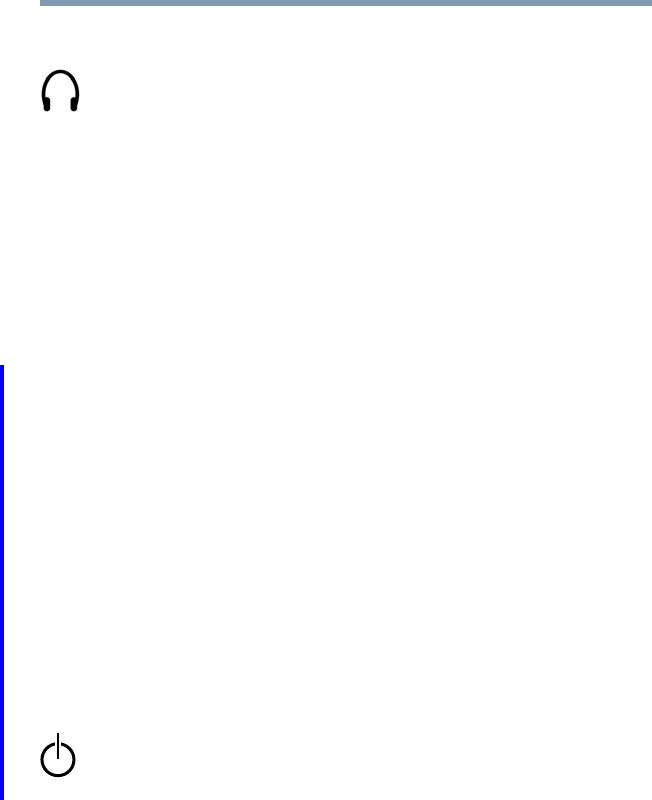
144 Exploring Your Computer’s Features
Using tablet mode
5.375 x 8.375 ver 2.3
To play back sound files through external speakers or
headphones:
1Locate the headphone jack on the computer.
2Using any necessary adapters, plug the cable from the
headphones or external speakers into the headphone jack.
The headphone jack requires a 16-ohm stereo mini-jack.
To adjust the volume:
❖For external speakers, use the volume controls on each
speaker.
❖For headphones, use the computer’s volume control dial.
Using tablet mode
One of your computer’s features is a convertible display that
allows you to use the screen much as you would a writing
tablet.
Your computer came with applications already installed
specifically designed to work with the tablet feature of the
system. For more information on those applications, see the
documentation provided with them.
Preparing to use the tablet
1Press the display panel release button and lift the display
panel.
2Slide the power switch to the left and hold it until the on/
off light on the system indicator panel glows green,
depending on your model—about one second.
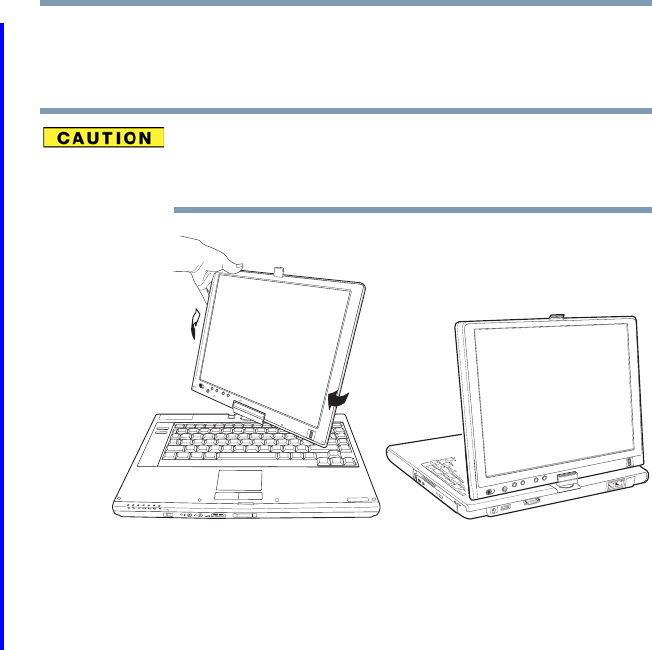
145
Exploring Your Computer’s Features
Using tablet mode
5.375 x 8.375 ver 2.3
3Rotate the display panel clockwise 180o (degrees). When
you complete this task, the screen faces away from the
keyboard.
When rotating LCD screen of your computer, be sure to slowly
turn the screen in the proper direction, and not apply excessive
force or speed.
(Sample Illustration) Rotating the display panel clockwise
180o
4Turn the display latch so it points toward the back of the
LCD screen.
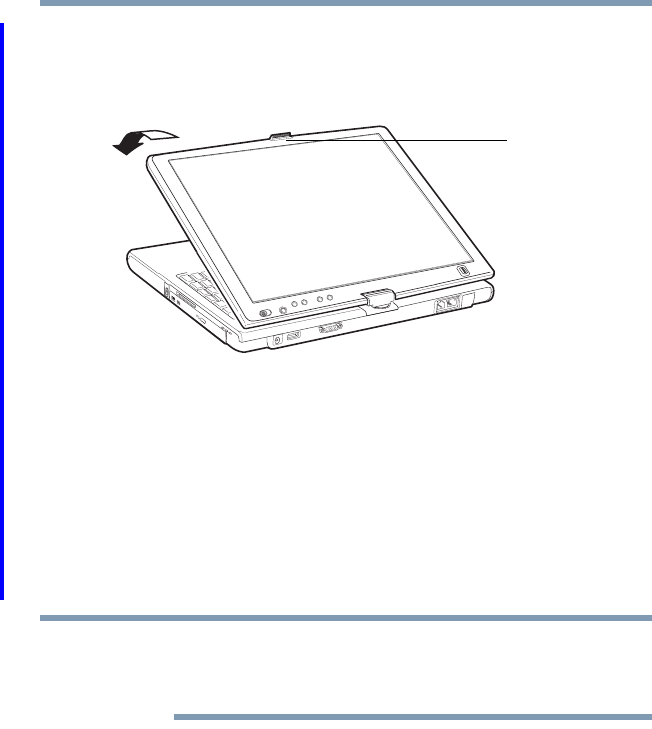
146 Exploring Your Computer’s Features
Using tablet mode
5.375 x 8.375 ver 2.3
5Fold the display panel down flat over the keyboard.
The display latch will click and lock the screen in tablet
position.
(Sample Illustration) Folding the display panel down flat
By default, the computer desktop will automatically rotate to
primary portrait view. For more information on changing
tablet screen settings, see “TOSHIBA Rotation Utility” on
page 184.
6To send the video to an external monitor, use the Cross
Menu button (the Cross-Functional button) and select the
display option.
You should view video on an external monitor in primary
landscape mode. Any other orientation will display the external
video resolution incorrectly.
Display latch
NOTE
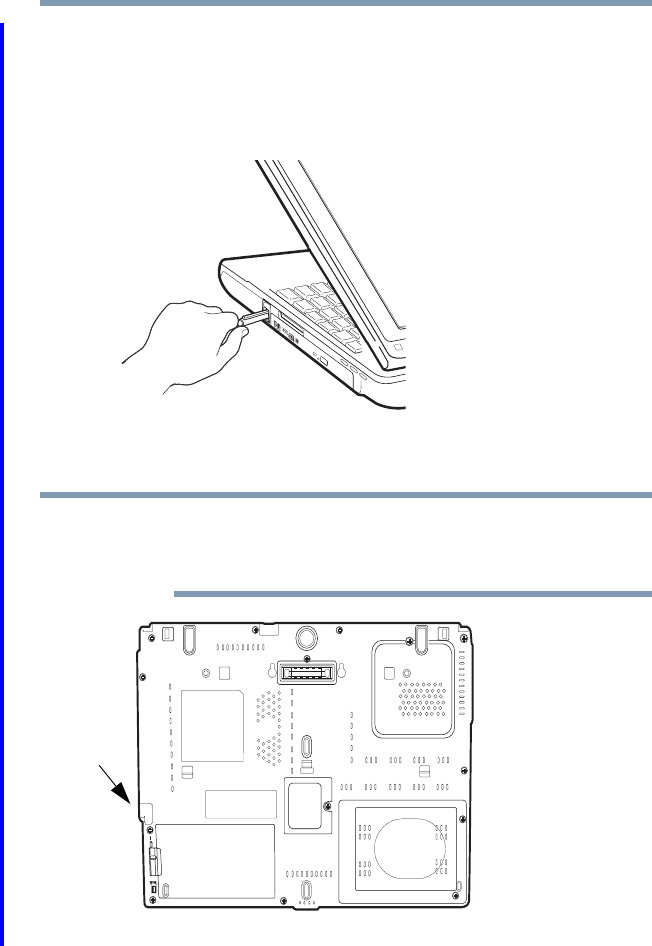
147
Exploring Your Computer’s Features
Using tablet mode
5.375 x 8.375 ver 2.3
Using tablet mode
1Remove the Toshiba tablet pen which is located on the right
side of the computer by momentarily pressing in on the pen
and then releasing it. Pull the pen from the holder.
(Sample Illustration) Removing the Toshiba tablet pen from
the slot on the tablet computer
To protect the computer’s display, make sure you change from
tablet mode to computer mode and close the display before
you turn the computer upside down.
(Sample Illustration) Location of the pen and pen holder
NOTE
Location of the
pen holder
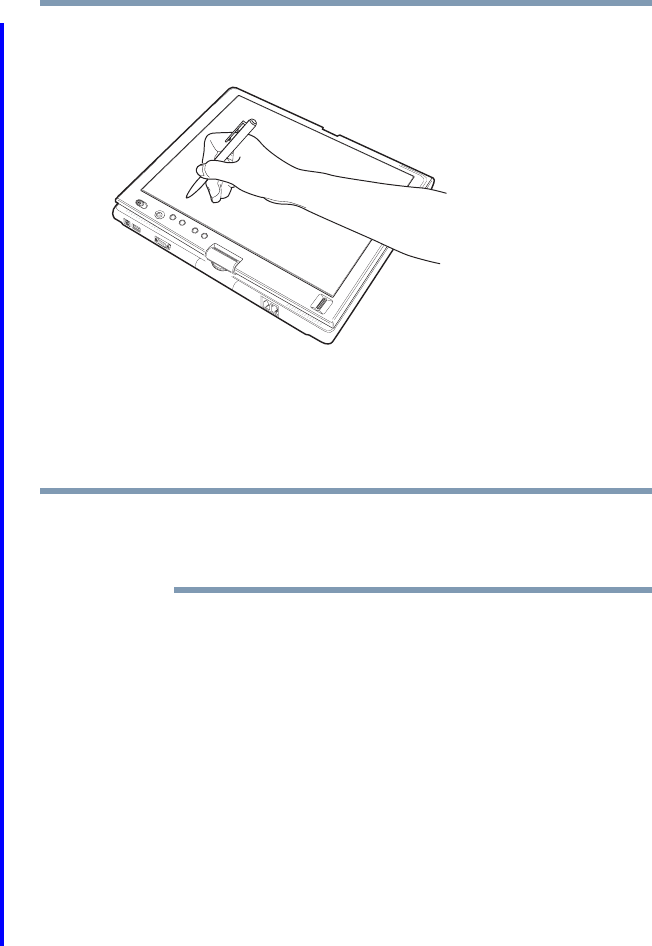
148 Exploring Your Computer’s Features
Using tablet mode
5.375 x 8.375 ver 2.3
2Use the Toshiba tablet pen on the tablet as you would any
pointing device or pen.
(Sample Illustration) Writing on the tablet
To learn how to manually change the layout of the screen
from portrait to landscape, see “TOSHIBA Rotation Utility” on
page 184.
You can also use tablet mode when the computer is in its
original configuration, with the screen open and facing the
keyboard.
Using the Toshiba tablet pen
Use the Toshiba tablet pen as you would a mouse, or other
pointing device. For example, you can execute “mouse type”
commands in the same manner you normally would:
❖To move the pointing icon (or cursor) on the tablet,
simply drag the Toshiba tablet pen across the tablet.
❖To click a button, gently press the Toshiba tablet pen on it
(one click).
❖To launch an application from the desktop, press the
Toshiba tablet pen on the icon (some applications may
require you to press it twice—two clicks).
NOTE
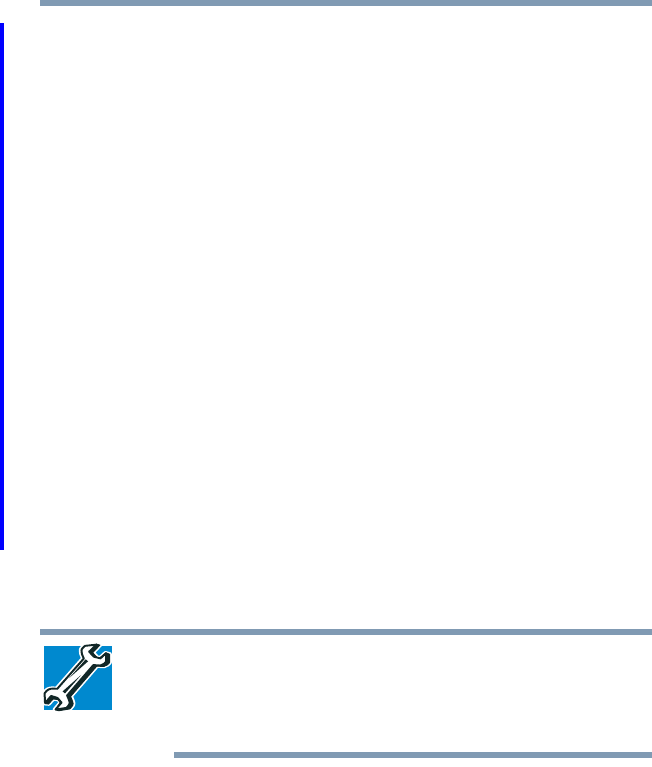
149
Exploring Your Computer’s Features
Using PC Cards
5.375 x 8.375 ver 2.3
❖To drag a window to another location on the tablet, press
the Toshiba tablet pen on the window's Title Bar, and
then hold it while you drag it to its new location.
When working in an application, you can use the Toshiba
tablet pen like a pen and simply draw or write directly onto
the tablet’s work space.
Returning the computer to its original configuration
When you are finished using the tablet, follow the steps
below to return the computer to its original configuration:
1Return the Toshiba tablet pen to its slot on the right side of the
computer.
2Press the display latch release button.
3Lift the display panel to its upright position.
4Rotate the display panel counter-clockwise 180o. When
you complete this task, the screen returns to its normal
position facing the keyboard.
5Turn the display latch toward the LCD screen.
Using PC Cards
TECHNICAL NOTE: For PCMCIA-compatible PC Cards, check
the package to make sure they conform to the PCMCIA 2.1
standard (or later). Other cards may work with your computer,
but are likely to be much more difficult to set up and use.
Your notebook computer comes with a PC Card slot and
supports two types of PC Cards that you can install:
❖Type I cards
❖Type II cards
The PC Card slot supports hot swapping, which allows you to
replace one PC Card with another while the computer is on.
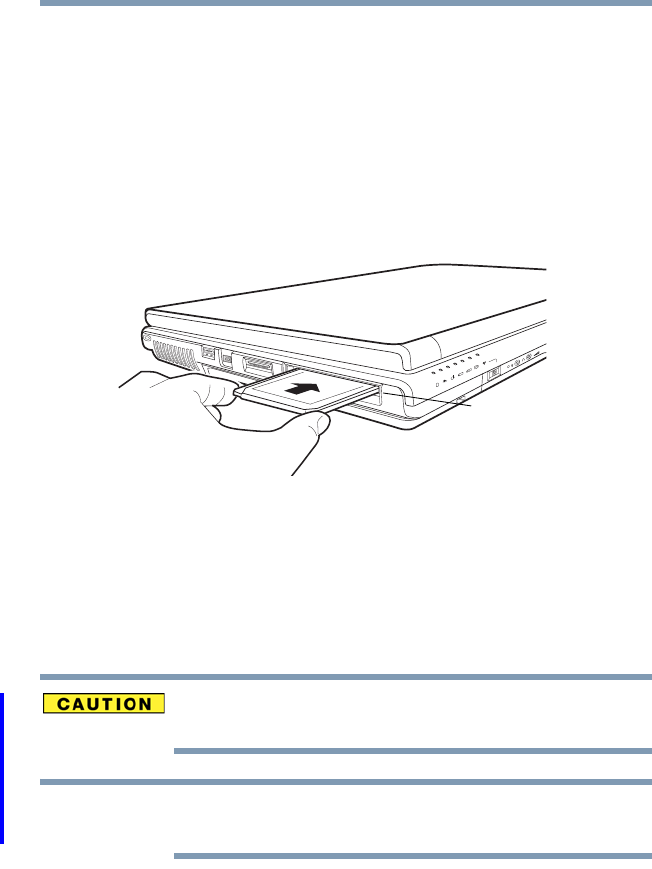
150 Exploring Your Computer’s Features
Using PC Cards
5.375 x 8.375 ver 2.3
Inserting a PC Card
Before you insert a PC Card, refer to the documentation that
comes with the card to see if you need to do anything before
you insert it.
To insert a PC Card:
1Locate the PC Card slot on the left side of the computer.
2Insert the PC Card.
(Sample Illustration) Inserting a PC Card
3When the card is almost all the way into the slot, push
firmly but gently to ensure a firm connection with the
computer. Do not force the card into position.
Removing a PC Card
Be sure to disable the PC Card prior to removing it. Otherwise,
the system may be damaged.
Before removing a PC Card, make sure that no applications or
system services are using the card.
PC Card slot
NOTE